Xplore Technologies I6205-XPL INTEL CENTRINO ADVANCED-N 6205 User Manual ix104c5 handbook
Xplore Technologies INTEL CENTRINO ADVANCED-N 6205 ix104c5 handbook
Contents
- 1. Users Manual
- 2. Users Handbook
Users Handbook
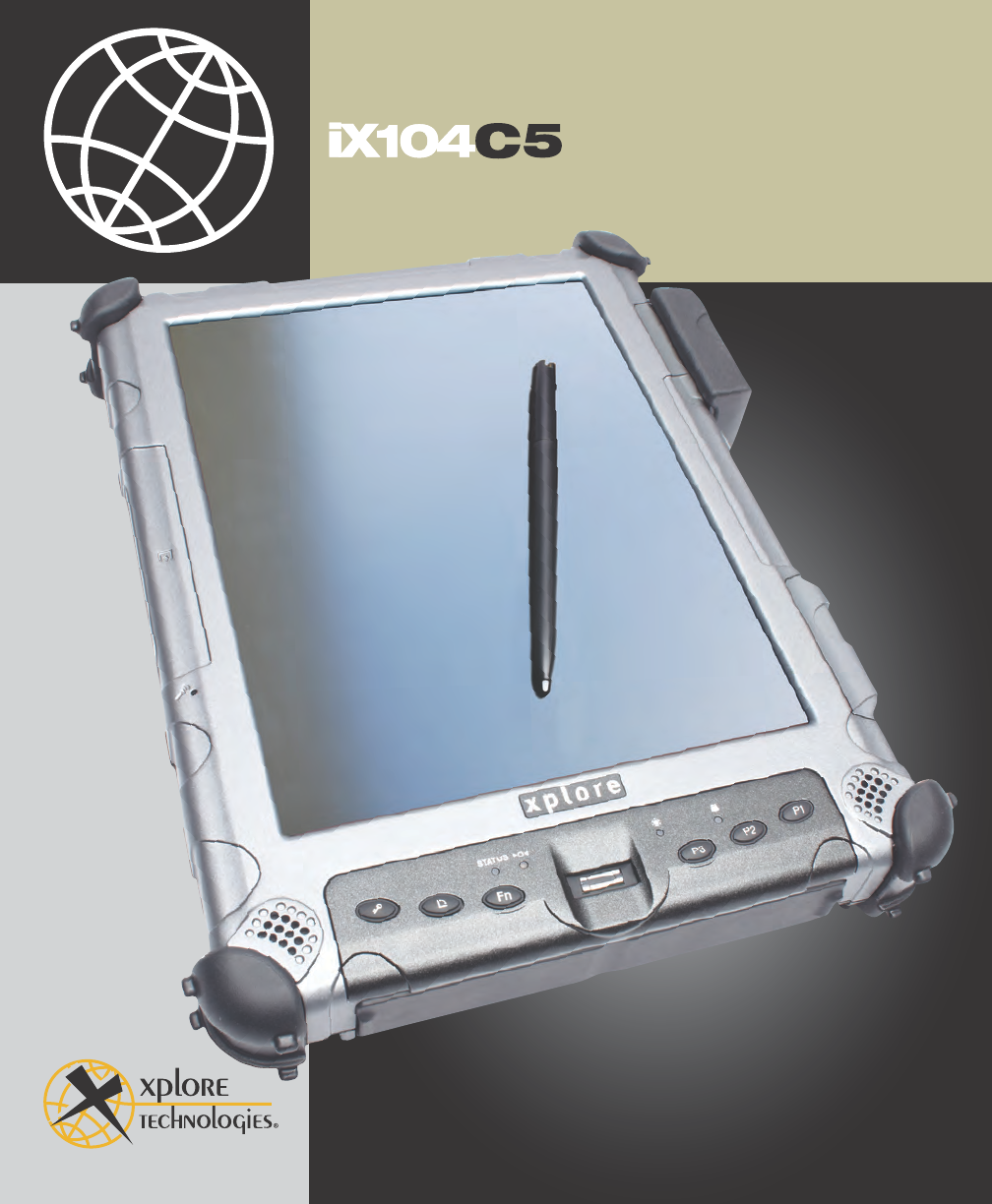
USER’S HANDBOOK

iX104C5 User’s Handbook 3
Contents
Welcome 13
About your computer . . . . . . . . . . . . . . . . . . . . . . . . . . . . . . . . . . . . . . . . . . . . . . 14
Package contents . . . . . . . . . . . . . . . . . . . . . . . . . . . . . . . . . . . . . . . . . . . . . . . . . . 15
Optional accessories. . . . . . . . . . . . . . . . . . . . . . . . . . . . . . . . . . . . . . . . . . . . 15
Contacting Xplore – service and questions. . . . . . . . . . . . . . . . . . . . . . . . . . . . . . 17
1Getting Started 19
Front view . . . . . . . . . . . . . . . . . . . . . . . . . . . . . . . . . . . . . . . . . . . . . . . . . . . . . . . 19
Back view . . . . . . . . . . . . . . . . . . . . . . . . . . . . . . . . . . . . . . . . . . . . . . . . . . . . . . . 20
Left side view . . . . . . . . . . . . . . . . . . . . . . . . . . . . . . . . . . . . . . . . . . . . . . . . . . . . 21
Right side view . . . . . . . . . . . . . . . . . . . . . . . . . . . . . . . . . . . . . . . . . . . . . . . . . . . 22
Bottom view . . . . . . . . . . . . . . . . . . . . . . . . . . . . . . . . . . . . . . . . . . . . . . . . . . . . . 23
Top view . . . . . . . . . . . . . . . . . . . . . . . . . . . . . . . . . . . . . . . . . . . . . . . . . . . . . . . . 23
LED indicators . . . . . . . . . . . . . . . . . . . . . . . . . . . . . . . . . . . . . . . . . . . . . . . . . . . 24
Quick-start guide . . . . . . . . . . . . . . . . . . . . . . . . . . . . . . . . . . . . . . . . . . . . . . . . . . 26
Application, Windows, and hot keys . . . . . . . . . . . . . . . . . . . . . . . . . . . . . . . 26
2Using the Tablet 29
Turning on the computer. . . . . . . . . . . . . . . . . . . . . . . . . . . . . . . . . . . . . . . . . . . . 29
Turning off the computer . . . . . . . . . . . . . . . . . . . . . . . . . . . . . . . . . . . . . . . . . . . 30
Using the Reset switch. . . . . . . . . . . . . . . . . . . . . . . . . . . . . . . . . . . . . . . . . . 30
Suspending and resuming operation . . . . . . . . . . . . . . . . . . . . . . . . . . . . . . . . . . . 31
Suspending operation. . . . . . . . . . . . . . . . . . . . . . . . . . . . . . . . . . . . . . . . . . . 32
Resuming operation . . . . . . . . . . . . . . . . . . . . . . . . . . . . . . . . . . . . . . . . . . . . 33

Contents
4 iX104C5 User’s Handbook
Using the pen. . . . . . . . . . . . . . . . . . . . . . . . . . . . . . . . . . . . . . . . . . . . . . . . . . . . . 34
Using the digitizer to perform mouse functions. . . . . . . . . . . . . . . . . . . . . . . 35
Changing the pen double-click speed . . . . . . . . . . . . . . . . . . . . . . . . . . . 35
Positioning the pen and pen tether . . . . . . . . . . . . . . . . . . . . . . . . . . . . . . . . . 36
Using the fingerprint scanner . . . . . . . . . . . . . . . . . . . . . . . . . . . . . . . . . . . . . . . . 38
Changing the screen orientation . . . . . . . . . . . . . . . . . . . . . . . . . . . . . . . . . . . . . . 39
Adjusting the screen brightness. . . . . . . . . . . . . . . . . . . . . . . . . . . . . . . . . . . . . . . 40
Enabling automatic backlight control . . . . . . . . . . . . . . . . . . . . . . . . . . . . . . 41
Optimizing screen settings for outdoor use . . . . . . . . . . . . . . . . . . . . . . . . . . 41
Docking the tablet . . . . . . . . . . . . . . . . . . . . . . . . . . . . . . . . . . . . . . . . . . . . . . . . . 42
Connecting devices . . . . . . . . . . . . . . . . . . . . . . . . . . . . . . . . . . . . . . . . . . . . . . . . 43
Connecting to a local area network . . . . . . . . . . . . . . . . . . . . . . . . . . . . . . . . 43
Connecting USB-compatible devices . . . . . . . . . . . . . . . . . . . . . . . . . . . . . . 43
Connecting an external microphone . . . . . . . . . . . . . . . . . . . . . . . . . . . . . . . 44
Adjusting microphone volume . . . . . . . . . . . . . . . . . . . . . . . . . . . . . . . . 44
Connecting a headphone or speakers . . . . . . . . . . . . . . . . . . . . . . . . . . . . . . . 45
Adjusting headphone or speaker volume . . . . . . . . . . . . . . . . . . . . . . . . 45
Connecting a monitor or projection panel (optional). . . . . . . . . . . . . . . . . . . 46
Activating the monitor or projection panel. . . . . . . . . . . . . . . . . . . . . . . 46
Connecting a device to the serial port (standard). . . . . . . . . . . . . . . . . . . . . . 47
Connecting an XPL expansion module . . . . . . . . . . . . . . . . . . . . . . . . . . . . . 47
Using the battery . . . . . . . . . . . . . . . . . . . . . . . . . . . . . . . . . . . . . . . . . . . . . . . . . . 48
Charging the battery pack . . . . . . . . . . . . . . . . . . . . . . . . . . . . . . . . . . . . . . . 48
If you do not have an external battery charger . . . . . . . . . . . . . . . . . . . . 48
If you have an external battery charger . . . . . . . . . . . . . . . . . . . . . . . . . 49
Removing and installing the battery . . . . . . . . . . . . . . . . . . . . . . . . . . . . . . . 49
Removing the battery . . . . . . . . . . . . . . . . . . . . . . . . . . . . . . . . . . . . . . . 49
Installing the battery . . . . . . . . . . . . . . . . . . . . . . . . . . . . . . . . . . . . . . . . 51
Discarding batteries . . . . . . . . . . . . . . . . . . . . . . . . . . . . . . . . . . . . . . . . . . . . 51

Contents
iX104C5 User’s Handbook 5
Using power options . . . . . . . . . . . . . . . . . . . . . . . . . . . . . . . . . . . . . . . . . . . . . . . 52
Displaying power options . . . . . . . . . . . . . . . . . . . . . . . . . . . . . . . . . . . . . . . 52
Checking battery power status . . . . . . . . . . . . . . . . . . . . . . . . . . . . . . . . . . . . 52
Selecting a power plan . . . . . . . . . . . . . . . . . . . . . . . . . . . . . . . . . . . . . . . . . . 53
Selecting power options . . . . . . . . . . . . . . . . . . . . . . . . . . . . . . . . . . . . . . . . . 54
Selecting Power (On/Off)/Backlight(On/Off)/Sleep/ Resume
button options. . . . . . . . . . . . . . . . . . . . . . . . . . . . . . . . . . . . . . . . . . . . . . . . . 55
Tips for conserving battery power . . . . . . . . . . . . . . . . . . . . . . . . . . . . . . . . . 56
Accessing the Solid State Drive (SSD) cartridge . . . . . . . . . . . . . . . . . . . . . . . . . 57
Re-installing the drive carrier . . . . . . . . . . . . . . . . . . . . . . . . . . . . . . . . . . . . 58
Accessing the MicroSD and SIM compartment . . . . . . . . . . . . . . . . . . . . . . . . . . 59
Programming hot keys . . . . . . . . . . . . . . . . . . . . . . . . . . . . . . . . . . . . . . . . . . . . . 60
Programming hot keys to start applications, open documents,
or go to a website . . . . . . . . . . . . . . . . . . . . . . . . . . . . . . . . . . . . . . . . . . . . . . 61
Programming hot keys to perform pre-defined functions . . . . . . . . . . . . . . . 65
Programming hot keys to perform other key functions . . . . . . . . . . . . . . . . . 67
3Maintaining the Tablet 71
Caring for the tablet. . . . . . . . . . . . . . . . . . . . . . . . . . . . . . . . . . . . . . . . . . . . . . . . 71
Checking power cords and connectors. . . . . . . . . . . . . . . . . . . . . . . . . . . . . . 71
Protecting the computer from damage. . . . . . . . . . . . . . . . . . . . . . . . . . . . . . 71
Preventing the computer from overheating . . . . . . . . . . . . . . . . . . . . . . . . . . 72
Storing the computer . . . . . . . . . . . . . . . . . . . . . . . . . . . . . . . . . . . . . . . . . . . 73
Caring for the display screen . . . . . . . . . . . . . . . . . . . . . . . . . . . . . . . . . . . . . 73
Protecting the display screen . . . . . . . . . . . . . . . . . . . . . . . . . . . . . . . . . 73
When to replace the pen . . . . . . . . . . . . . . . . . . . . . . . . . . . . . . . . . . . . . . . . . . . . 74
Calibrating the digitizer. . . . . . . . . . . . . . . . . . . . . . . . . . . . . . . . . . . . . . . . . . . . . 75
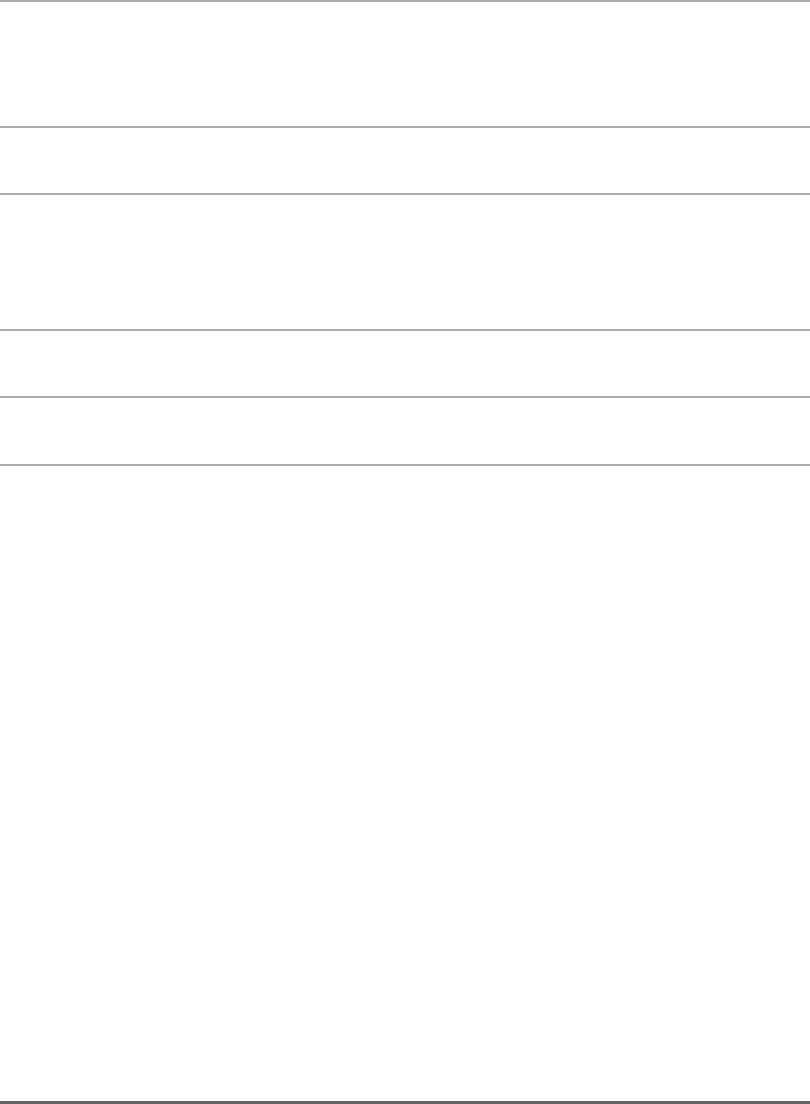
Contents
6 iX104C5 User’s Handbook
ATroubleshooting 77
BUsing BIOS and AOS Functions 79
Disabling the Auto Power feature . . . . . . . . . . . . . . . . . . . . . . . . . . . . . . . . . . . . . 80
Enabling automatic LCD backlight control . . . . . . . . . . . . . . . . . . . . . . . . . . . . . 80
CGlossary 81
DHardware Specifications 87
EAgency Notices 93

iX104C5 User’s Handbook 7
Disclaimer
Xplore Technologies® has made every effort to ensure the accuracy and
completeness of this document; however, because ongoing development
efforts are made to continually improve the capabilities of our products,
we cannot guarantee the accuracy of the contents of this document. We
disclaim liability for errors, omissions, or future changes herein.
Trademarks
Xplore and the Xplore logo are registered trademarks of Xplore
Technologies Corp.; iX104, iX104C5, iX104C5 Lite, and iX104C5 Dual
Mode are trademarks of Xplore Technologies Corp. Kensington and
MicroSaver are registered trademarks of the Kensington Technology
Group. Microsoft is a registered trademark of Microsoft Corporation.
Windows 7, Windows XP Professional, and Windows XP Tablet PC
Edition are trademarks of Microsoft Corporation. MicroSD is registered
trademark of the Personal Computer Memory Card International
Association. Intel and iCore, are registered trademarks of Intel
Corporation. Wi-Fi is a trademark of the Wireless Ethernet Compatibility
Alliance (WECA). ISODAMP is a registered trademark of Aearo
Company.
All other brands, product names, company names, trademarks and service
marks used herein are property of their respective companies.
Copyright
Copyright © 2003-2011 Xplore Technologies Corp. All rights reserved.
No part of this publication may be copied, reproduced, or translated,
without the prior written consent of Xplore Technologies. No part of this
publication may be stored or transmitted in any electronic form without
the prior consent of Xplore Technologies. Any unauthorized use is a
violation of copyright laws.
Publication information
PN: 95-01097, Rev. A
August 2011
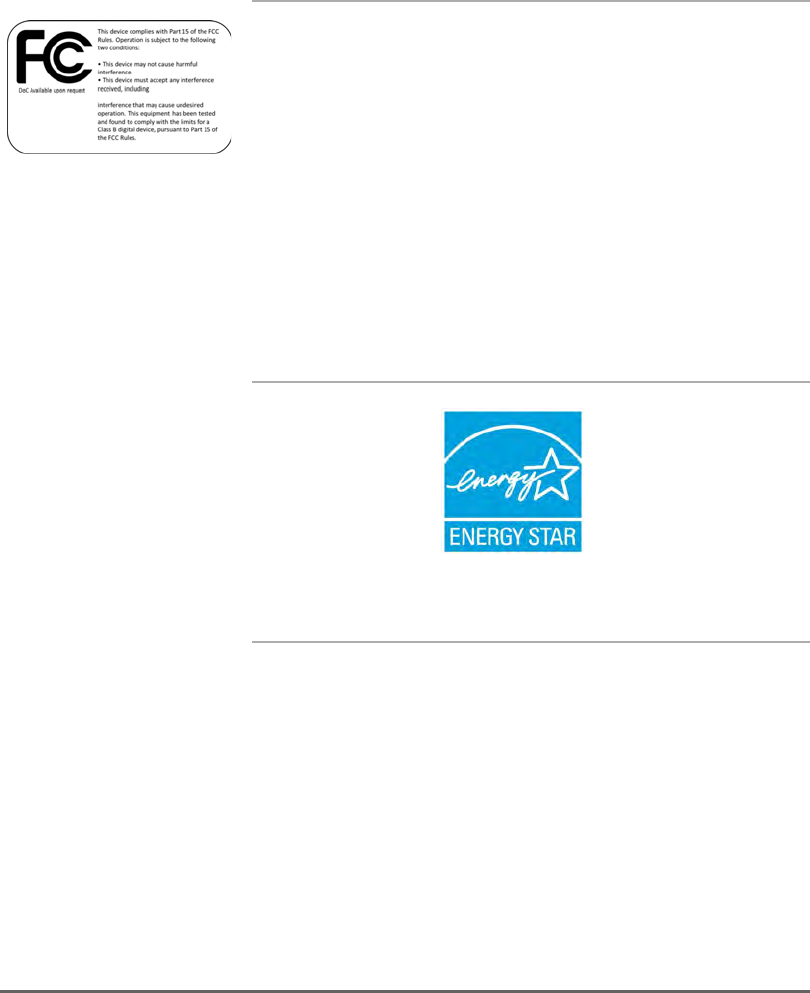
8 iX104C5 User’s Handbook
Declaration of conformity
DECLARATION OF CONFORMITY according to FCC Part 15, IC ICES-003, and
RTT&E directives
Responsible Party Name: Xplore Technologies Corp.
Address: 14000 Summit Drive, Suite 900, Austin, Texas 78728
Telephone: 512.336.7797
Declares that product: Model Series: iX104C5 complies with Part 15 of the FCC Rules.
This device complies with Part 15 of the FCC rules. Operation is subject to the
following two conditions: (1) This device may not cause harmful interference, and, (2)
This device must accept any interference received, including interference that may
cause undesired operation.
WARNING
Changes or modifications to this unit not expressly approved by the party responsible for
compliance may void the user’s authority to operate this equipment.
For more information about FCC rules and their applicability to the iX104, see
Appendix E, “Agency Notices.”
Energy Star Partner
Warranty information
The iX104C5 is backed by a standard 36-month International Limited Warranty. An
extended International Limited Warranty is available. Check the service kit included
with your computer for warranty terms and conditions.

iX104C5 User’s Handbook 9
Important safety information
Before you use the iX104C5 (referred to as the tablet), read these safety
instructions and the operation instructions in this handbook.
Failure to observe all these instructions voids the Limited Warranty and may lead
to suspension or denial of services to the offender, or legal action, or both.
Follow any special regulations governing the use of the tablet and, if radio-enabled,
always switch it off in areas where radio devices are forbidden or when the radio device
can cause interference or danger.
Always follow any safety laws and regulations pertaining to the use of cell phones and
two-way radios, because these laws and regulations typically apply to the use of the
wireless-enabled tablet.
Observe all restrictions on the use of radio equipment in fuel depots (fuel storage and
distribution areas), chemical plants, and wherever blasting operations are in progress or
in any area in which restrictions on radio transmissions are imposed.
Switch off the tablet when in an aircraft. The tablet is not FAA-approved for use on
aircraft. The effect of the use of the tablet in aircraft is unknown. Using the tablet in an
aircraft may affect aircraft instrumentation, communication, and performance; may
disrupt the network; and may be illegal.
Operating the wireless-enabled tablet may interfere with the functioning of
inadequately protected medical devices such as pacemakers. Consult a physician or the
manufacturer of the medical device if you have any questions.
Radio signals from your tablet will not affect the operation of most modern equipment,
but certain electronic equipment, including automotive systems, may not be shielded
against radio signals from your tablet. Check with the manufacturer of your motor
vehicle or the manufacturer’s representative to determine whether using the tablet will
present any safety issues.
Avoid using the tablet in any environment that requires your full attention, such as
when driving a vehicle. If you need to use your tablet while driving, have a passenger
use it for you or find a safe location to halt your vehicle.
WARNING – BATTERIES
Use only battery types specified in this handbook. Using any other type of battery can be
dangerous and can disable the tablet. Do not drop or mishandle the batteries, immerse
them in water, or subject them to high heat. Doing so could increase the risk of explosion
or leakage, and possibly cause injury. The lithium-ion batteries used in this equipment
contain material that is hazardous to your health. If battery contents come in contact with
the eyes, IMMEDIATELY flush the affected area with clean water for 15 minutes and have
someone else summon medical attention for you. Unaffected persons should assist the
affected individual in the vital first flushing of the eyes. RECHARGING THE BATTERY
MUST ONLY BE CARRIED OUT IN ANON-HAZERDOUS AREA USING THE SUPPLIED
AC ADAPTOR. The definition of hazardous areas can be found in Standard EN 60079-10.

10 iX104C5 User’s Handbook
WARNING
When operating the tablet in a known explosive environment do not remove or replace the
battery while the circuit is live. Before removing the battery verify that the area is known to
be free of ignitable concentrations of flammable substances.
EXPLOSION HAZARD – DO NOT DISCONNECT WHILE CIRCUIT IS LIVE UNLESS
AREA IS KNOWN TO BE NON-HAZARDOUS.
AVERISSEMENT – RISQUE D’EXPLOSION. NE PAS DÉBRANCHER TANT QUE LE
CIRCUIT EST SOUS TENSION, À MOINS QU’IL NE S’AGISSE D’UN EMPLACEMENT
NON DANGEREUX.
WARNING
EXPLOSION HAZARD – DO NOT REPLACE THE BATTERY UNLESS POWER HAS
BEEN SWITCHED OFF OR THE AREA IS KNOWN TO BE NON-HAZARDOUS.
AVERTISSEMENT – RISQUE D'EXPLOSION – COUPER LE COURANT OU
S'ASSURER QUEL'EMPLACEMENT EST DESIGNE NON DANGEREUX AVANT DE
REPLACER LE BATTERY.
WARNING
EXPLOSION HAZARD - SUBSTITUTION OF COMPONENTS MAY IMPAIR
SUITABILITY FOR CLASS I, DIViSION 2.
AVERTISSEMENT – RISQUE D'EXPLOSION – LA SUBSTITUTIOND E
COMPOSANTSP EUTR ENDRE CE MATERIEL INACCEPTABLE POUR LES
EMPLACEMENTS DE CLASSE I, DIVISION 2.
WARNING
EXPLOSION HAZARD – DO NOT DISCONNECT EQUIPMENT UNLESS POWER HAS
BEEN SWITCHED OFF OR THE AREA IS KNOWN TO BE NON-HAZARDOUS.
AVERTISSEMENT – RISQUE D'EXPLOSION – AVANT DE DECONNECTER
L'EQUIPEMENT, COUPER LE COURANT OU S'ASSURER QUE L'EMPLACEMENT
EST DESIGNE NON DANGEREUX.
WARNING
Do not use any dock or any other accessory or attachment that is not manufactured or
supplied by Xplore or an authorized Xplore accessories supplier. Use of any accessory or
attachment that is not supplied or approved for use with the tablet by Xplore is not
permitted because it may cause hazards.
Operate the tablet only from the type of power source indicated on the marking label.
(See page 48 for more information about the battery and power supply.) Route power
supply cords so that they are not likely to be walked on or pinched by items placed
upon or against them. Pay particular attention to cords at plugs and convenience
receptacles, and at the point where cords exit from the tablet or its dock. Do not
overload wall outlets, extension cords, or integral convenience receptacles because this
can cause fire or electric shock.

iX104C5 User’s Handbook 11
Unplug the tablet and refer the tablet and dock for service to qualified
service personnel if any of the following conditions occur:
■The power supply cord or plug is damaged.
■The tablet or dock does not operate normally when you follow the
instructions in this book.
■The tablet or dock exhibits a distinct change in performance.
Adjust only controls for which there are instructions in this book. An
improper adjustment of other controls can result in damage and may
require extensive work by a qualified technician to restore the tablet or
dock to normal operation.
CAUTION
Avoid prolonged physical contact with the exposed metal surfaces on
the front and back of the tablet. While the tablet may not feel hot to the
touch, if you maintain physical contact with the tablet for a long time
(for example, if you rest the tablet on your lap for a long time), your skin
may suffer low-heat injury. In addition, be careful when you remove a
PC card that has been used for a long time, because the card may be
hot.

12 iX104C5 User’s Handbook
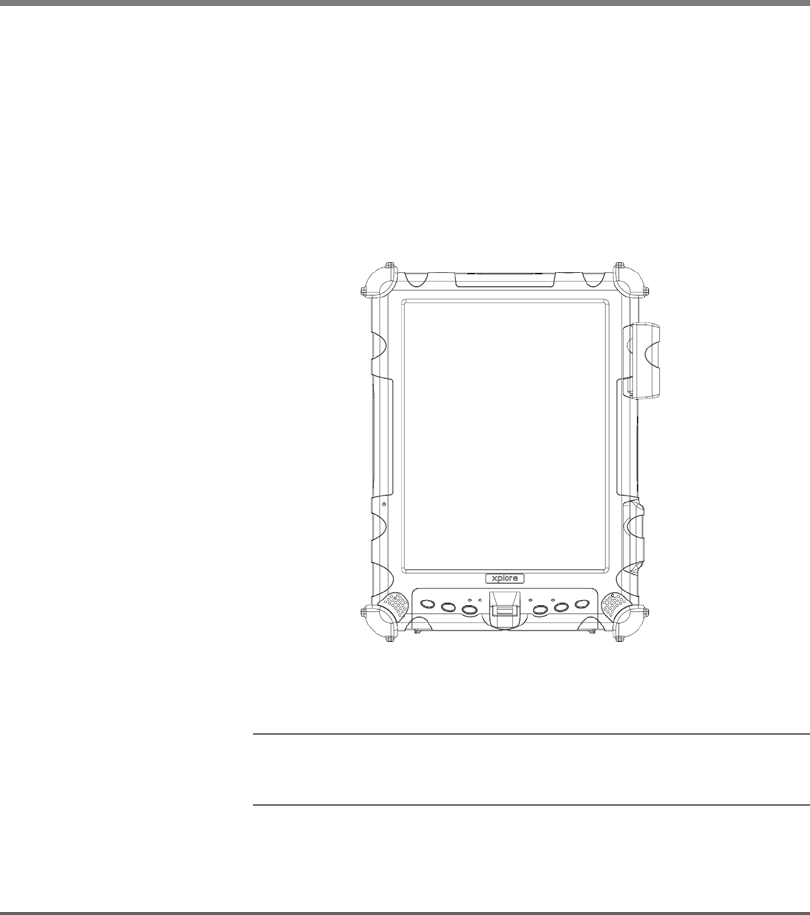
iX104C5 User’s Handbook 13
Welcome
Welcome to the Xplore Technologies® iX104C5™tablet PC, the
rugged tablet designed, tested, and manufactured to meet the
environmental and physical real-world challenges faced by today’s
mobile workers. Based on years of experience in rugged mobile
applications, the iX104C5 is designed to withstand the abuses of
everyday wear and tear.
Advanced technology, innovative design, and a rugged case are just a
few highlights of your iX104C5 system.
Note: This handbook assumes that you have basic experience
using computers and Microsoft® Windows®.
Tablet with enhanced performance antenna

Welcome
14 iX104C5 User’s Handbook
About your computer
The iX104C5 is a high-performance tablet PC that runs on Microsoft
Windows 7 32-bit and 64-bit operating systems.
You can use any of the following methods to control the tablet:
■Special, enhanced pen (included with the tablet)
■Your finger
■Any suitable pointing device
Note: In this handbook, all information applies to all models
unless otherwise noted.
All iX104C5 tablets have been engineered and tested to meet Military
Standards for Environmental Extremes (MIL STD 810G). Your tablet
includes the following features that make it exceptionally rugged and
durable:
■Durable, long-lasting, rigid magnesium enclosure
■Interior and exterior multi-layer magnesium structure
■Bumper system and gasket protection mechanisms
■Specialized drive technology
■Removable, dual, Solid State Drive (SSD) cartridge
■Integrated, protected wireless LAN and WAN antennas for dual
mode operation
■Locked-in-place memory, cables, and connectors
■Proprietary thermal management system

Welcome
iX104C5 User’s Handbook 15
Package contents
Check to make sure your package includes the following items:
■Quick Start Guide
■Battery pack
■Power cord
■AC adapter
■Pen (attached to tablet)
■Pen tether (attached to tablet)
■iX104C5 tablet PC
■Warranty information kit
■Operating System Recovery Guide
Optional accessories
Your package also includes any optional accessories you ordered.
Docking options
■xStand Desktop Docking Station
■xDock Vehicle Docking Station
Carrying cases
■Shoulder cases
■Portfolio case
■Dockable case
Memory
■2, 4, or 8 GB RAM
■40, 80, or more GB Solid State Drive (SSD)

Welcome
16 iX104C5 User’s Handbook
Power options
■AC adapter with U.S. cord
■Weight-reduced battery pack (56 watt hours)
■Extended life battery pack (68.5 watt hours)
■Auto adapter (cigarette lighter adapter)
Additional accessories
■Top-mounted Fast-Lock GPS II Pro (submeter accuracy)
■Non-rugged USB optical disk drive
■USB rugged, backlit keyboard (83-key)
■Replaceable drive cartridges
■Active stylus
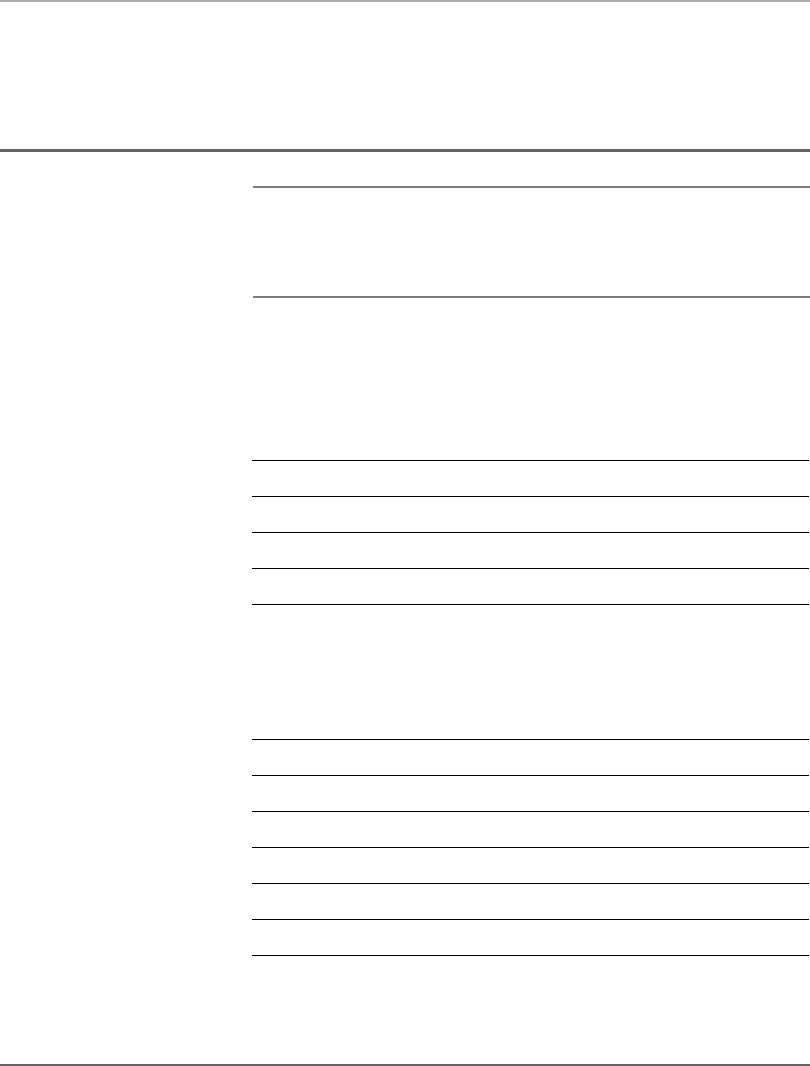
Welcome
iX104C5 User’s Handbook 17
Contacting Xplore – service and questions
Note: To troubleshoot problems (including wireless and GPS
problems), before you call, read the FAQ page of the Xplore
Technologies Web site. Go to http://www.xploretech.com; then
select Customer Support; then FAQ.
If you purchased your tablet from an authorized Xplore dealer,
contact the dealer for service and support.
If you purchased your tablet directly from Xplore, use any of the
following methods to contact Xplore for service and support:
Before you contact Xplore, have the following information ready so
that the customer support representative can quickly provide a
solution:
Web site http://www.xploretech.com
E-mail customersupport@xploretech.com
Toll free 1-866-296-8541, extension 222
Fax 1-512-336-7791
Product name: iX104C5
Product serial number
Purchase date
Conditions under which the problem occurred
Any error messages that were displayed
Type of device connected, if any

18 iX104C5 User’s Handbook
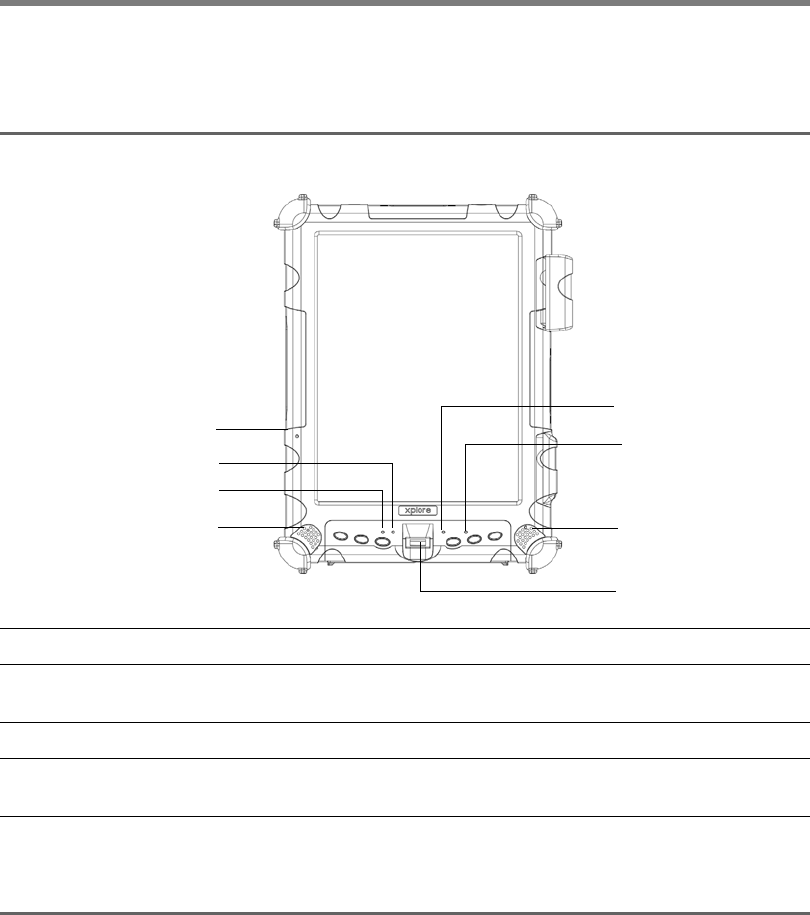
iX104C5 User’s Handbook 19
1Getting Started
This chapter gives you an overview of your tablet and includes a
quick-start guide to tablet keys.
Front view
Built-in
microphone
Speaker Speaker
Auto Light sensor
Reset switch
Status indicator
SSD indicator
Fingerprint scanner
Built-in microphone Enables you to input mono audio with noise cancellation. (See page 44.)
Reset switch Enables you to turn off the computer when using the Power (On/Off)/Backlight
(On/Off)/Resume key is not effective. (See page 30.)
Status indicator Indicates the computer status (on, off, etc.). (See page 24.)
Speakers Enable you to listen to stereo audio files. Sealed to provide protection from the
environment.
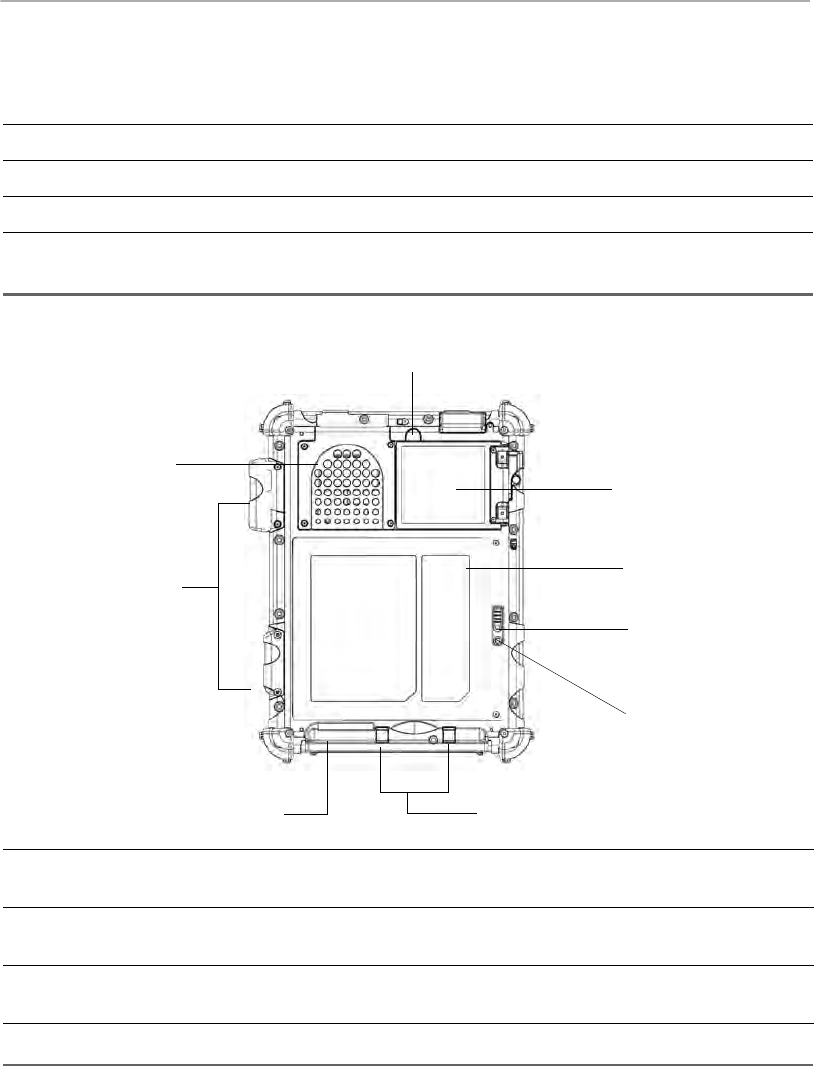
Chapter 1. Getting Started
Back view
20 iX104C5 User’s Handbook
Back view
Auto Light sensor Detects ambient light conditions.
SSD indicator Indicates hard drive activity. (See page 24.)
Fingerprint scanner Enables you to use fingerprint verification features. (See page 38.)
Fan cover
Pen
Removable
battery pack
Battery
release
latch
Pen holder
Antenna
covers
Digital camera
Battery
lock
button
SSD carrier
Fan cover Plastic cover over the thermal transfer bay that manages heat movement out of the
computer.
Antenna covers For optional wireless LAN and WAN models, protect and secure the radio antennas
(accessible by authorized service personnel only).
Pen The main device you use to enter data and control applications (instead of a mouse
or a keyboard). Also called the stylus. See “Using the pen” on page 34.
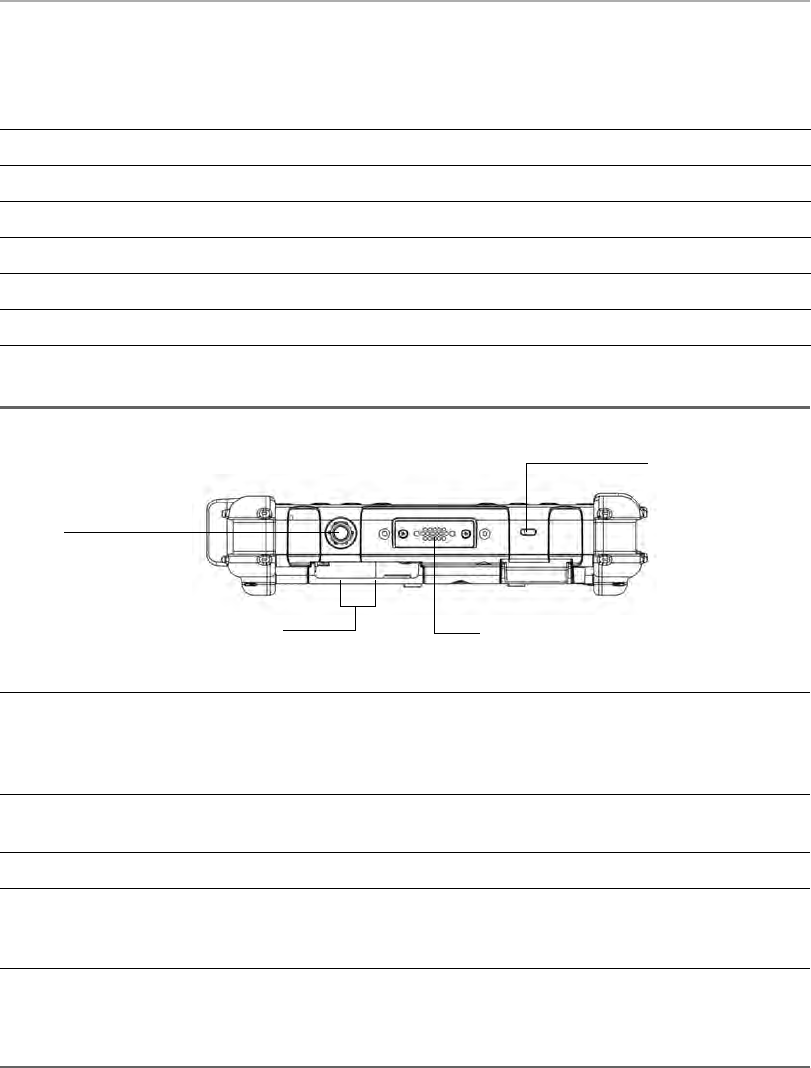
Chapter 1. Getting Started
Left side view
iX104C5 User’s Handbook 21
Left side view
Pen holder Provides a place to secure the pen when you are not using it.
Battery release latch Provides access to the battery.
Battery lock button Secures the battery inside the tablet.
Removable battery pack Powers the computer when AC power is unavailable.
Digital camera 3-mega-pixel, auto-focus camera for taking color or black-and-white image or video.
SSD carrier User-accessible drive carrier for SSD storage.
Power On/Off,
Backlight On/Off,
Sleep/Resume
button
Heat exchange XPL side port
Kensington
lock slot
Power On/Off,
Backlight On/Off,
Sleep/Resume button
Press to power computer. Press and hold for more than 4 seconds to force
power off.
Momentarily press to toggle the backlight on or off.
Heat exchange Helps prevent the computer from overheating by forcing heat away from the
computer. (Do not block the vents.)
XPL side port Permits connection of special devices made expressly for the iX104C5.
Kensington™ lock slot Connector for the optional Kensington MicroSaver™ or equivalent compatible
security cable.
Note: Contact your reseller for information about the Kensington security cable.
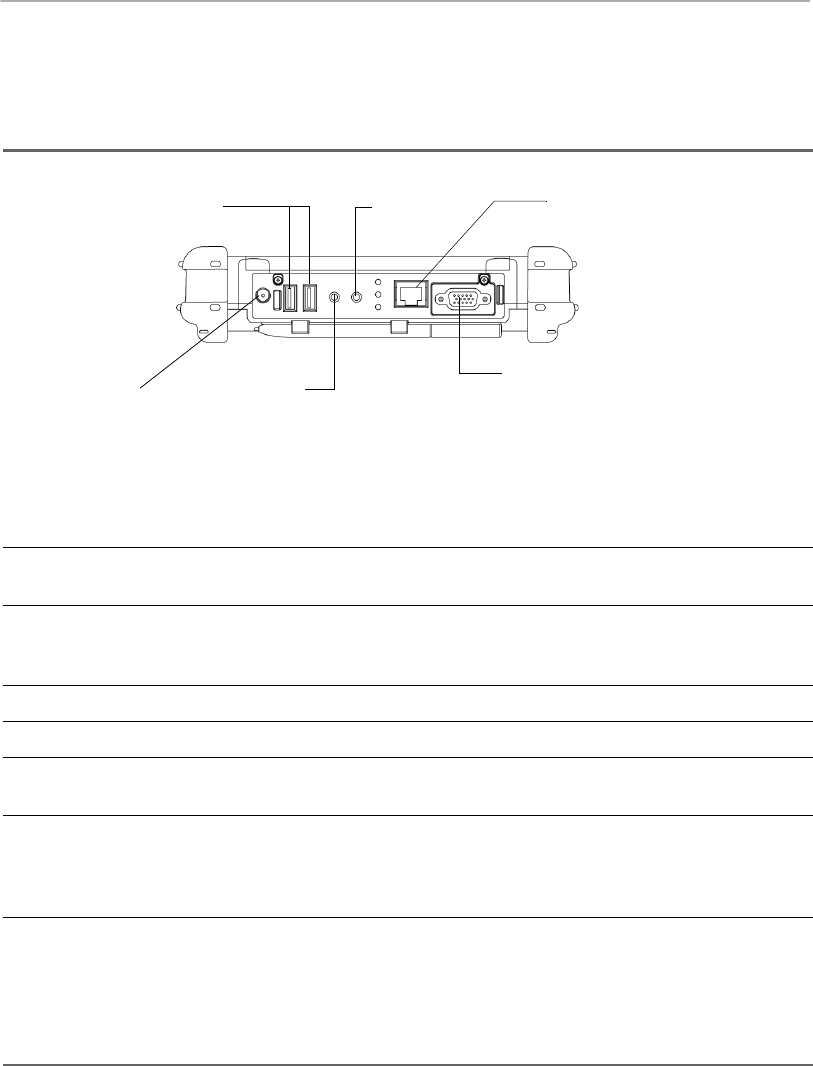
Chapter 1. Getting Started
Right side view
22 iX104C5 User’s Handbook
Right side view
The connectors on the right side of the computer are located behind the outer doors.
Microphone
connector
Power
connector 9-pin serial connector or
optional connector for
external monitor
LAN connector
USB ports
Headphone
connector
Power connector For the AC adapter or optional auto adapter. (See “Optional accessories” on
page 15.)
USB 2.0 ports For Universal Serial Bus devices (compliant with USB Standard Revision 2.0).
Note: The optional Office and Vehicle Docks include additional USB ports. See
“Optional accessories” on page 15.
Headphone connector For stereo headphones or speakers.
Microphone connector For an external microphone.
LAN connector For connecting a standard RJ-45 connector to the tablet’s internal local area
network (LAN) card
9-pin serial connector
or
optional external monitor
connector
Serial connector for connecting terminals or other devices that use the RS-232,
RS-422, or RS-485 data transfer standard, or an optional connector for an external
monitor or projection panel.
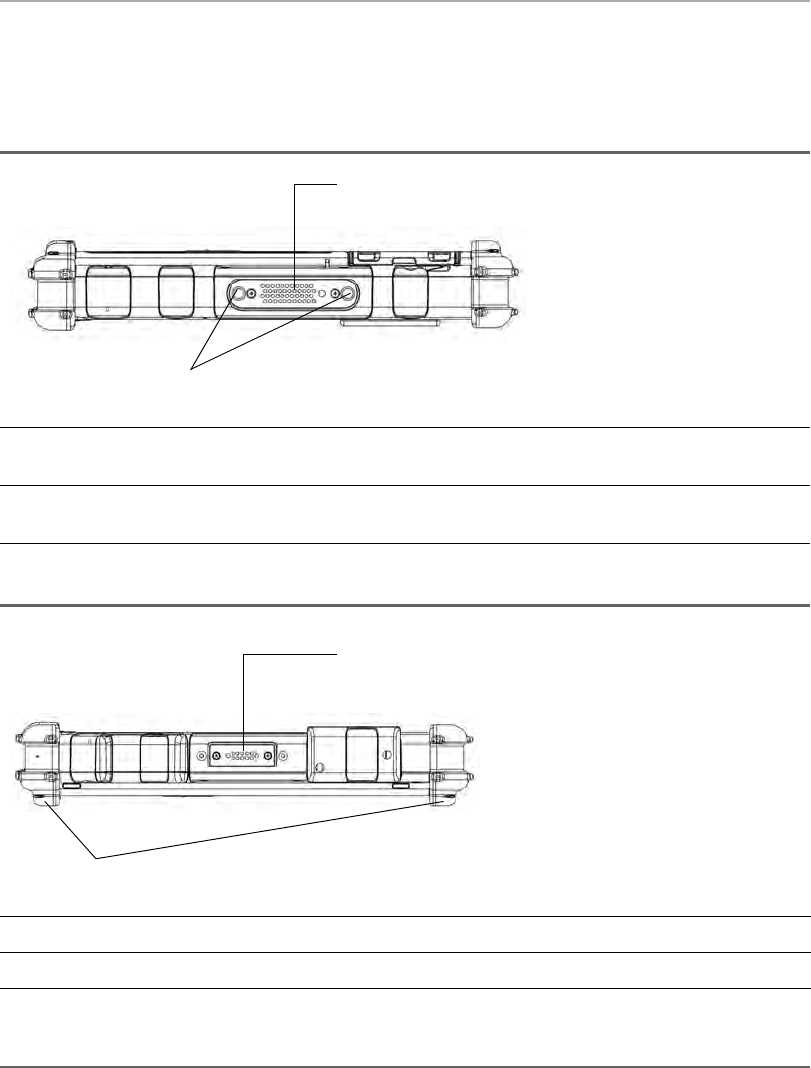
Chapter 1. Getting Started
Bottom view
iX104C5 User’s Handbook 23
Bottom view
Top view
Docking connector for the
optional Xplore Tablet Dock
Guide pin receptacles
Docking connector Enables you to connect the optional xStand Desktop Docking Station or xDock
Vehicle Docking Stations.
Guide pin receptacles Help assure a secure connection of the optional xStand or xDock.
Note: See “Optional accessories” on page 15.
XPL expansion port
Bumpers
Bumpers Fabricated from rugged material. Raised to help protect the computer from damage.
XPL expansion port A port that permits connection of special devices made expressly for the iX104C5.
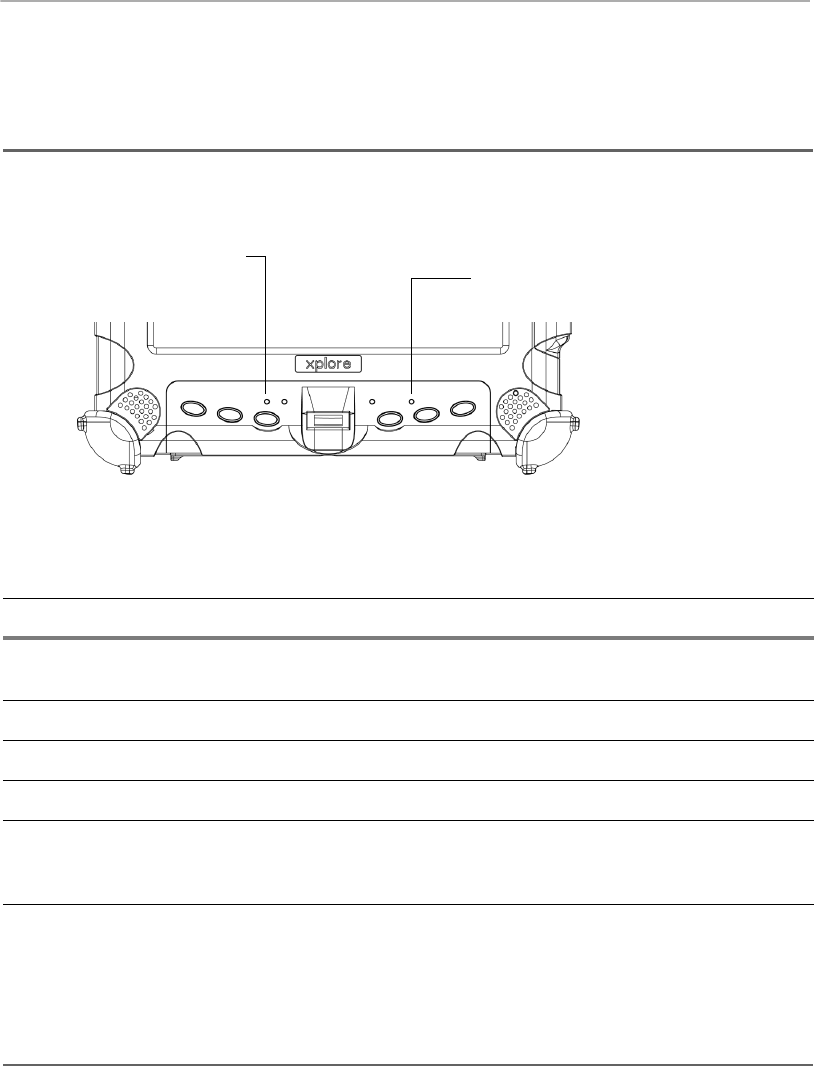
Chapter 1. Getting Started
LED indicators
24 iX104C5 User’s Handbook
LED indicators
The LED indicator lights show the status of system functions.
The following table defines the various LED states.
Status LED Drive LED
Table 1 Status LED indicator
Mode/State LED State Meaning
On state green, continuous The computer is on, ready for use, and functioning normally. The
battery is fully charged.
Charging green, blinking The AC adapter is plugged in and the battery is charging.
Off state off (no light) The computer is off.
Sleep mode green, breathing The computer is on and is in Sleep mode.
Thermal control blue, blinking The computer is on and is in Warm-up mode, with the LCD and
backlight off. After the system has warmed to a safe level, the
LCD and backlight turn on.
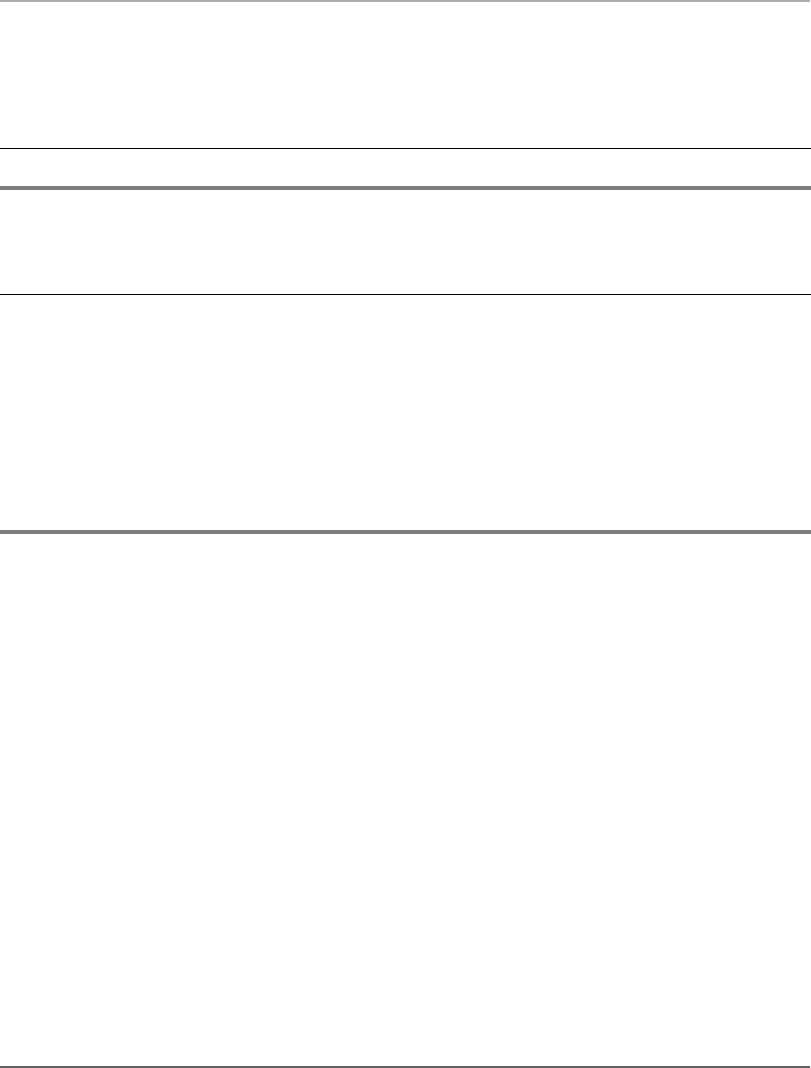
Chapter 1. Getting Started
LED indicators
iX104C5 User’s Handbook 25
On red, blinking The computer is powered on, running on battery power, and the
charge level in the battery has reached a minimum warning state.
Plug the computer into an AC/DC power source or install a
charged battery.
On red, continuous The computer is on, running on battery power, and the charge
level in the battery has reached a critical state. Plug the computer
into an AC/DC power source or install a charged battery.
or
The computer has encountered a fault and is not operating
normally. Contact your computer support personnel, such as your
help desk.
or
The computer is off and you have inserted a battery that is at the
critical low level and is incapable of running the computer.
Table 1 Status LED indicator (continued)
Mode/State LED State Meaning
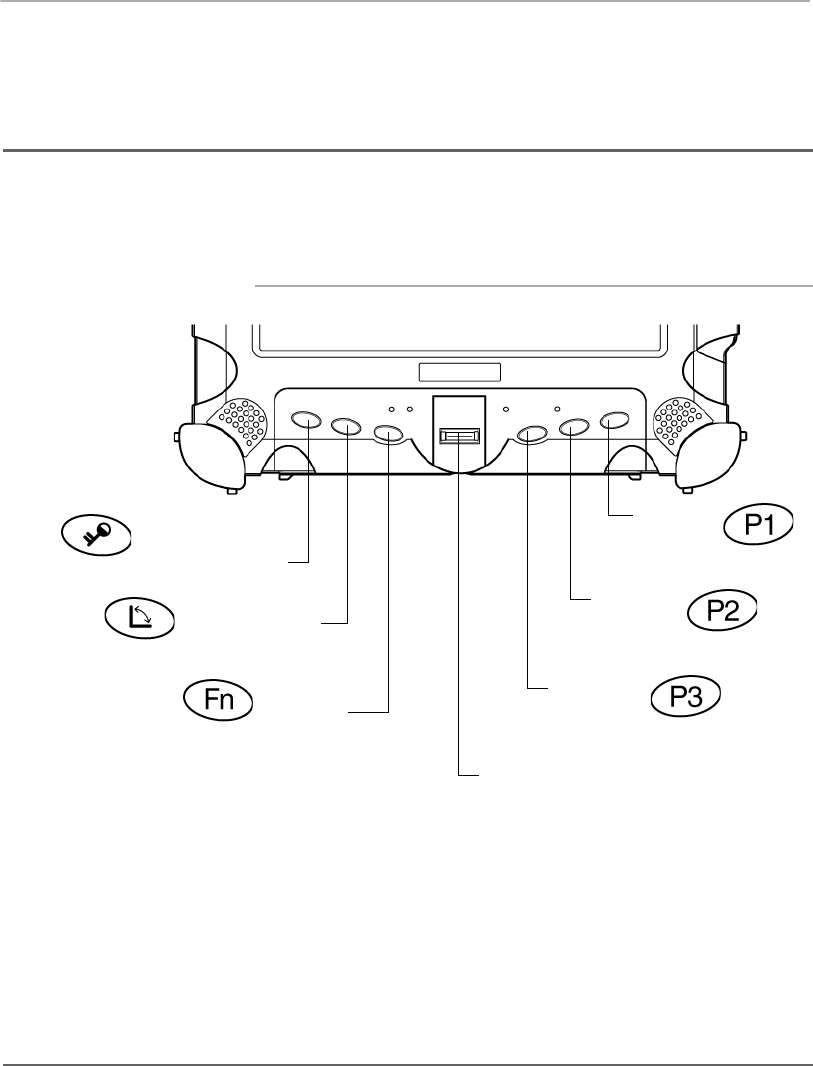
Chapter 1. Getting Started
Quick-start guide
26 iX104C5 User’s Handbook
Quick-start guide
This section is a quick guide to using the main features of your tablet.
(See Chapter 2 for detailed information.)
Application, Windows, and hot keys
Ctrl-Alt-Delete
(Secure Attention
Sequence) key
Screen Rotation
key
Function
key
Hot key 1
Hot key 2
Hot key 3
Fingerprint scanner
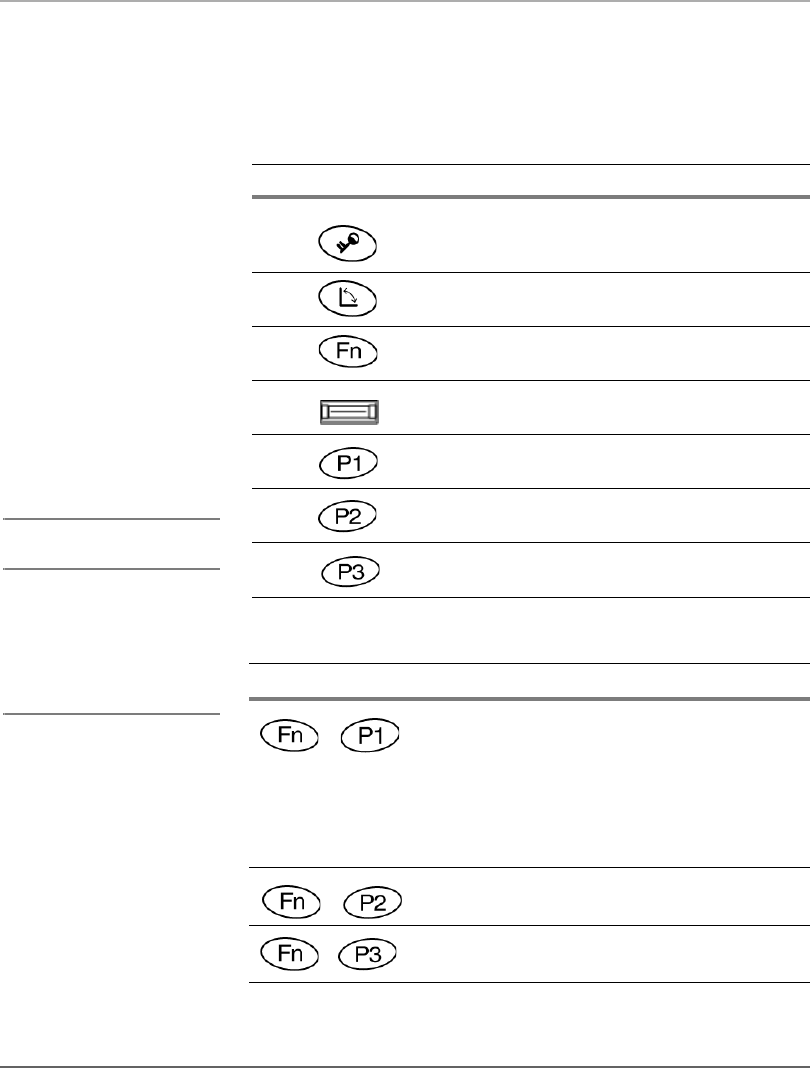
Chapter 1. Getting Started
Quick-start guide
iX104C5 User’s Handbook 27
Table 2 Main keys
Press this key... To perform this function
Log on after resuming operation from power
management, powering on, or locking.
After logging on, launch Windows Task Manager.
Rotate screen orientation between portrait
(vertical) and landscape (horizontal).
Use in combination with another key to perform
various functions. (See page 27.)
Fingerprint scanner.
Display the Start menu.
Open Internet Explorer, or perform a
user-definable function.
Put the computer in Sleep mode.
Table 3 Function mode keys
Press these keys... To perform this function
Default function: Send video display to a monitor
or projection panel connected to the computer
(and back to the computer again). You can
program this key combination to perform a
different function. (See “Programming hot keys to
start applications, open documents, or go to a
website” on page 61.)
Enable or disable Airplane mode, which toggles
wireless radios on/off.
Bluetooth toggle.
To define a function, see
“Programming hot keys” on
page 60.
In the default configuration,
the P3 key puts the computer
in Sleep mode and the Power
button shuts down the
computer. To change these
settings, see page 52.

28 iX104C5 User’s Handbook
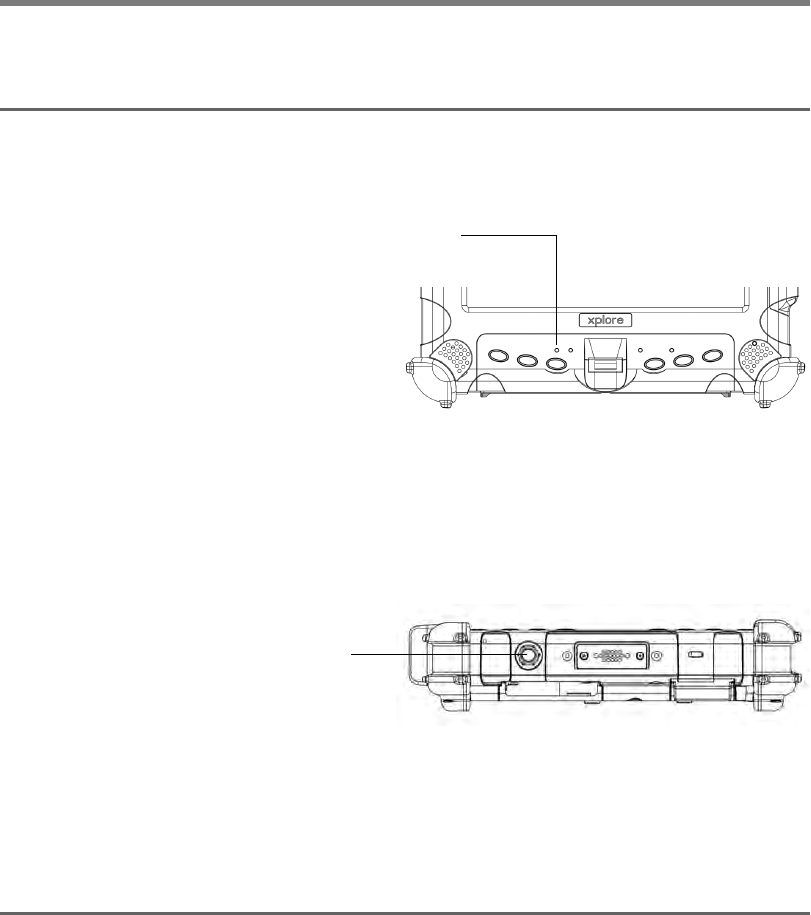
iX104C5 User’s Handbook 29
2Using the Tablet
This chapter contains detailed instructions for using the tablet.
Turning on the computer
1. Make sure the computer is off.
2. Make sure the battery is charged or that the computer is plugged
in to an external power source.
3. Press the Power On/Off, Backlight On/Off, Sleep/Resume button.
When the computer is off,
the Status LED is off.
Power On/Off,
Backlight On/Off,
Sleep/Resume
button
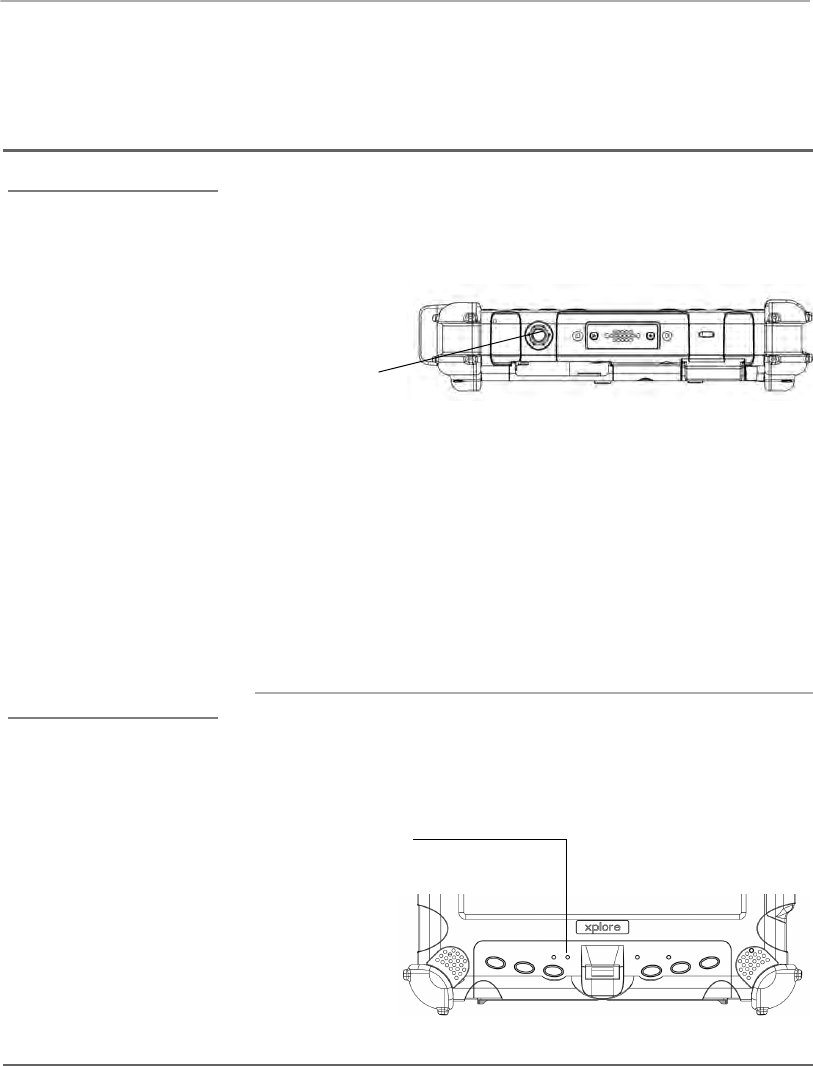
Chapter 2. Using the Tablet
Turning off the computer
30 iX104C5 User’s Handbook
Turning off the computer
1. If the computer is in Sleep mode, press the Power On/Off,
Backlight On/Off, Sleep/Resume button to resume operation. (See
page 32 for information about Sleep mode.)
2. Make sure the battery is charged or that the computer is plugged
in to an external power source.
3. Save your work and close all programs.
4. From the Windows Start menu, click Turn Off Computer.
5. The Turn off computer dialog box opens.
6. Click Turn Off or press the Power button continuously for more
than 4 seconds.
Using the Reset switch
If the computer does not seem to be accepting input and you cannot
turn it off by using the method described in “Turning off the
computer,” press the Reset switch. (Use the stylus or a similar
instrument to press the switch).
When the computer is in
Sleep mode, the Status LED
is breathing green.
Power On/Off,
Backlight On/Off and
Sleep/Resume
button
Use the Reset switch only if
you cannot turn off the
computer by any other
means, because you may
lose unsaved data.
Reset switch

Chapter 2. Using the Tablet
Suspending and resuming operation
iX104C5 User’s Handbook 31
Suspending and resuming operation
To conserve battery power when you do not want to turn off the
computer or when you need to install a charged battery pack, put the
computer into Sleep mode. (You can suspend operation without
closing any programs or Windows.)
When you suspend operation:
■Programs that are running stop (but do not close).
■Active data is saved.
■The system enters one of the following low-power modes:
• Sleep (Suspend-to-RAM) mode – The Status LED light is
breathing green. Active data is saved in RAM and most other
components are turned off.
Although the computer uses very little power when in Sleep
mode, eventually the battery’s power does run out. If you do
not plan to use the computer for an extended period of time,
turn the computer off or put it in Hibernation mode instead of
Sleep mode.
• Hibernation mode – Active data is saved on the SSD and
power usage is reduced to the same level as when the
computer is turned off. In Hibernation mode, there is no
danger of losing data if battery power is lost.
Notes:
If you have set your computer to turn power off (in the Power Options
utility in Windows Control Panel), you cannot suspend operation. To
change power settings, see “Selecting Power (On/Off)/Backlight(On/
Off)/Sleep/ Resume button options” on page 55.
In the default configuration, the P3 key puts the computer in Sleep
mode and the Power button shuts down the computer. To change
these settings, see “Programming hot keys to perform pre-defined
functions” on page 65.
For more information, see
“Checking battery power
status” on page 52.
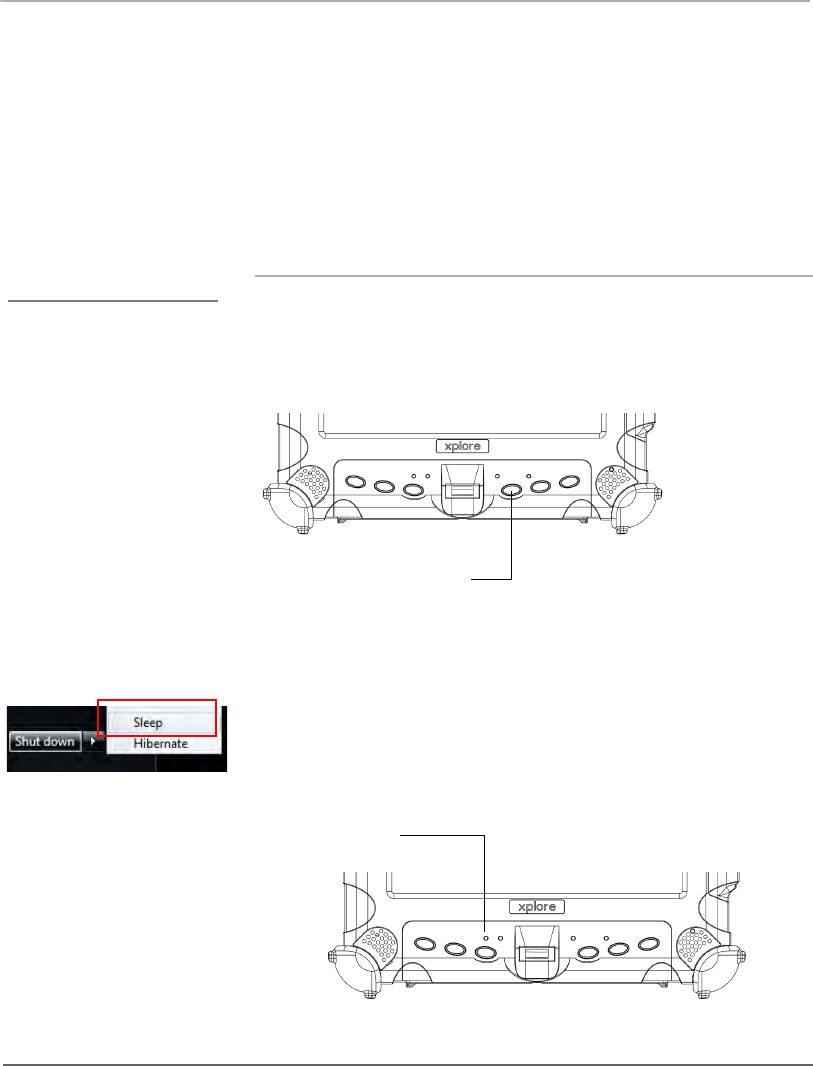
Chapter 2. Using the Tablet
Suspending and resuming operation
32 iX104C5 User’s Handbook
If your computer is connected to a network, the network may
automatically log you off after a period of inactivity while system
operation is suspended. Contact your help desk or system
administrator to learn your log-off time limit.
Suspending operation
Use one of the following methods to suspend operation:
Method 1
Press the P3 key.
Method 2
1. Press the Windows Start button; then press the right arrow next to
the Shutdown button.
2. Press Sleep.
When operation is suspended, the Status LED displays a breathing
green light.
In order to suspend
operation, the Sleep
option must be enabled in
Windows Power Options.
See “Selecting Power
(On/Off)/Backlight(On/
Off)/Sleep/ Resume
button options” on
page 55.
P3 key
Status LED
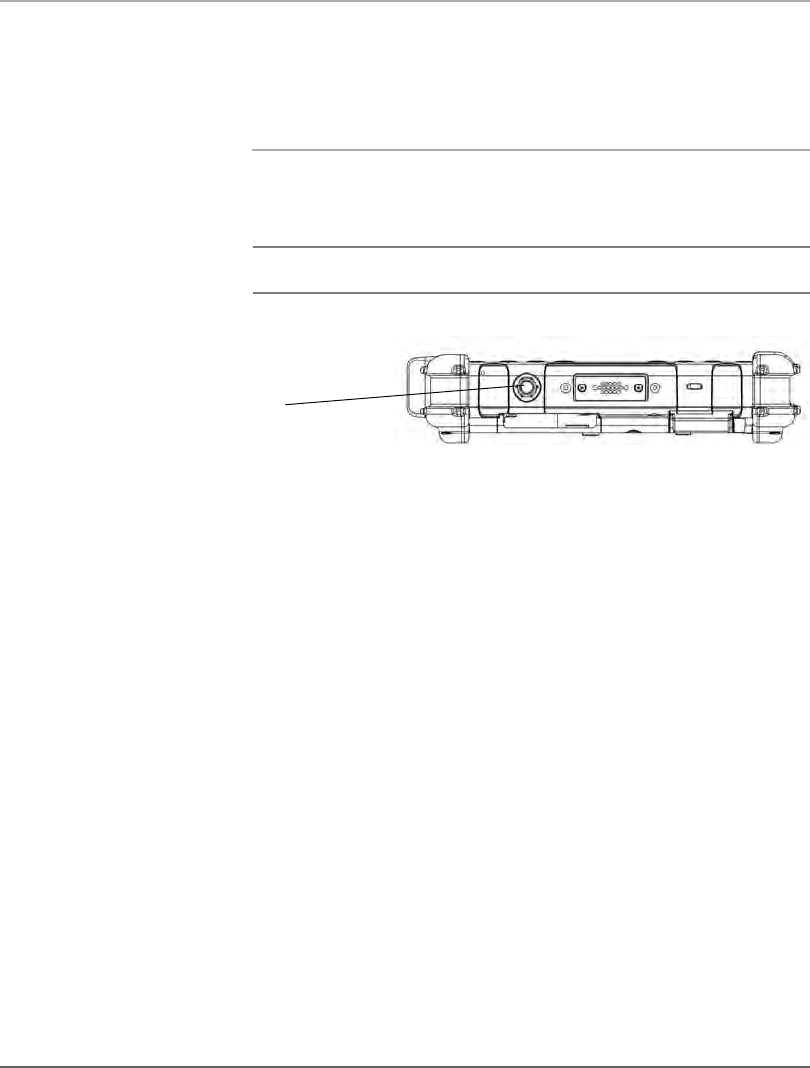
Chapter 2. Using the Tablet
Suspending and resuming operation
iX104C5 User’s Handbook 33
Resuming operation
To resume operation when the computer is in Sleep mode, press the
Power On/Off, Backlight On/Off, Suspend/Resume button.
Note: Press the button only once.
Approximately 20 seconds later, the computer resumes normal
operation. When the Status LED displays a continuous green light,
you can begin using the computer.
Power On/Off,
Backlight On/Off,
Sleep/Resume
button

Chapter 2. Using the Tablet
Using the pen
34 iX104C5 User’s Handbook
Using the pen
You can use any of the following methods to select items and to
navigate through programs.
■Auto-Sense mode: Use either the multifunction pen or your
finger interchangeably. The computer distinguishes between the
two input modes and automatically adjusts accordingly. This is
the tablet’s default state.
■Digitizer mode: Use only the special multifunction pen provided
with the computer.
For more information, see “Programming hot keys to perform pre-
defined functions” on page 65.
WARNING
Do not use items such as a ball point pen or a screwdriver that can
damage the tablet. Damage caused by using an item not provided with
the tablet is not covered by the tablet warranty.
Note: During the first use of the tablet, or if the action you are
trying to perform does not occur when you use the pen or your
finger to touch the screen, calibrate the digitizer as described in
“Calibrating the digitizer” on page 75.
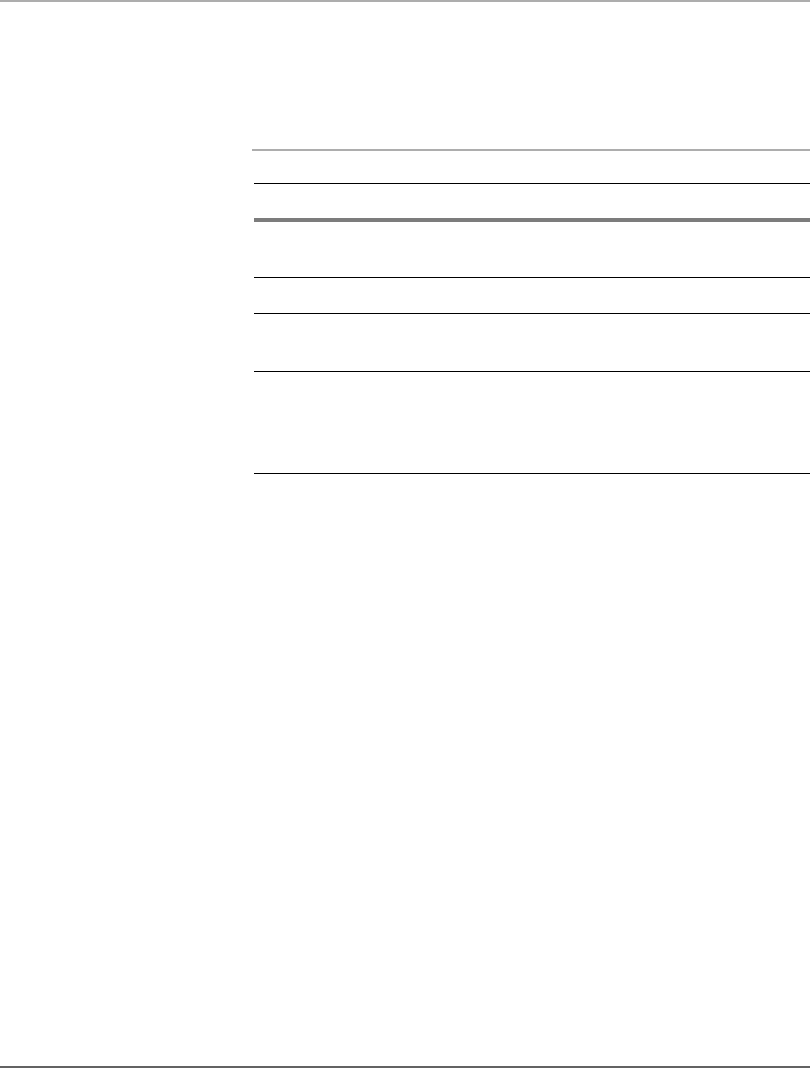
Chapter 2. Using the Tablet
Using the pen
iX104C5 User’s Handbook 35
Using the digitizer to perform mouse functions
Changing the pen double-click speed
The pen double-click speed is in sync with the mouse double-click
speed. To change the speed, follow the instructions below.
1. Click the Windows Start button.
2. Click the Control Panel option.
3. In the Control Panel window, select Hardware and Sound >
Set up your Pen and Tablet.
4. Drag the slider to a faster or slower speed.
To perform this function... Do this
Select an object
(left button click).
Tap the pen tip once on the object.
Perform a double-click. Quickly tap the pen tip twice on the object.
Perform a right-click. Hold the pen or your finger directly on the
object for 1 second.
Move or drag an object. Place the pen tip or your finger on the
object; then continue to hold the pen tip or
your finger against the screen as you move
the pen or your finger.
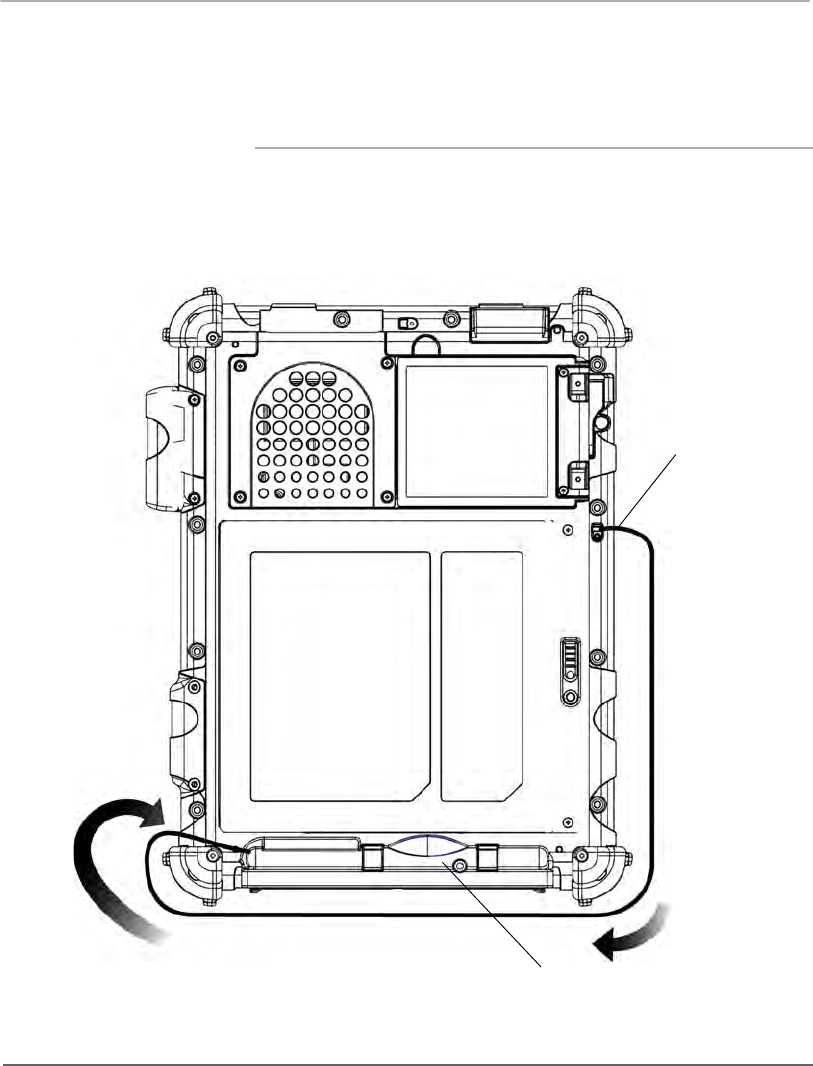
Chapter 2. Using the Tablet
Using the pen
36 iX104C5 User’s Handbook
Positioning the pen and pen tether
The pen tether helps prevent the loss of your pen. The following
illustrations show how to position the pen and pen tether.
Tether anchored at the bottom
pen tether
pen
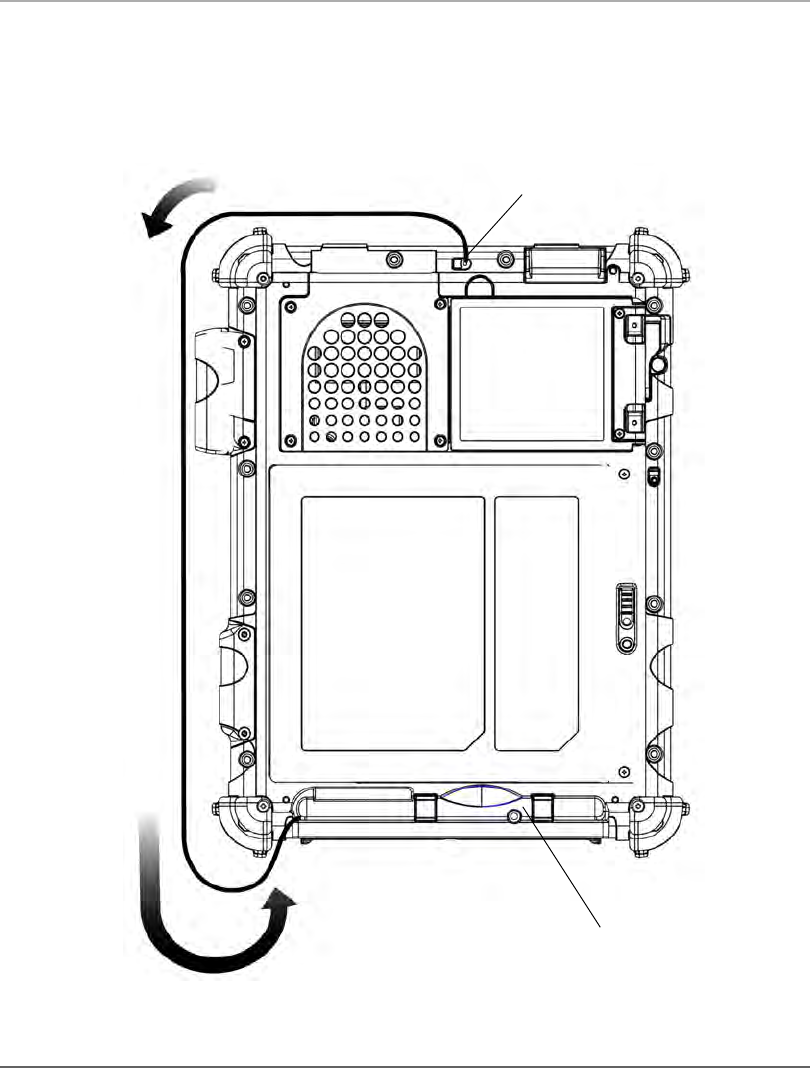
Chapter 2. Using the Tablet
Using the pen
iX104C5 User’s Handbook 37
Tether anchored on the side
pen
tether
pen
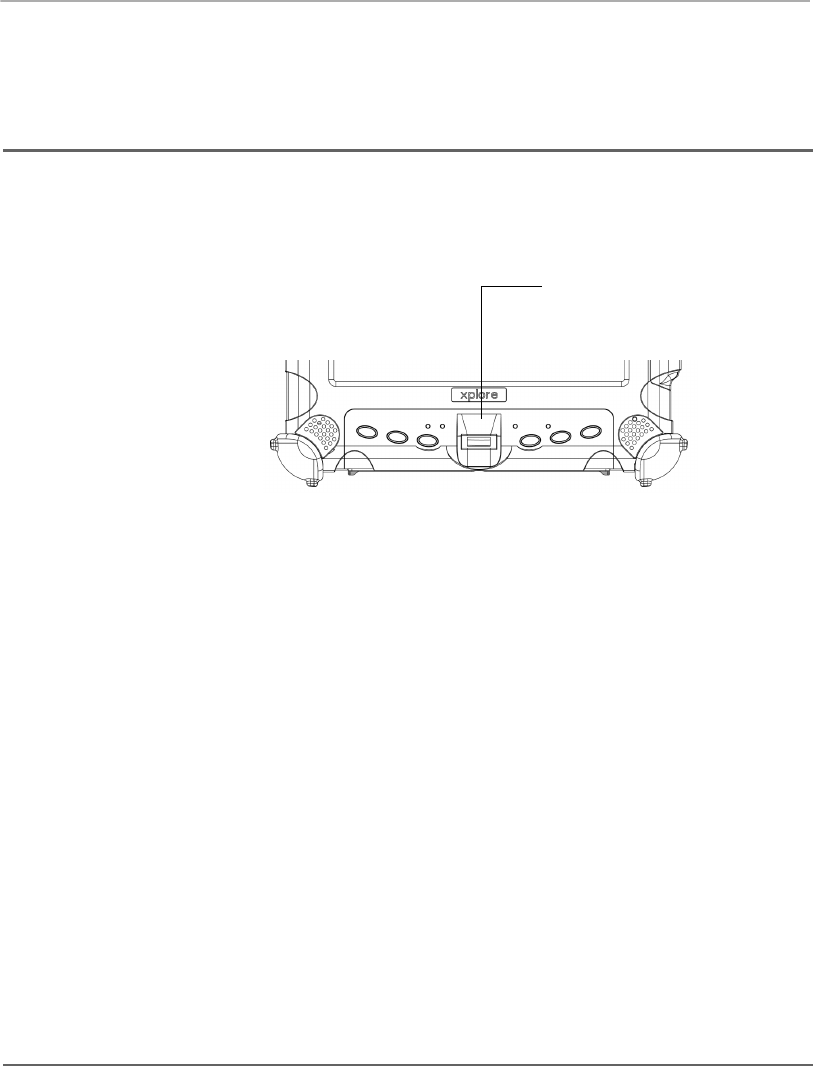
Chapter 2. Using the Tablet
Using the fingerprint scanner
38 iX104C5 User’s Handbook
Using the fingerprint scanner
The fingerprint scanner and the associated Protector Suite 2009
software enable you to use fingerprint verification to protect the
security of your data.
The first step for using fingerprint verification is to enroll your
fingerprint to create an association between your username, password,
and fingerprint.
After fingerprint enrollment you will be able to:
■Use your fingerprint as part of computer login security.
■Register Web pages and Windows applications to use your
fingerprint instead of passwords.
■Launch applications by swiping your finger the sensor.
■Store confidential information in an encrypted form in a
protected folder.
To launch the Enrollment Wizard, select:
Start > All Programs > Protector Suite > Control Center >
User Enrollment and follow the wizard’s instructions.
For more information about using the fingerprint scanner, see the
Protector Suite 2009 User’s Guide PDF included on your hard disk in
the Protector Suite 2009 folder.
Fingerprint scanner
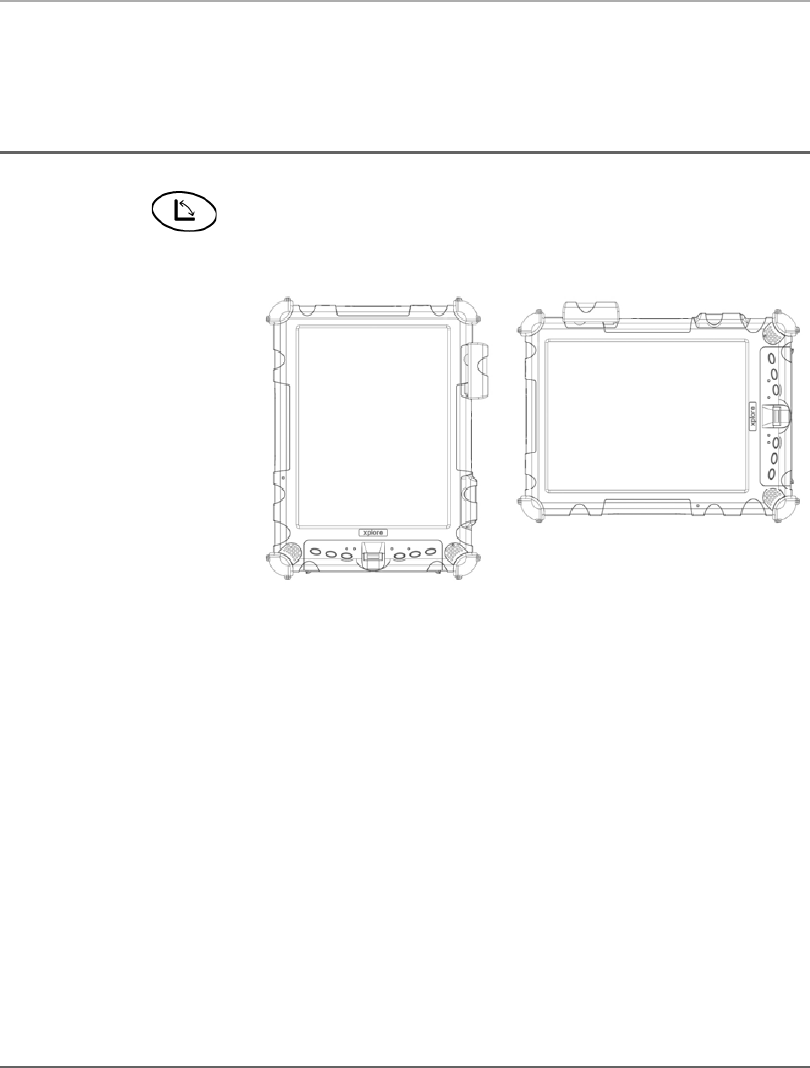
Chapter 2. Using the Tablet
Changing the screen orientation
iX104C5 User’s Handbook 39
Changing the screen orientation
To rotate the screen orientation from portrait (vertical) to landscape
(horizontal) mode or from landscape to portrait mode, press the
screen rotation key.
portrait mode landscape mode
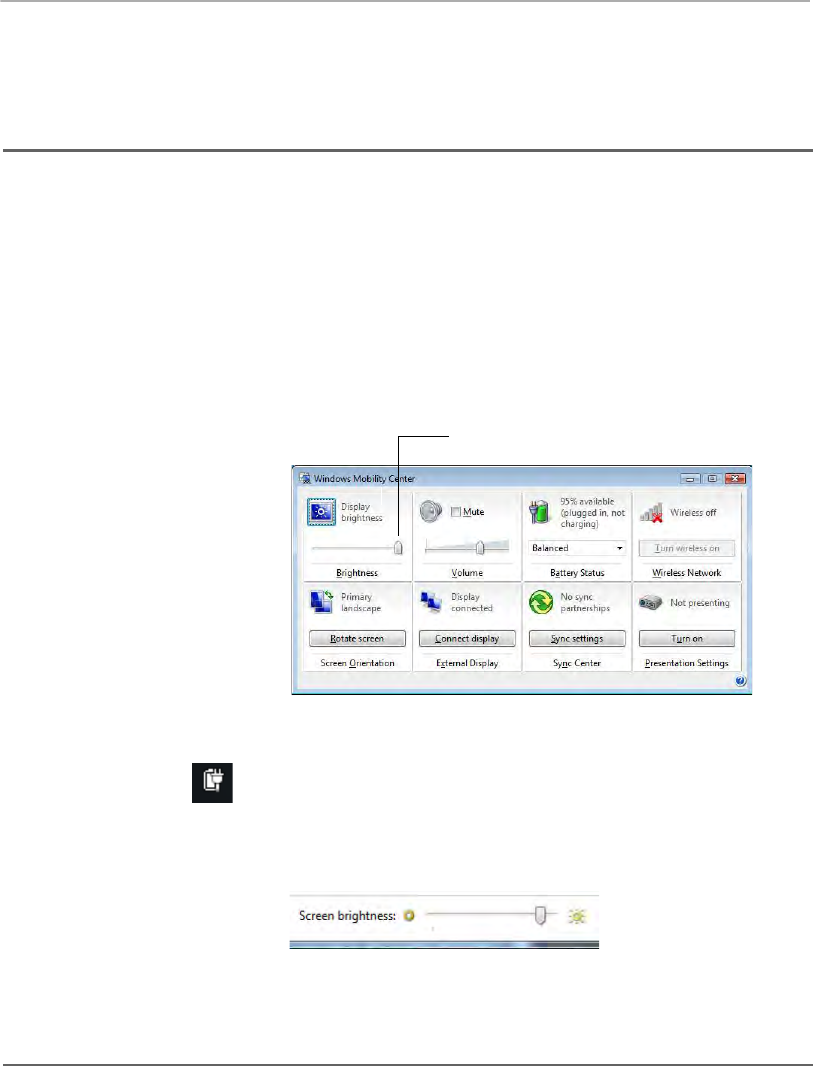
Chapter 2. Using the Tablet
Adjusting the screen brightness
40 iX104C5 User’s Handbook
Adjusting the screen brightness
Use either of the following methods to adjust the screen brightness:
Method 1
1. Click Start.
2. Open the Control Panel.
3. In the Hardware and Sound area, select Adjust commonly used
mobility settings. Use the Brightness slider to adjust the
brightness.
Method 2
1. In the Windows tasbar, click the power management icon; then
select Adjust screen brightness.
2. Move the slider bar (located at the bottom of the window) to
change the screen brightness.
Display brightness slider
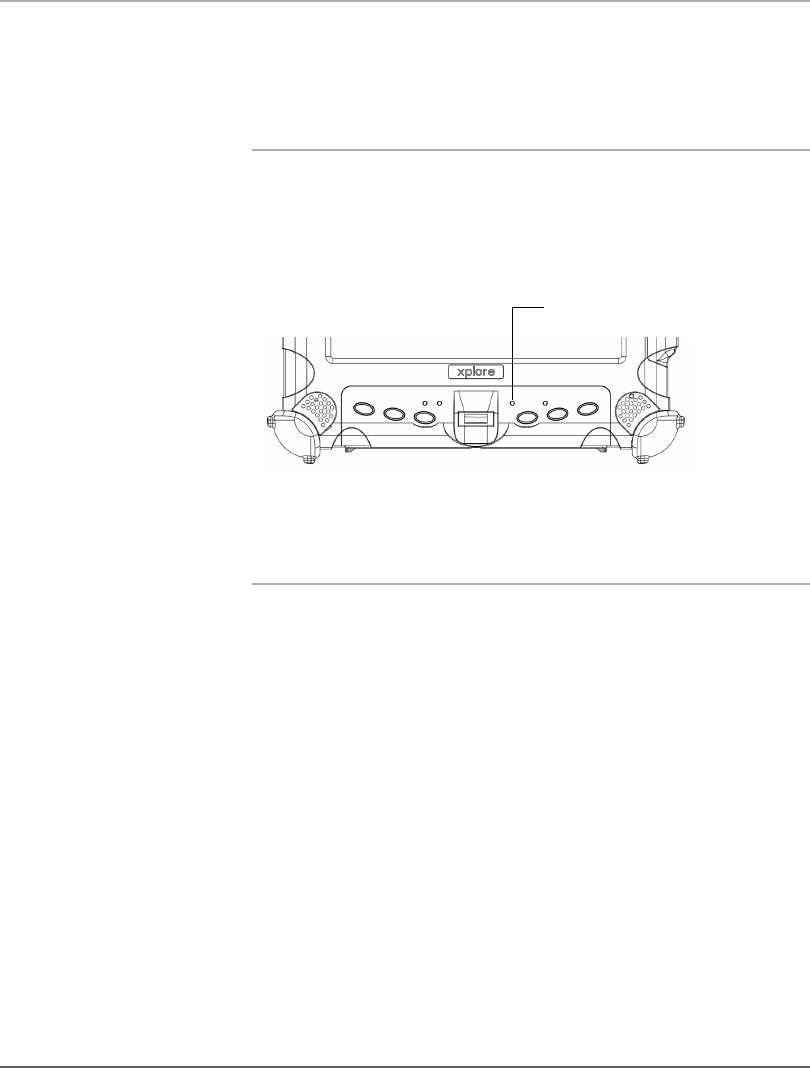
Chapter 2. Using the Tablet
Adjusting the screen brightness
iX104C5 User’s Handbook 41
Enabling automatic backlight control
When the Auto Light sensor is enabled, the computer automatically
controls the amount of backlight sent to the screen to provide
optimum brightness for the lighting conditions in which you are
working.
To enable automatic backlight control, see page 80.
Optimizing screen settings for outdoor use
1. Click Start > Control Panel > Appearance and Personalization >
Personalization > Change desktop background.
2. In the My Themes area, select High Contrast White.
3. Click the Back button.
4. Click Display.
5. Click Medium - 125% to enlarge the icon size; then click Apply.
6. Click Adjust Resolution. Make sure the screen resolution setting is
1024 by 768 pixels; then click OK.
Auto Light sensor
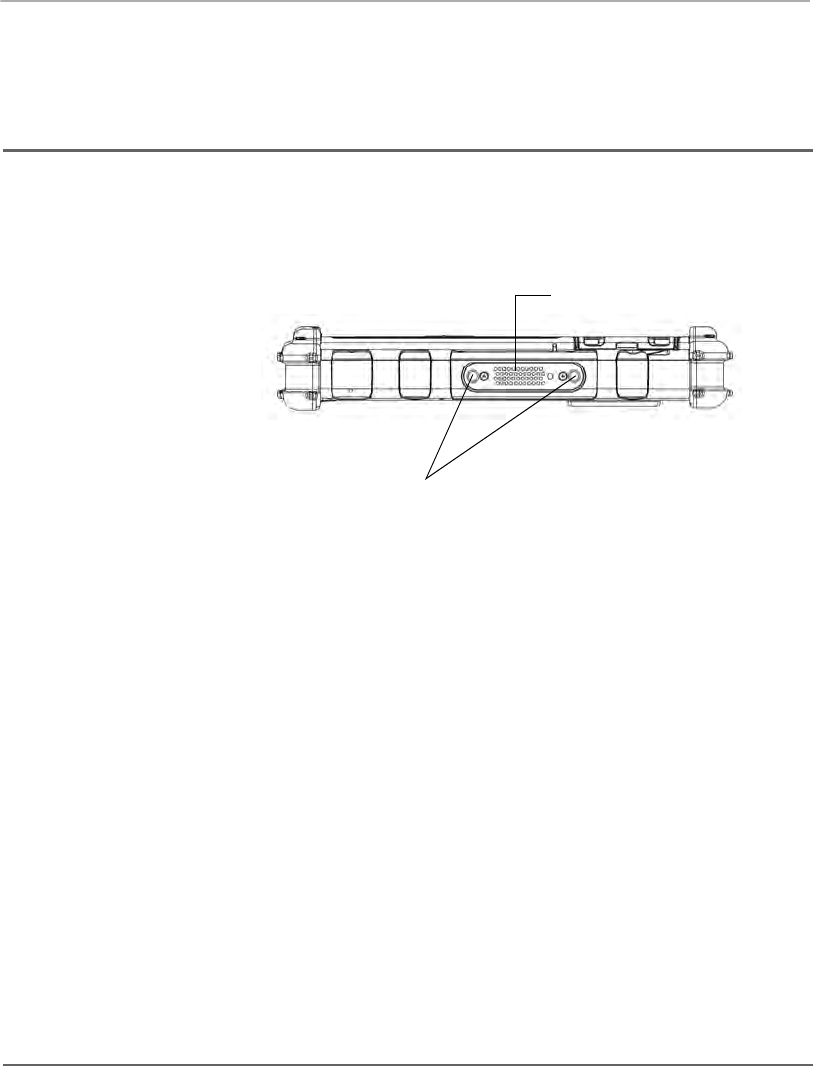
Chapter 2. Using the Tablet
Docking the tablet
42 iX104C5 User’s Handbook
Docking the tablet
If you have the optional xStand office dock or xDock vehicle dock,
connect it to the tablet at the docking port. (See the iX104 Docking
Stations Handbook.)
Docking port
Guide pin receptacles
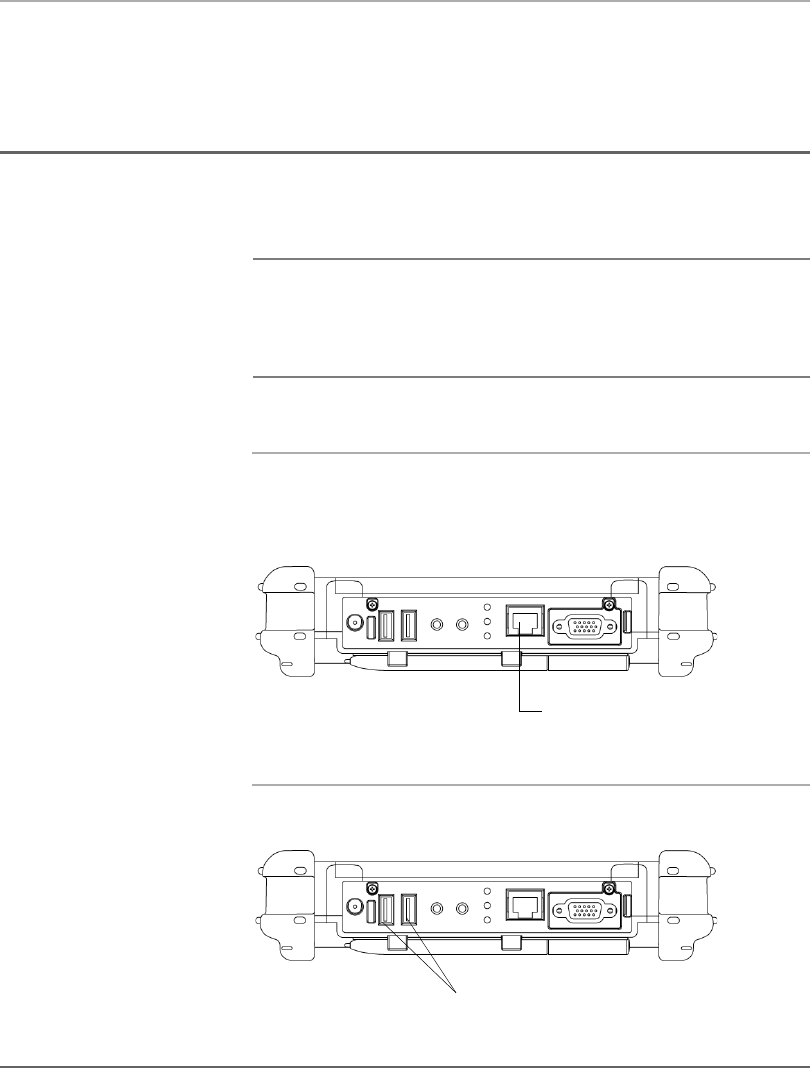
Chapter 2. Using the Tablet
Connecting devices
iX104C5 User’s Handbook 43
Connecting devices
Refer to the following subsections for information about connecting
external devices to your computer.
Note: If the device you want to use does not appear to be
working with your computer, the device may need to be enabled
in the computer’s configuration program. Contact your local help
desk or Xplore reseller.
Connecting to a local area network
Connect a local area network (LAN) cable’s RJ-45 connector to the
internal LAN interface card. (See your network system administrator
for more information.)
Connecting USB-compatible devices
Connect any USB-compatible devices to the computer’s USB ports.
LAN connector
USB ports
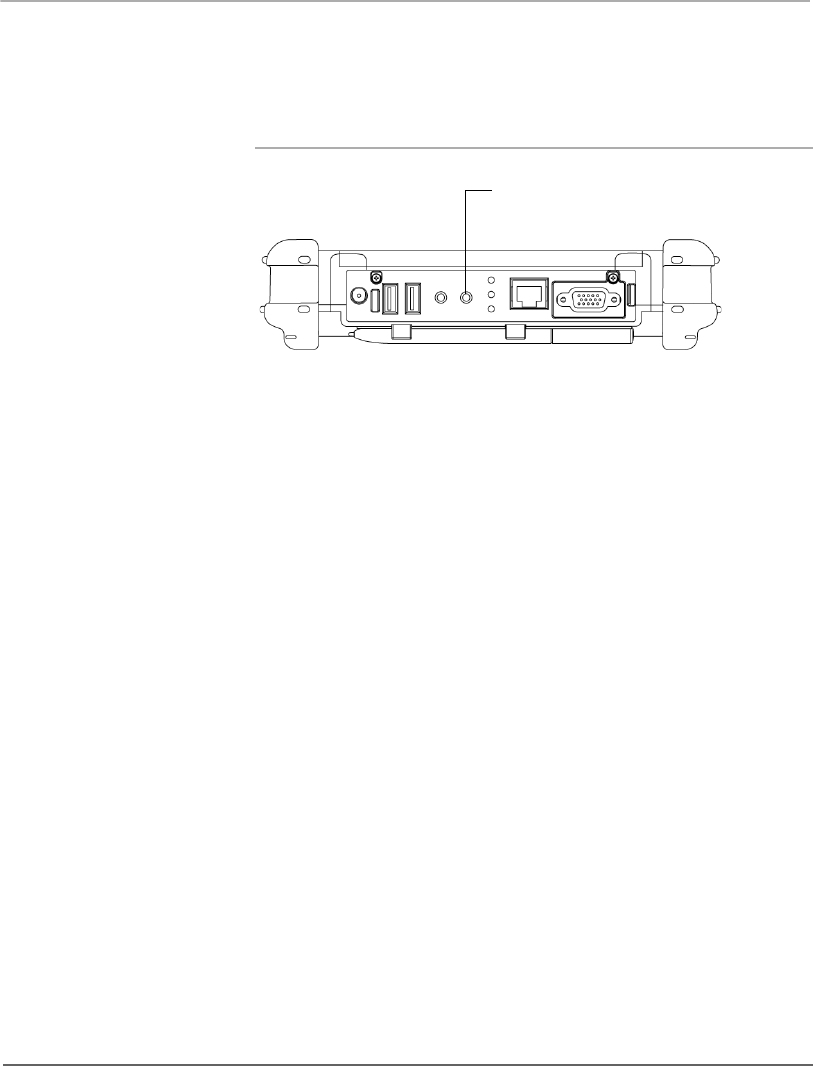
Chapter 2. Using the Tablet
Connecting devices
44 iX104C5 User’s Handbook
Connecting an external microphone
Adjusting microphone volume
If necessary, adjust the volume of the microphone as follows:
1. Press the Windows Start key; then open the Control Panel.
2. Select Hardware and Sound; then select Sound.
3. Select the Recording tab.
4. Select Microphone; then select Properties.
5. Select the Levels tab.
6. Adjust the microphone volume or boost.
7. Click OK.
microphone
connector
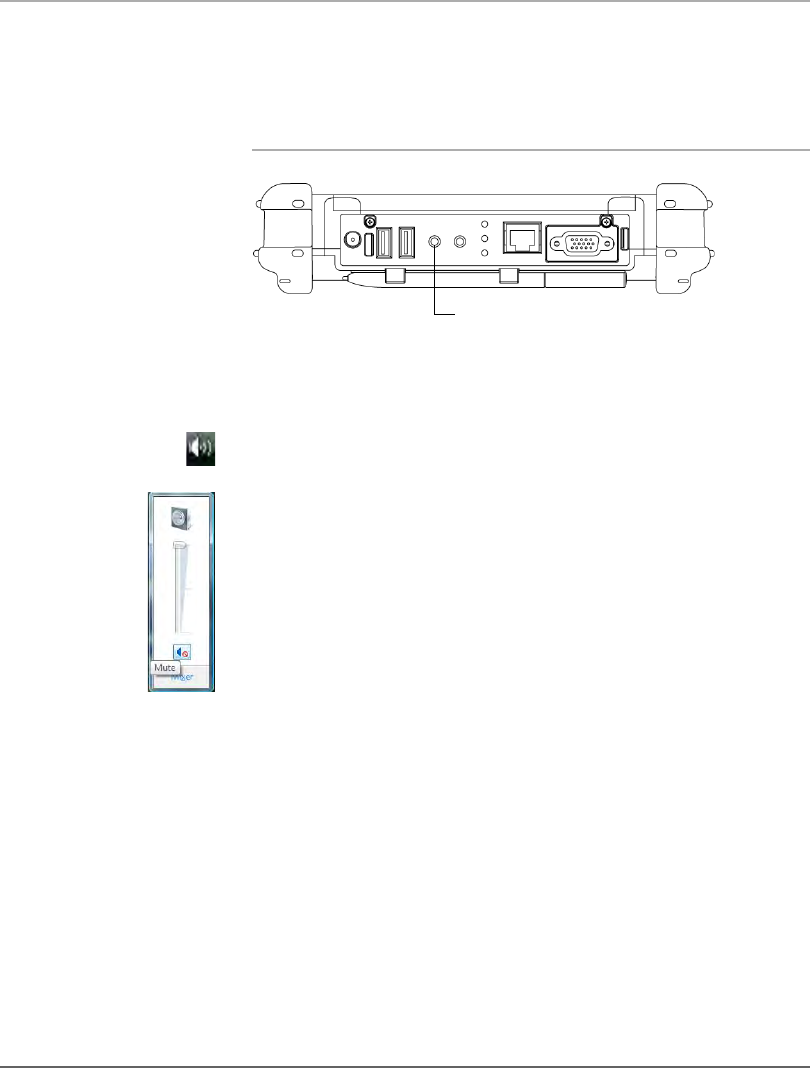
Chapter 2. Using the Tablet
Connecting devices
iX104C5 User’s Handbook 45
Connecting a headphone or speakers
Adjusting headphone or speaker volume
1. Click the audio icon in the Status area of the Windows taskbar.
The volume control area opens.
2. If the Mute button indicates that sound is muted, click the button
to turn on the sound.
3. Move the slider bar up or down to increase or decrease the
volume.
headphone/speakers
connector
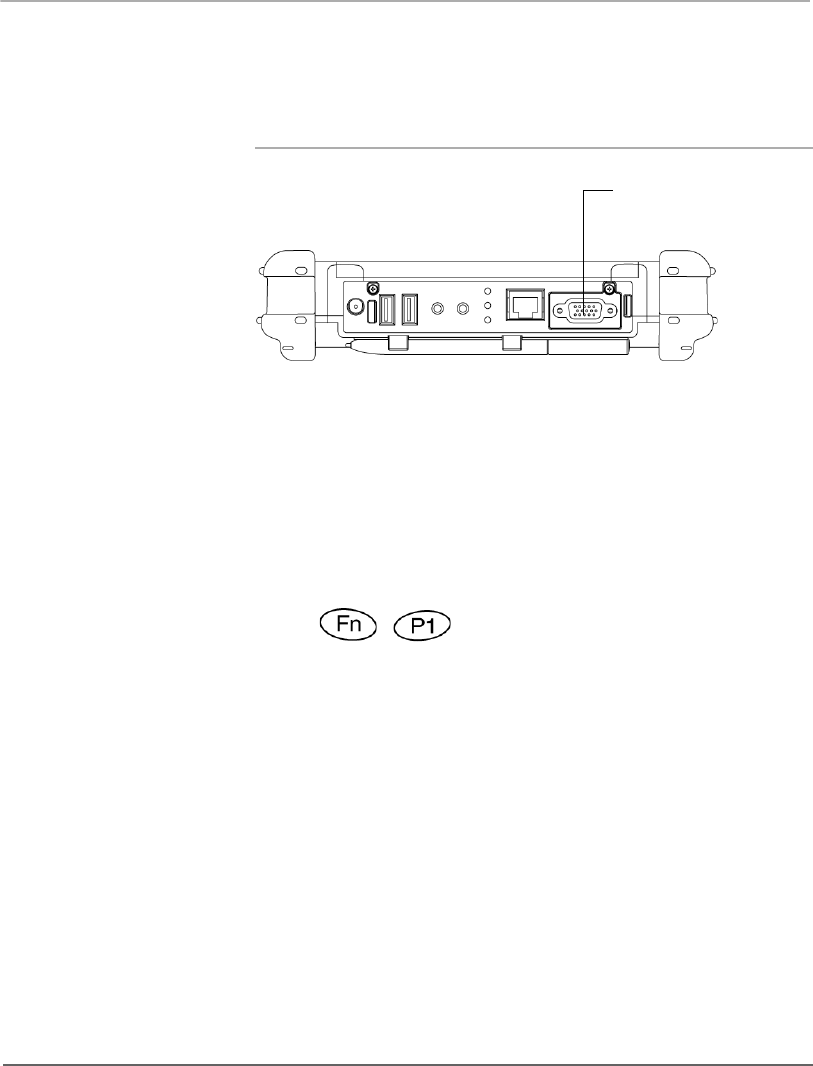
Chapter 2. Using the Tablet
Connecting devices
46 iX104C5 User’s Handbook
Connecting a monitor or projection panel (optional)
Activating the monitor or projection panel
If your tablet includes the optional monitor/projection panel
connector, you can change the video output as follows:
To change the video output to the monitor or projection
panel:
Press the Fn-P1 key combination.
To change the video output back to the computer:
Press the Fn-P1 key combination again.
Monitor/projection
panel connector
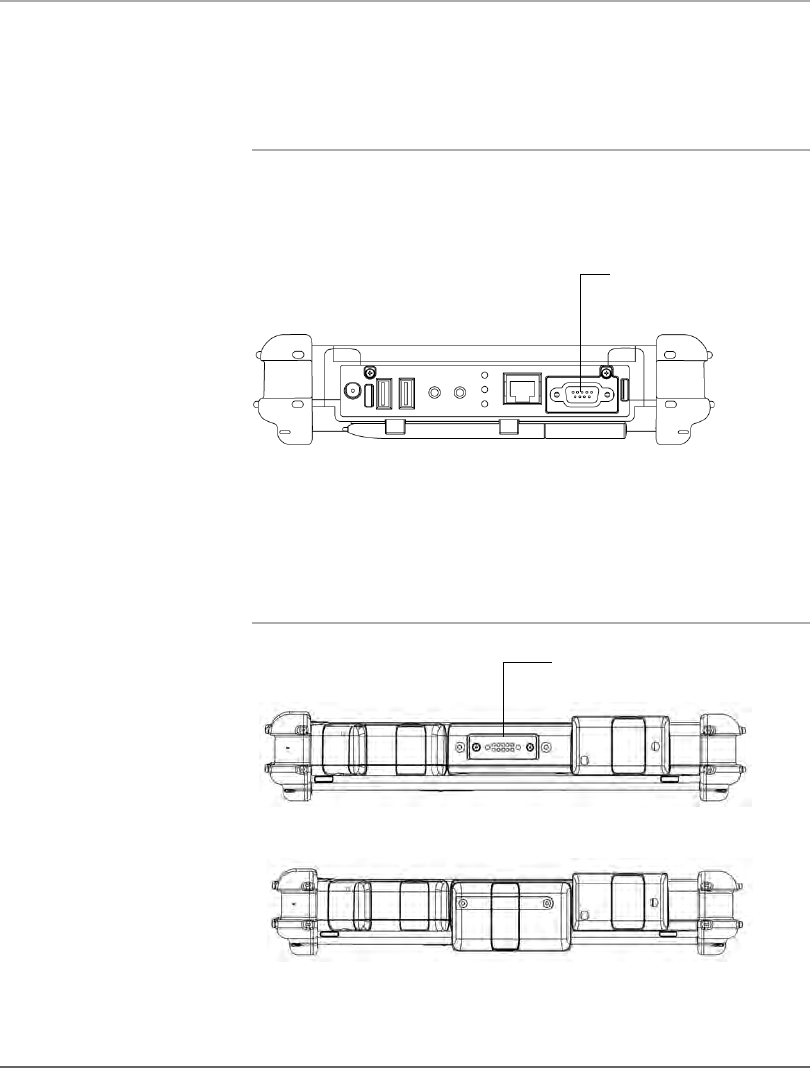
Chapter 2. Using the Tablet
Connecting devices
iX104C5 User’s Handbook 47
Connecting a device to the serial port (standard)
If your tablet includes the standard serial port, you can connect a
terminal or other device that uses the RS-232, RS-422, or RS-485
data transfer standard.
Connecting an XPL expansion module
9-pin serial port
XPL expansion port
Tablet with optional GPS II
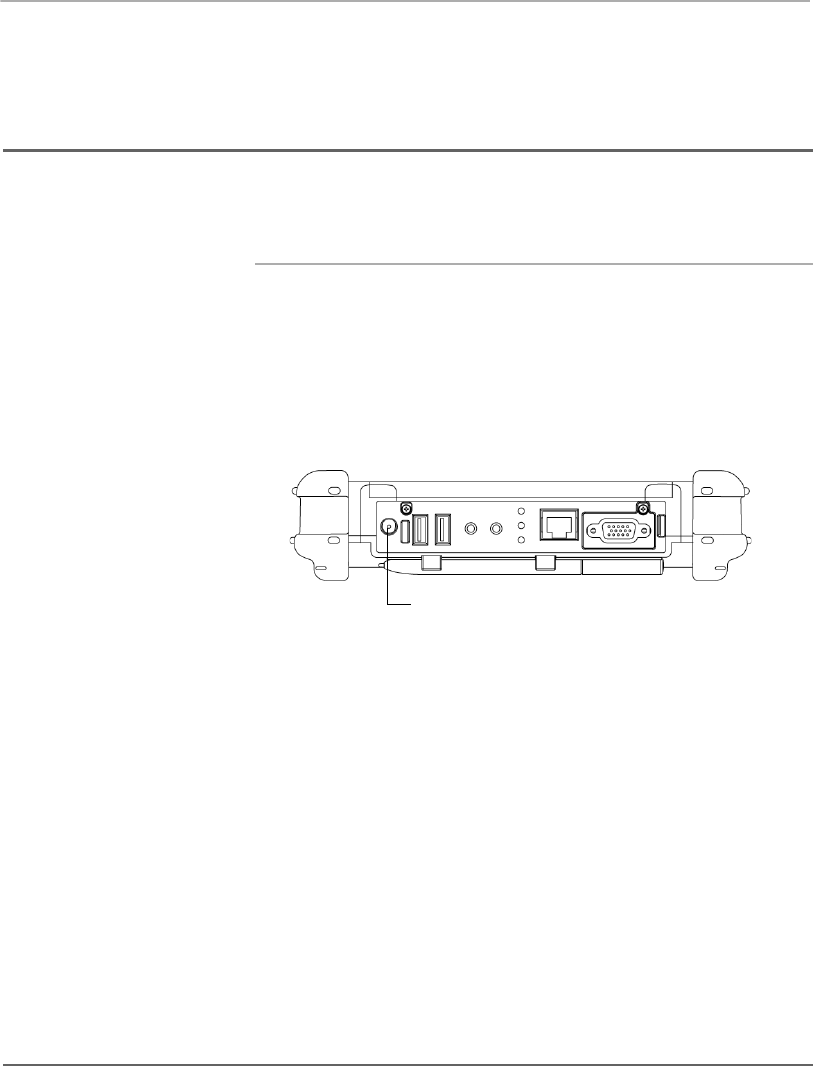
Chapter 2. Using the Tablet
Using the battery
48 iX104C5 User’s Handbook
Using the battery
You can recharge, remove, and replace the battery pack.
Charging the battery pack
If you do not have an external battery charger
Follow these steps to charge the battery while it is installed in the
computer:
1. Connect a power source, such as an AC adapter or cigarette
lighter adapter, to the power connector on the computer.
If the battery charge is below 95%, the battery begins charging
and the Status LED flashes green. (If the battery charge is higher
than 95%, the battery will not charge, preventing battery
overcharge.)
2. Check the level of charge. (See “Checking battery power status”
on page 52.)
The charging process continues until the battery charge
reaches 100%.
Power
connector

Chapter 2. Using the Tablet
Using the battery
iX104C5 User’s Handbook 49
Table 4 shows the approximate time required to charge the battery
level to 100%.
If you have an external battery charger
1. Remove the battery pack (see page 49).
2. Use the external battery charger to charge the battery.
3. Install the battery (see page 51).
Removing and installing the battery
You can remove the battery and use an (optional) external charger to
charge it.
Removing the battery
1. To swap with a charged battery:
Use one of the methods described in “Suspending operation”
on page 32 to suspend operation.
If a charged battery is not available:
Save your work and close all running programs; then shut
down the computer or put the computer in Hibernation mode
(see “Suspending operation” on page 32).
Note: To avoid losing unsaved data, wait until the computer
has completed switching to Hibernation mode before
removing the battery.
Table 4 Approximate battery charge time
Battery pack capacity Charge time Battery pack P/N
55 watt hours (7600 mAh) 1.5 hours 11-01018
68.5 watt hours (9250 mAh) 2.5 hours 11-01019
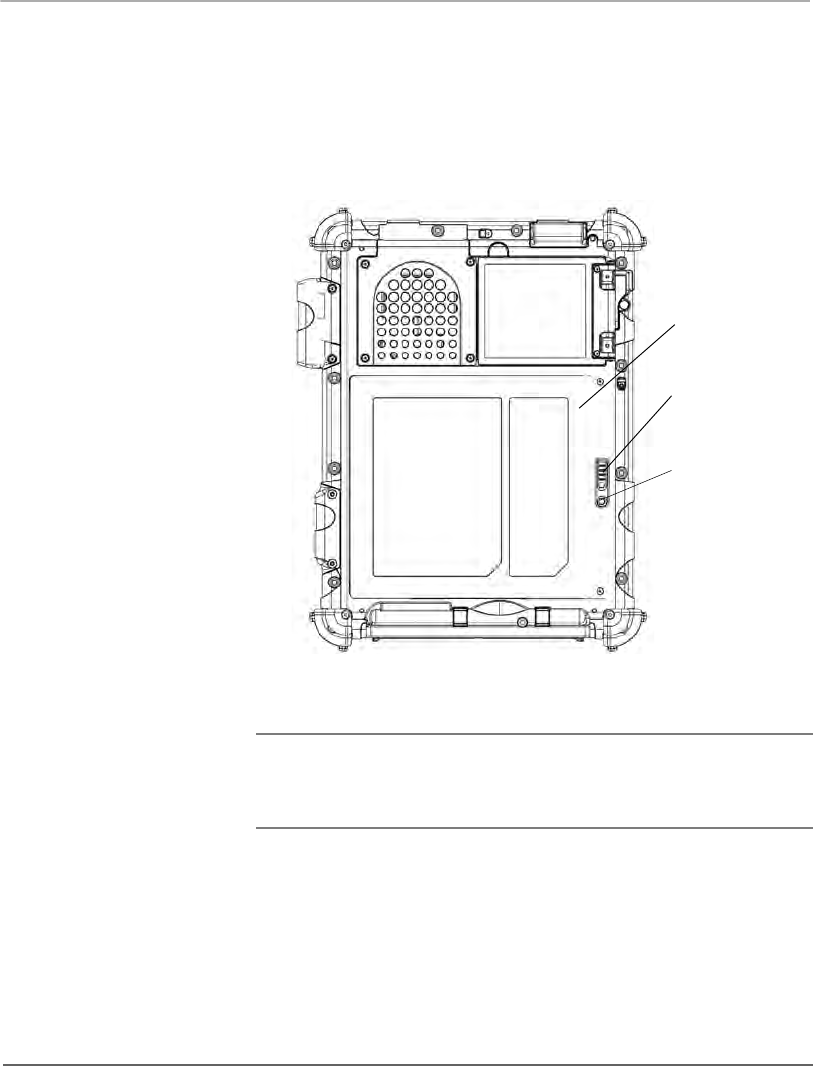
Chapter 2. Using the Tablet
Using the battery
50 iX104C5 User’s Handbook
2. Use the stylus or a pen to depress the battery lock button.
The battery release latch returns to its original position.
3. Pull the battery away from the computer and remove it.
Note: After removing the battery, you must replace the battery
or connect the computer to an external power supply within
3 to 5 minutes or the computer completely loses power.
Removable
battery
Battery release
latch
Battery lock
button
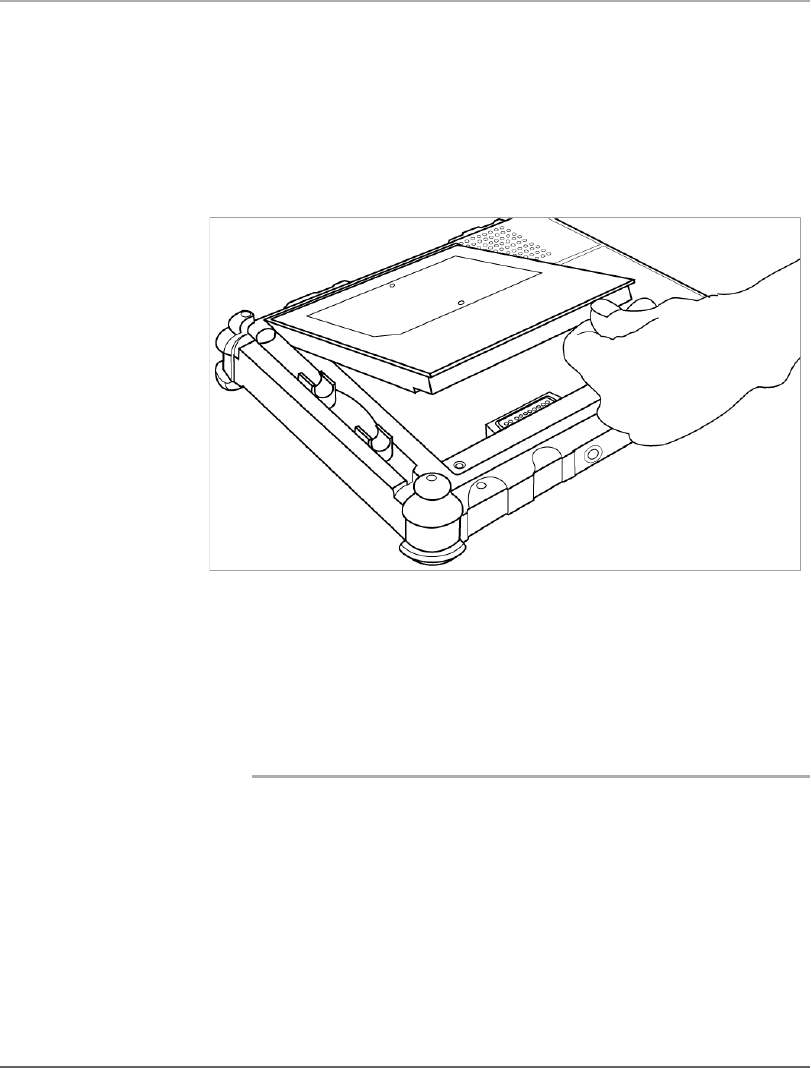
Chapter 2. Using the Tablet
Using the battery
iX104C5 User’s Handbook 51
Installing the battery
1. Orient the battery with the slides in the empty battery tray.
2. Slide the battery into the tray and press it firmly until it is seated.
3. Slide the battery release latch to its original position.
The lock button pops back into the locked position, securing the
battery in place.
Discarding batteries
Dispose of batteries in accordance with your local government
regulations. Under federal, state, or local law, it may be illegal to put
batteries in the trash. Contact your system administrator, municipal
waste disposal department/provider for information.
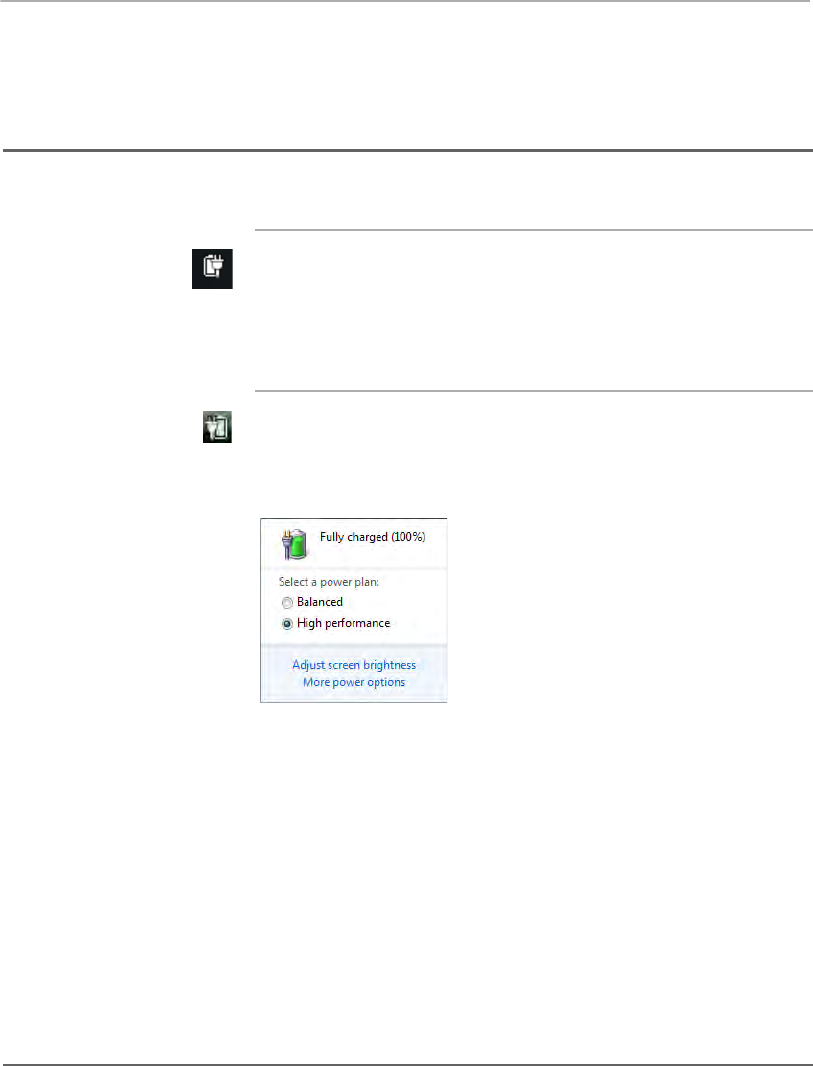
Chapter 2. Using the Tablet
Using power options
52 iX104C5 User’s Handbook
Using power options
Displaying power options
On the Windows taskbar, click the battery icon; then select More
power options. The Power Options window opens.
Checking battery power status
On the Windows taskbar, click the battery icon.
The following window opens, displaying the percentage of power
remaining in the battery:
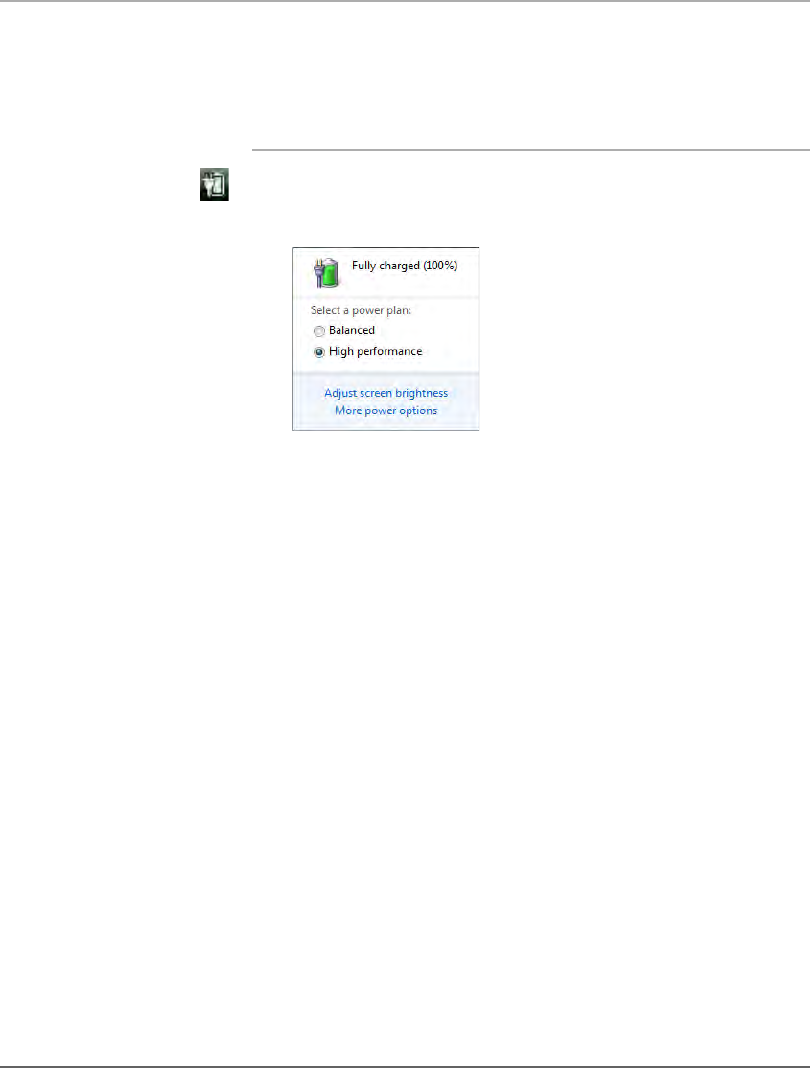
Chapter 2. Using the Tablet
Using power options
iX104C5 User’s Handbook 53
Selecting a power plan
1. On the Windows taskbar, click the battery icon.
The following window opens:
2. Select one of the following power plans: (select More power
options in necessary)
Balanced – Balance between computer performance and battery
life.
Power Saver – Longer battery life and lower performance.
High performance – Higher performance and shorter battery life.
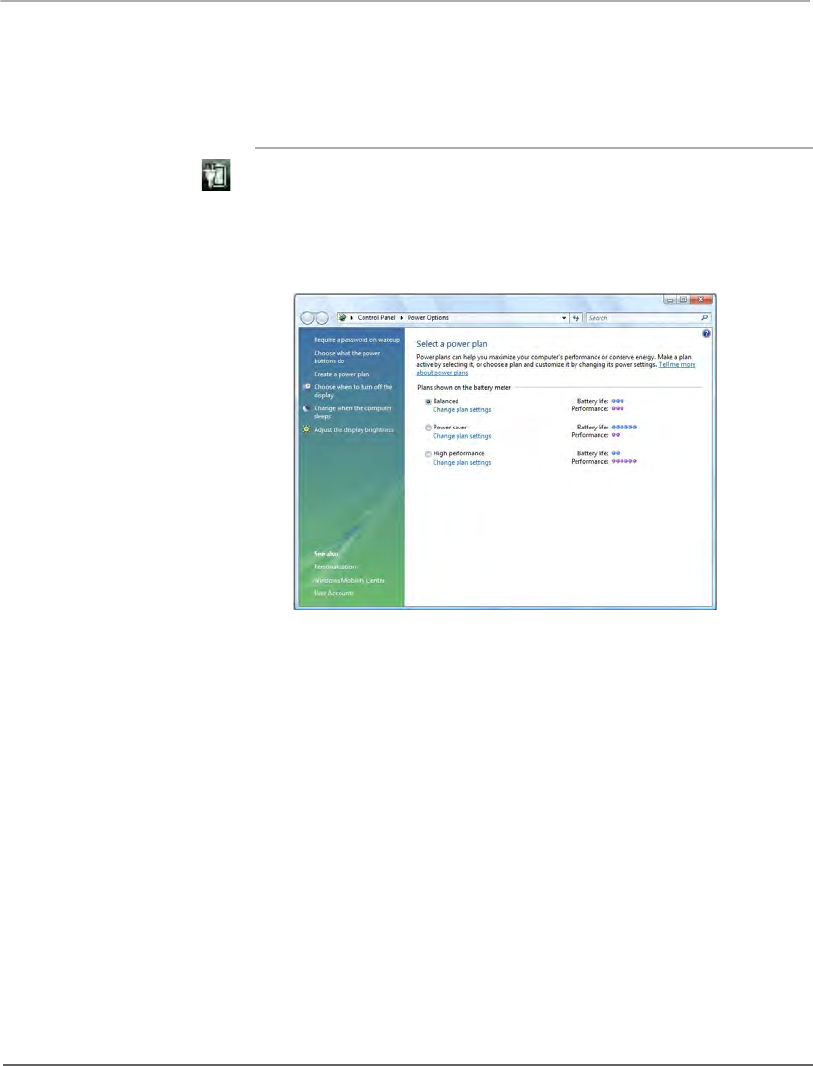
Chapter 2. Using the Tablet
Using power options
54 iX104C5 User’s Handbook
Selecting power options
1. On the Windows taskbar, right-click the battery icon.
2. Select Power Options.
The following window opens.
3. Under the selected power plan, press Change plan settings.
4. Select the power options you want to use.
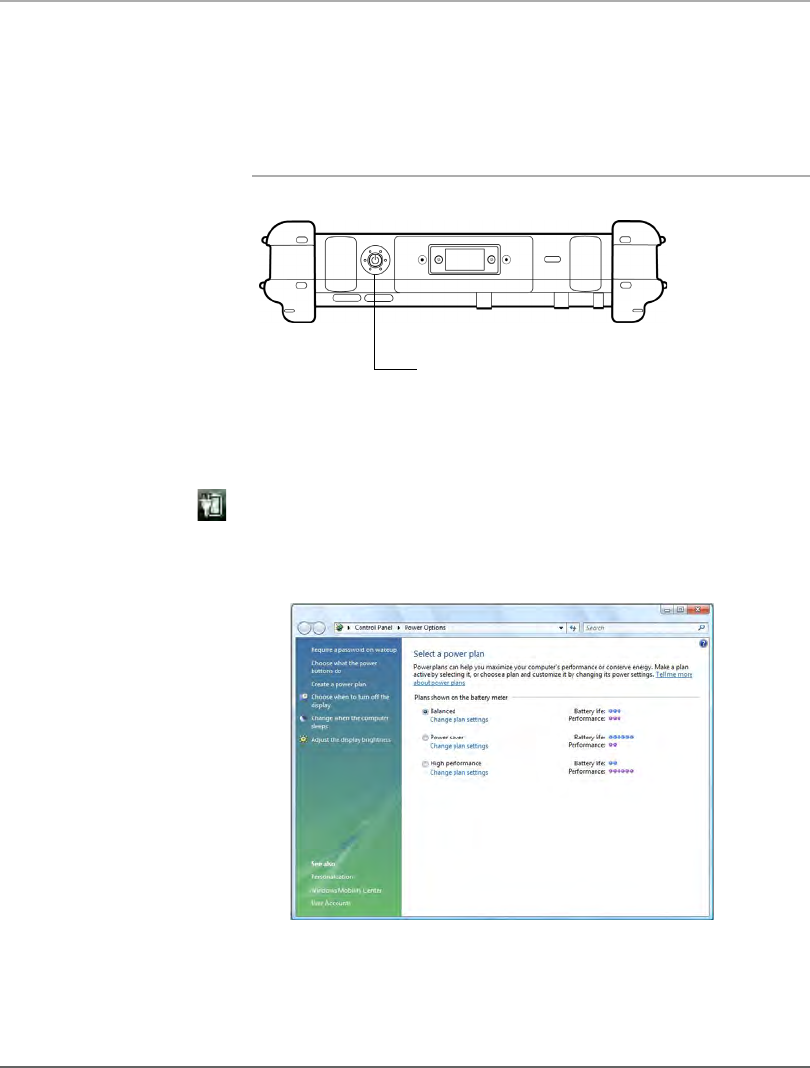
Chapter 2. Using the Tablet
Using power options
iX104C5 User’s Handbook 55
Selecting Power (On/Off)/Backlight(On/Off)/Sleep/
Resume button options
To change what happens when you press the button:
1. On the Windows taskbar, right-click the battery icon.
2. Select Power Options.
The following window opens.
3. Press Choose what the power buttons do.
4. Select the options you want to use.
Power (On/Off)/
Backlight (On/Off)/
Sleep/Resume button

Chapter 2. Using the Tablet
Using power options
56 iX104C5 User’s Handbook
Tips for conserving battery power
The following tips help you extend the life of your battery by
conserving battery power:
■Use an external power source such as the AC or auto adapter
whenever available.
■Suspend operation if you know that you will not be using the
system for a while. (See page 32.)
■If you do not plan to use the computer for an extended period of
time, turn it off.
■Adjust power options to automatically conserve power. (See
page 54.)
■Adjust the display brightness to no brighter than necessary for
comfortable viewing. The display can consume a large portion of
the computer’s power. (See page 40.)
■Set the LCD Brightness range to “Power Saving” in the BIOS
Setup Utility. (See page 79.)
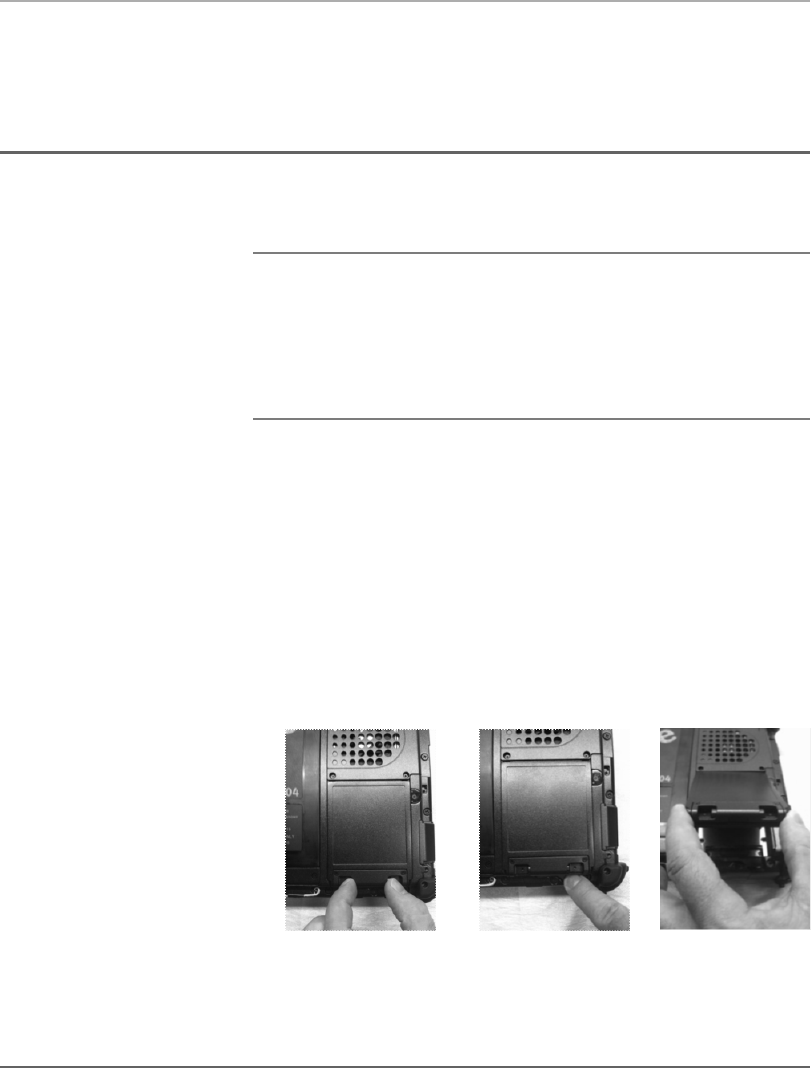
Chapter 2. Using the Tablet
Accessing the Solid State Drive (SSD) cartridge
iX104C5 User’s Handbook 57
Accessing the Solid State Drive (SSD) cartridge
When you install a new storage drive, follow the instructions in this
section to access the hard drive carrier.
WARNING Failure to follow this procedure can result in
damage to the case and the cover, which is not
covered under the Xplore Technologies warranty.
Xplore recommends that you use an
approved Xplore Technologies service center
for this procedure.
1. Turn off the computer.
2. Remove all power from the unit, including batteries and other
power sources such as power supplies, cigarette lighter adapters,
and mobile power sources.
3. Pinch the two center pins with one hand while pushing down on
the lever with the other. The drive carrier will pop up (like the
battery) and permit removal.
Note: Your drive carrier may have two screws installed. If so,
remove them before you exchange the drive carrier.
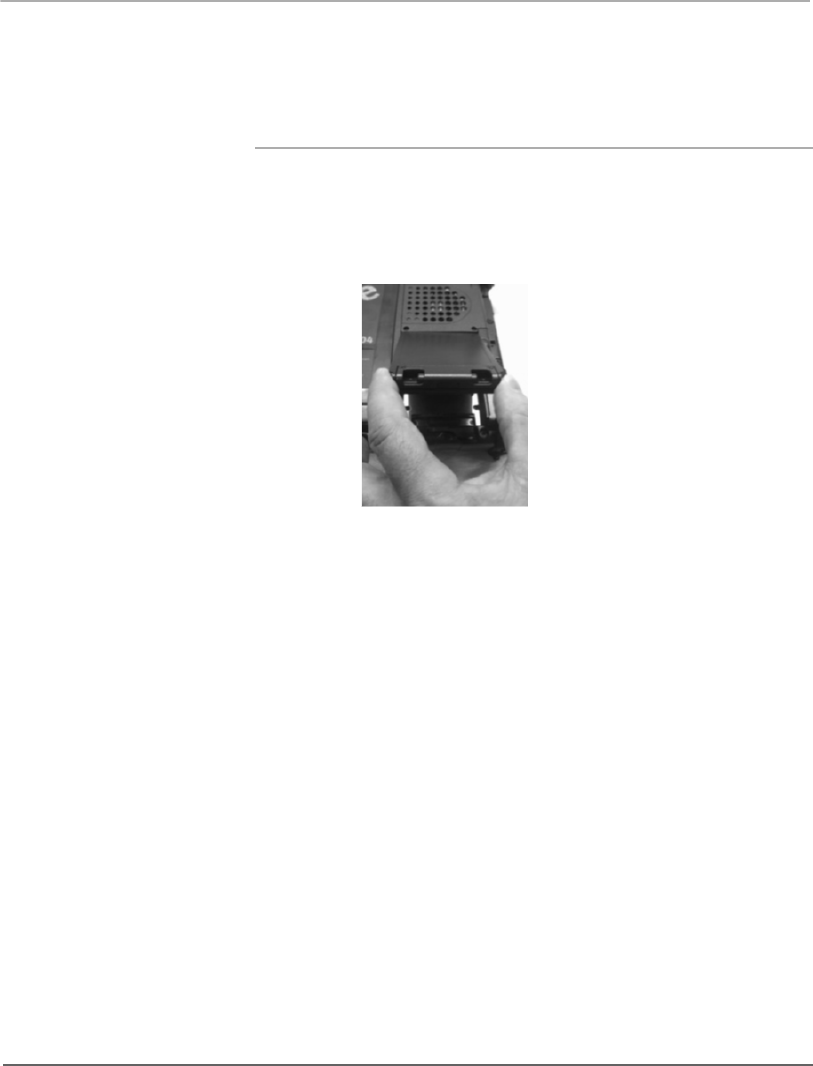
Chapter 2. Using the Tablet
Accessing the Solid State Drive (SSD) cartridge
58 iX104C5 User’s Handbook
Re-installing the drive carrier
1. Insert the drive with smooth edge into the bay at a slight angle.
2. Press down until the carrier clicks into place, while pinching the
two center pins.
3. If your machine had the screws in place, re-attach them.
Note: Do not use power tools.
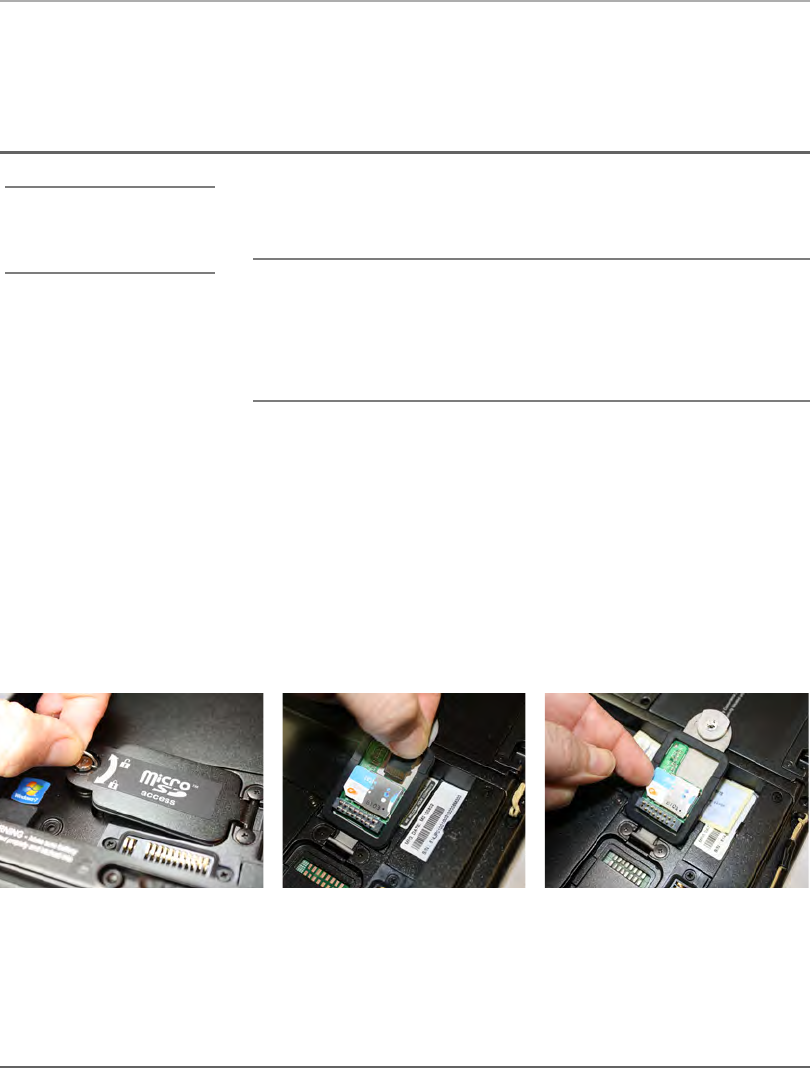
Chapter 2. Using the Tablet
Accessing the MicroSD and SIM compartment
iX104C5 User’s Handbook 59
Accessing the MicroSD and SIM compartment
When you install a MicroSD or SIM card, follow the instructions in
this section to access the compartment.
WARNING Failure to follow this procedure can result in damage
to the case and the cover, which is not covered under
the Xplore Technologies warranty. Xplore
recommends that you use an approved Xplore
Technologies service center for this procedure.
1. Turn off the computer.
2. Remove all power from the unit, including batteries and other
power sources such as power supplies, cigarette lighter adapters,
and mobile power sources.
3. Remove the battery. (See “Removing and installing the battery”
on page 49.)
4. Lift up on the D-ring and turn it clockwise ¼ of a rotation. Once
the lock is disengaged lift the door to open the compartment.
Note: This compartment can
handle most MicroSD and
SIM cards.
Opening the compartment Installing a MicroSD card Installing a SIM card
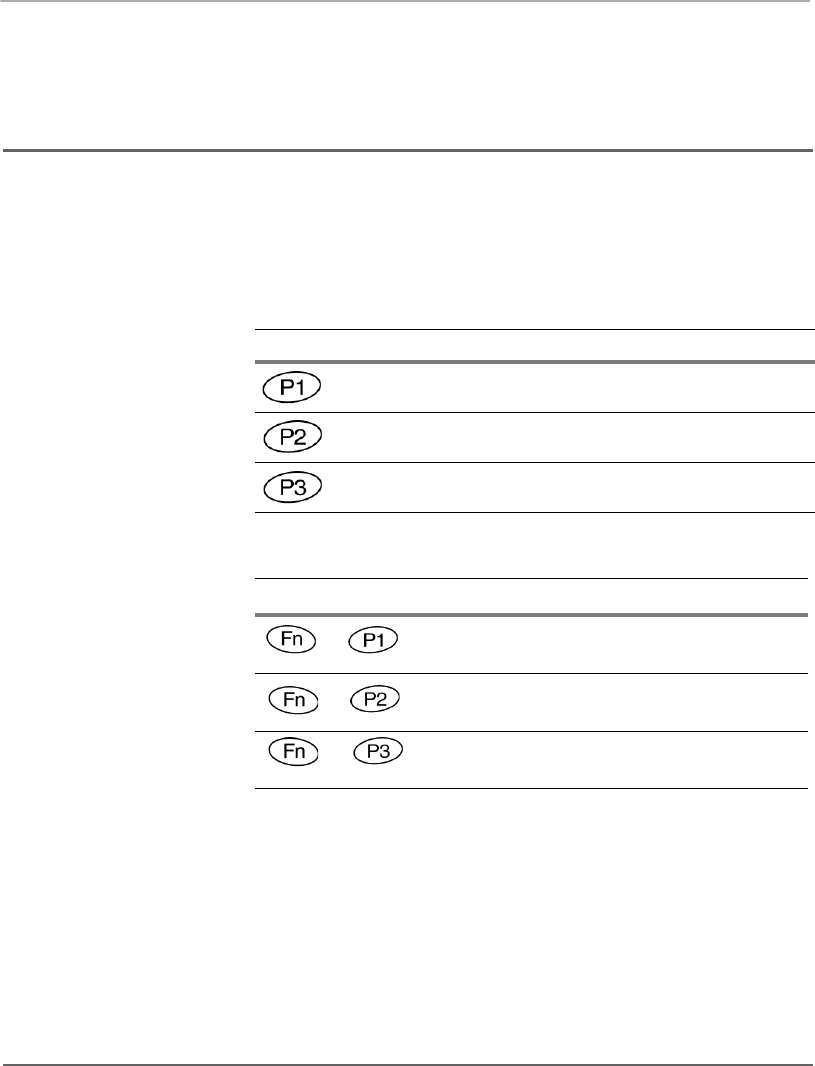
Chapter 2. Using the Tablet
Programming hot keys
60 iX104C5 User’s Handbook
Programming hot keys
Xplore pre-programs the P1, P2, and P3 hot keys and Function mode
hot key combinations to perform certain functions by default.
However, you can program them to perform different functions, as
described in this section.
Table 5 Programmable hot keys
Key Default function
Opens the Start menu.
Starts Internet Explorer.
Puts the computer in Sleep mode.
Table 6 Programmable Function mode hot key combinations
Key combination Default function
Sends video display to a monitor or projection
panel.
Airplane mode toggle.
Bluetooth toggle.
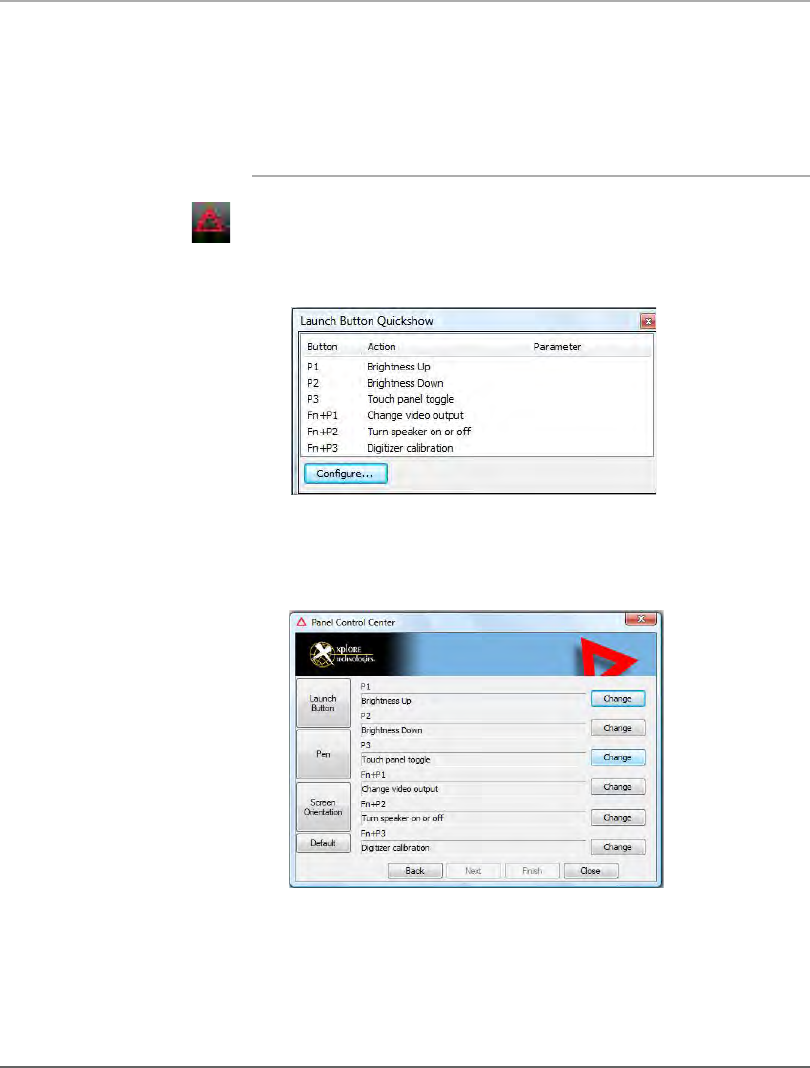
Chapter 2. Using the Tablet
Programming hot keys
iX104C5 User’s Handbook 61
Programming hot keys to start applications, open
documents, or go to a website
1. In the Status area of the Windows taskbar, click the iX104C5
Configuration icon.
The Launch Button QuickShow dialog box opens.
2. Click the Configure button.
The Panel Control Center window opens.
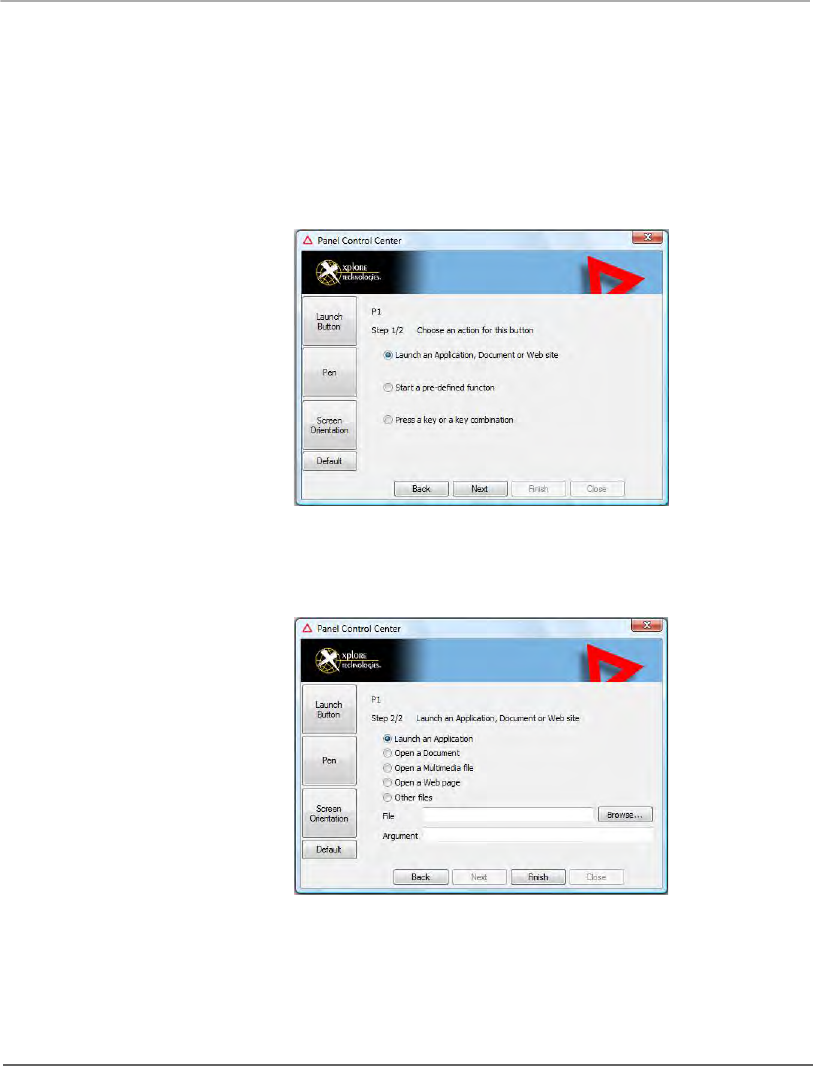
Chapter 2. Using the Tablet
Programming hot keys
62 iX104C5 User’s Handbook
3. Click the Change button next to the key or key combination you
want to program.
The following options appear:
4. Click Launch an Application, Document or Web site.
The following options appear:
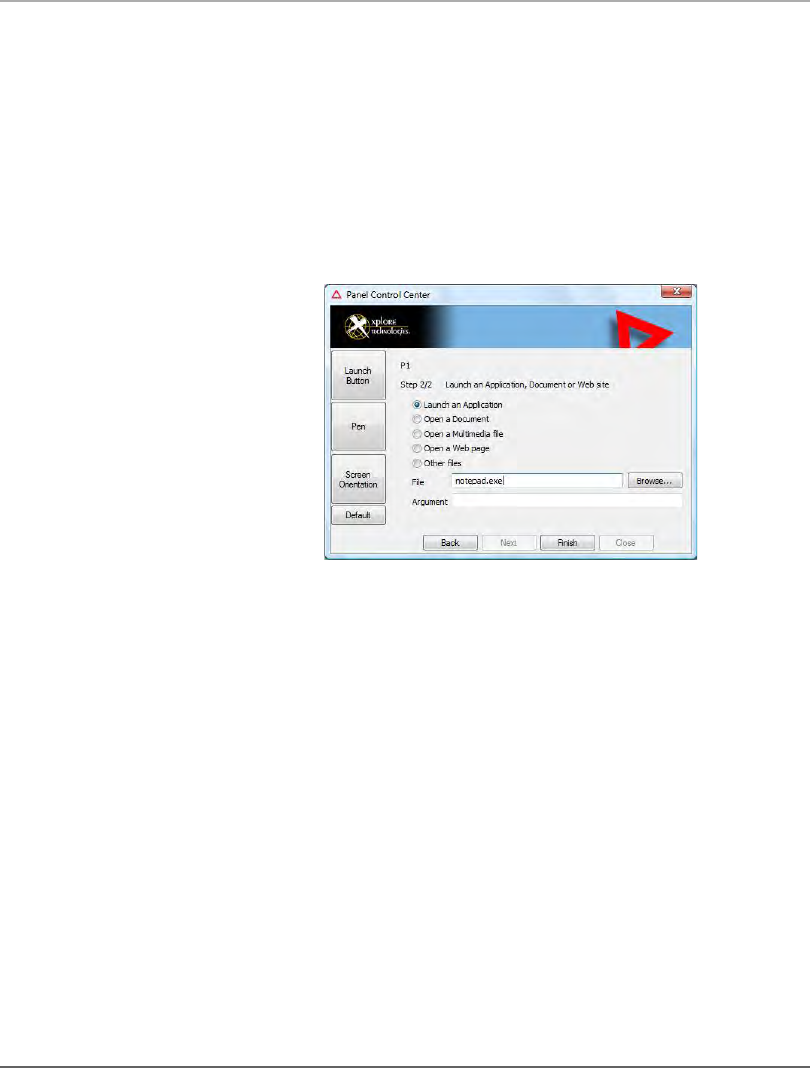
Chapter 2. Using the Tablet
Programming hot keys
iX104C5 User’s Handbook 63
5. To start an application:
a. Click Launch an Application.
b. Press Browse to find the application you want the hot key or
Function mode hot key combination to start (for example:
word.exe, notepad.exe, excel.exe).
c. Click Change.
6. To open a document:
a. In the Click Open a Document.
b. Press Browse to find the document you want the hot key or
Function mode hot key combination to open. (For example:
spreadsheet.xls, airports.doc, wiringdiagram.jpg)
c. Click Change.

Chapter 2. Using the Tablet
Programming hot keys
64 iX104C5 User’s Handbook
7. To open a multimedia file:
a. Click Open a Multimedia file.
b. Press Browse to find the name of the multimedia file you
want the hot key or Function mode hot key combination to
open. (For example: 911training.dir, demo.ppt)
c. Click Change.
8. To open a Web page:
a. Click Open a Web page.
b. Press Browse to find the URL of the Web page you want the
hot key or Function mode hot key combination to open. (For
example: http://www.xploretech.com)
c. Click Change.
9. Program more hot keys, or click Close to close the Panel Control
Center window.
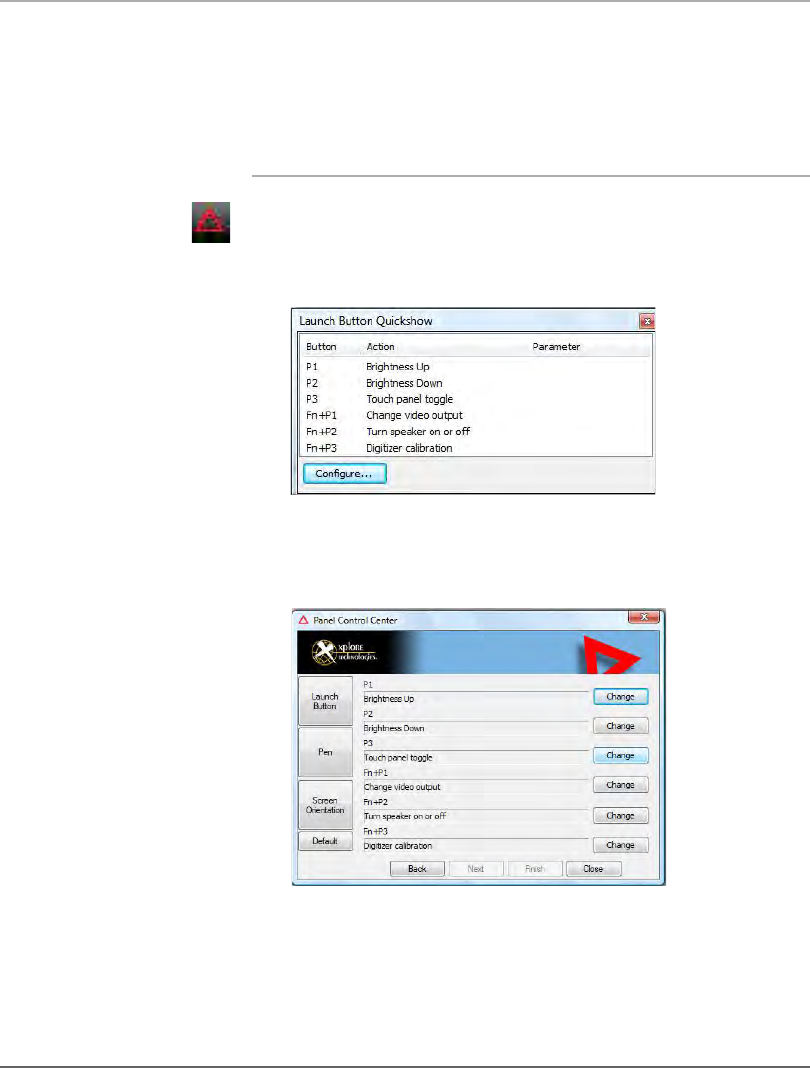
Chapter 2. Using the Tablet
Programming hot keys
iX104C5 User’s Handbook 65
Programming hot keys to perform pre-defined
functions
1. In the Status area of the Windows taskbar, click the iX104C5
Configuration icon.
The Launch Button QuickShow dialog box opens.
2. Click the Configure button.
The Panel Control Center window opens.
3. Next to the key or key combination you want to program, click
the Change button.
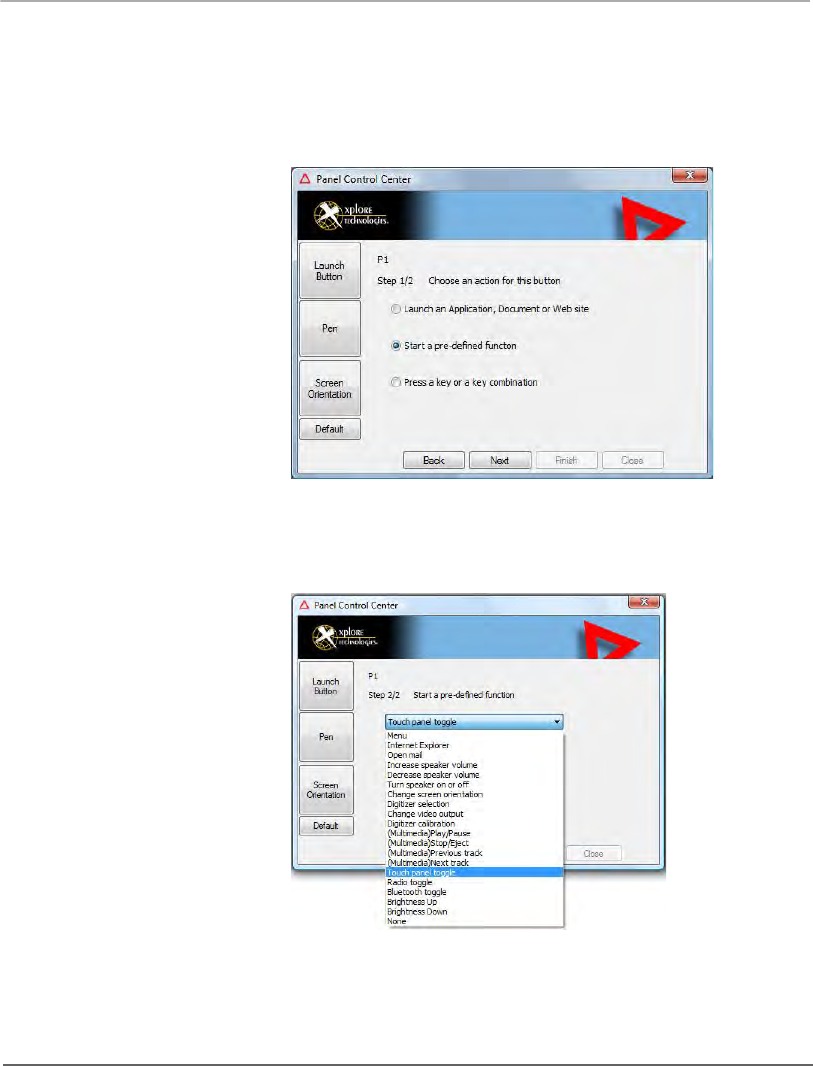
Chapter 2. Using the Tablet
Programming hot keys
66 iX104C5 User’s Handbook
The following options appear:
4. Click Start a pre-defined function.
5. In the Function selection drop-down list, select an option.
6. Program more hot keys, or click Close to close the Panel Control
Center window.
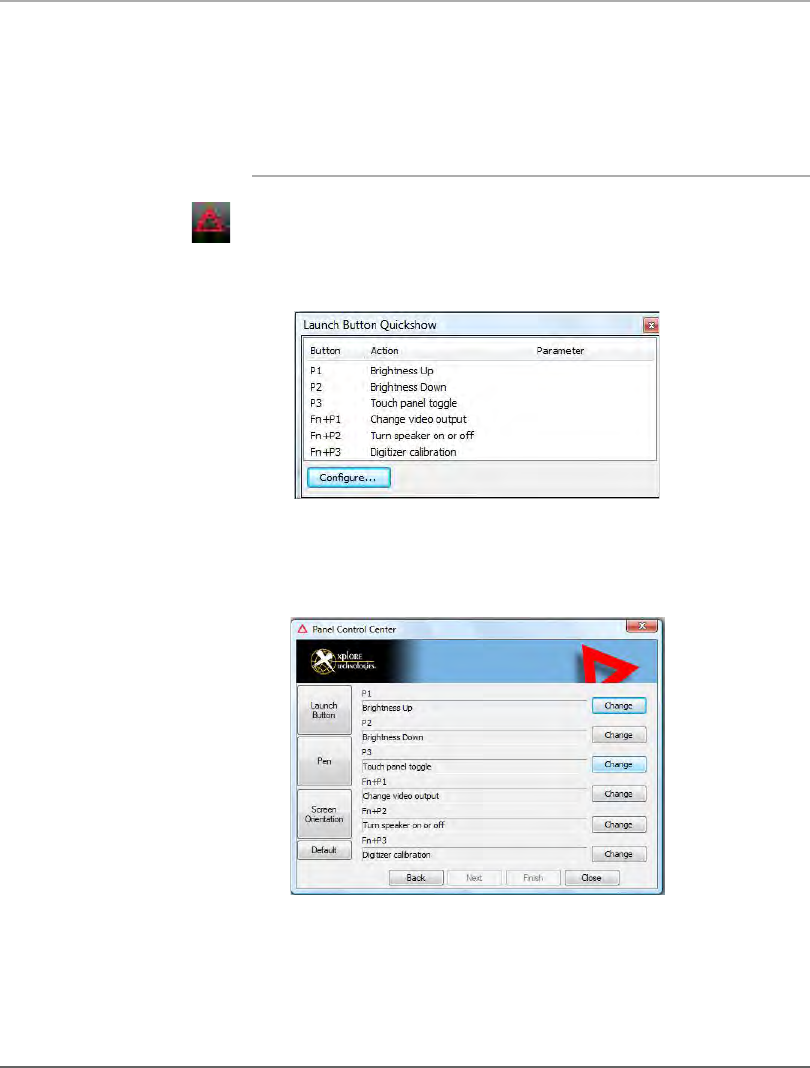
Chapter 2. Using the Tablet
Programming hot keys
iX104C5 User’s Handbook 67
Programming hot keys to perform other key
functions
1. In the Status area of the Windows taskbar, click the iX104C5
Configuration icon.
The Launch Button QuickShow dialog box opens.
2. Click the Configure button.
The Panel Control Center window opens.
3. Next to the key or key combination you want to program, click
the Change button.
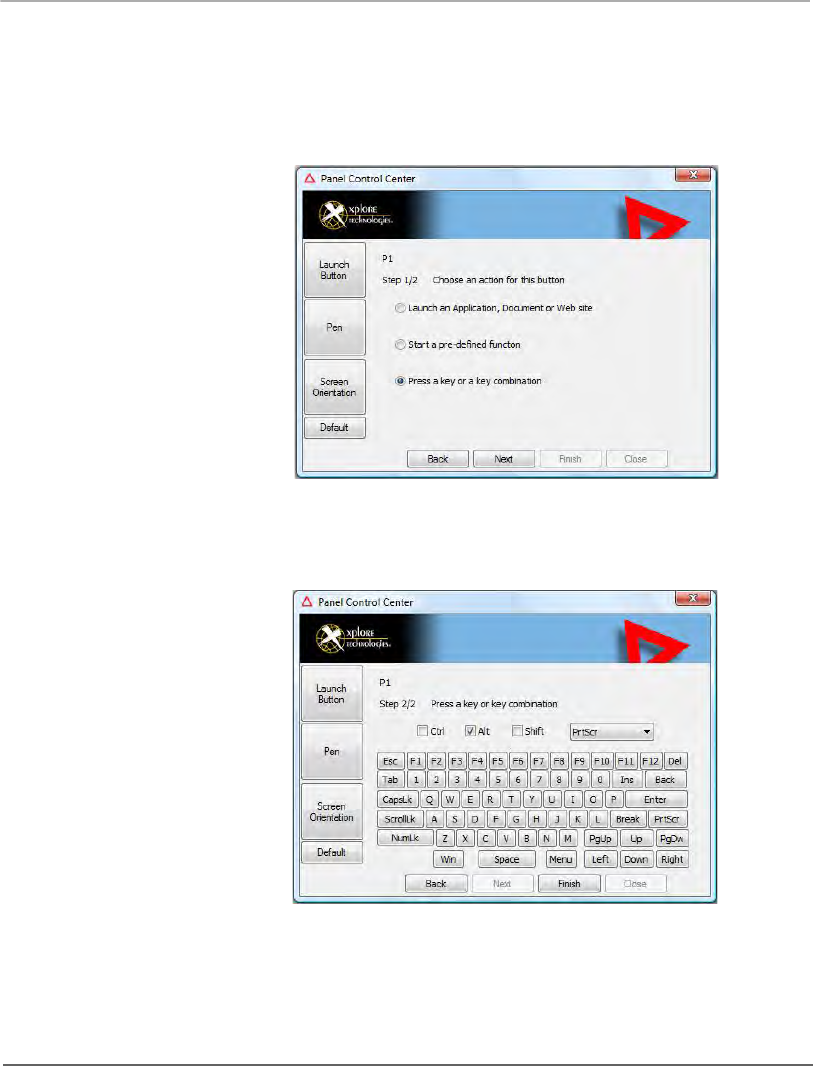
Chapter 2. Using the Tablet
Programming hot keys
68 iX104C5 User’s Handbook
The following options appear:
4. Click Press a key or key combination.
The following options appear:

Chapter 2. Using the Tablet
Programming hot keys
iX104C5 User’s Handbook 69
5. If you want the hot key or hot key combination to perform the
function of a single key:
a. If the Ctrl, Alt, or Shift boxes are checked, uncheck them.
b. Click the key you want the hot key or hot key combination to
perform. (For example: F6, G, or Caps Lock)
If you want the hot key or hot key combination to perform the
function of a key combination:
a. Check the Ctrl, Alt, or Shift box.
b. From the drop-down list, select the additional key, or click
the key on the keyboard.
Examples
To cause the hot key to perform the print screen function
(Alt-Print Scrn): Check the Alt check box; then select PrtScr
from the drop-down list.
To cause the hot key to perform the paste function (Ctrl-V):
Check the Ctrl check box; then click the V key.
6. Program more hot keys, or click Close to close the Panel Control
Center window.

70 iX104C5 User’s Handbook
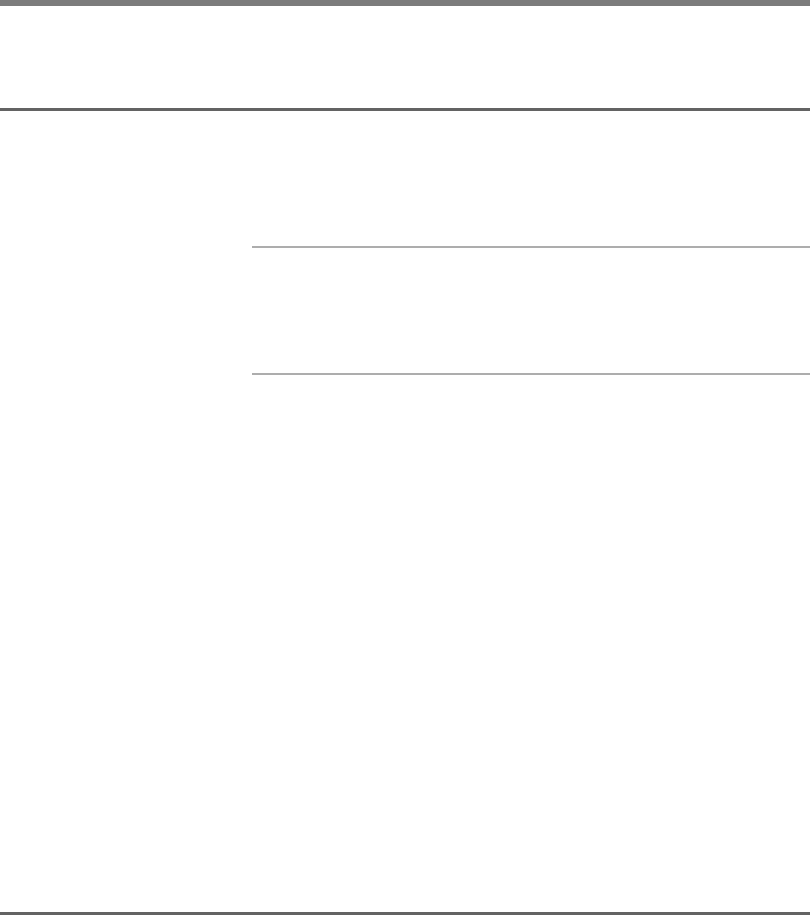
iX104C5 User’s Handbook 71
3Maintaining the Tablet
This chapter provides instructions for maintaining your tablet.
Caring for the tablet
This section provides information about how to keep your tablet in
top working condition.
Checking power cords and connectors
Check AC and DC power cords and power connectors periodically for
damage. Replace the power cord immediately if you find any damage.
Protecting the computer from damage
■Your computer is designed to sustain a multiple-axis drop to a
non-yielding surface. Do not intentionally drop the computer,
because the cumulative effects of multiple drops may damage the
computer.
■Do not place heavy objects on the computer.
■Do not disassemble the computer.
■Keep the computer at least 5 inches (13 centimeters) away from
any electrical appliance that generates a strong magnetic field,
such as a motor, magnet, TV, refrigerator, or large audio speakers.
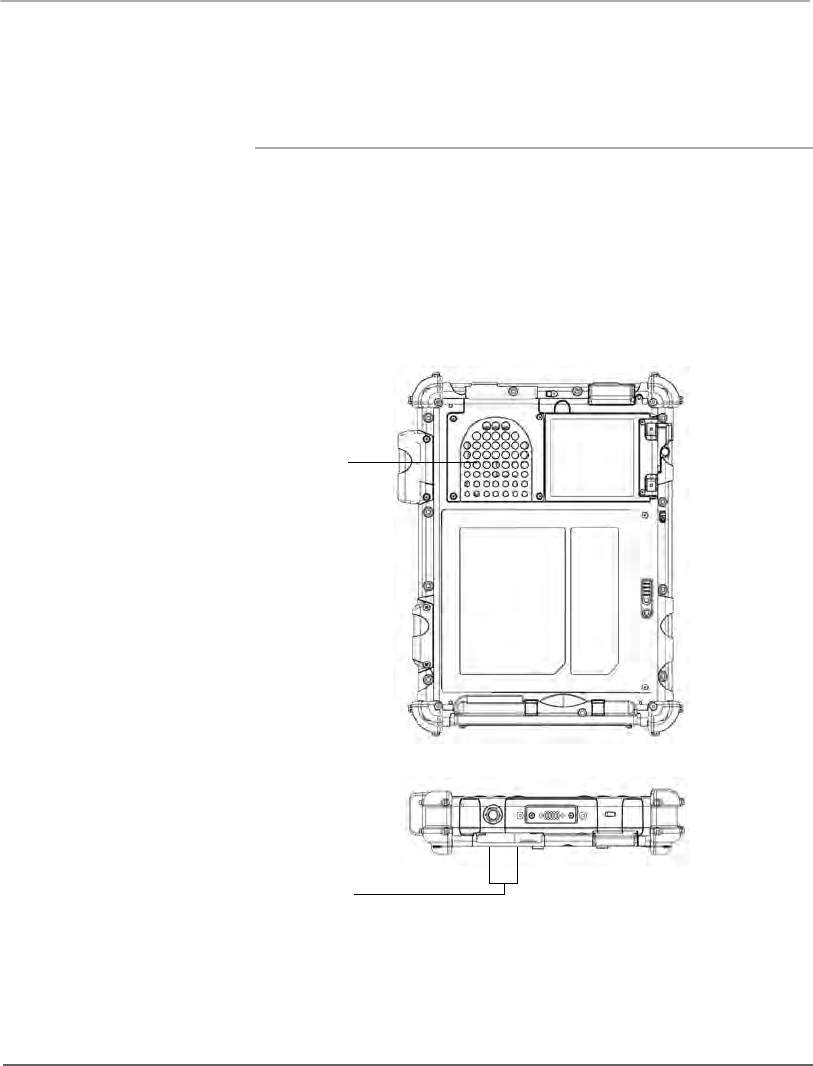
Chapter 3. Maintaining the Tablet
Caring for the tablet
72 iX104C5 User’s Handbook
Preventing the computer from overheating
The computer monitors its internal temperature. As the internal
temperature approaches the tolerable limits of heat-sensitive
components, system functions are automatically limited or turned off
to prevent damage.
To prevent the computer from overheating, do not obstruct the
computer’s air vents.
air vent
area
air vents

Chapter 3. Maintaining the Tablet
Caring for the tablet
iX104C5 User’s Handbook 73
Storing the computer
You can store the computer in the Off state for about 30 days with a
fully charged battery installed. After this period, recharge the battery
or replace it with a charged battery.
If you intend to store the computer for more than 30 days, remove the
battery pack and keep it in a cool place.
Caring for the display screen
To clean the display screen, dampen a soft cotton cloth with water
and gently wipe the screen surface.
Note: Do not use isopropyl alcohol to clean the screen. Alcohol
may damage the surface of the screen.
Protecting the display screen
The screen protector is a durable, replaceable writing surface that
protects the display screen from abrasion.
To obtain additional screen protectors, check with your reseller, or go
to the Xplore Web site at www.xploretech.com for ordering
information. Additional information about installation is included
with the screen protectors.
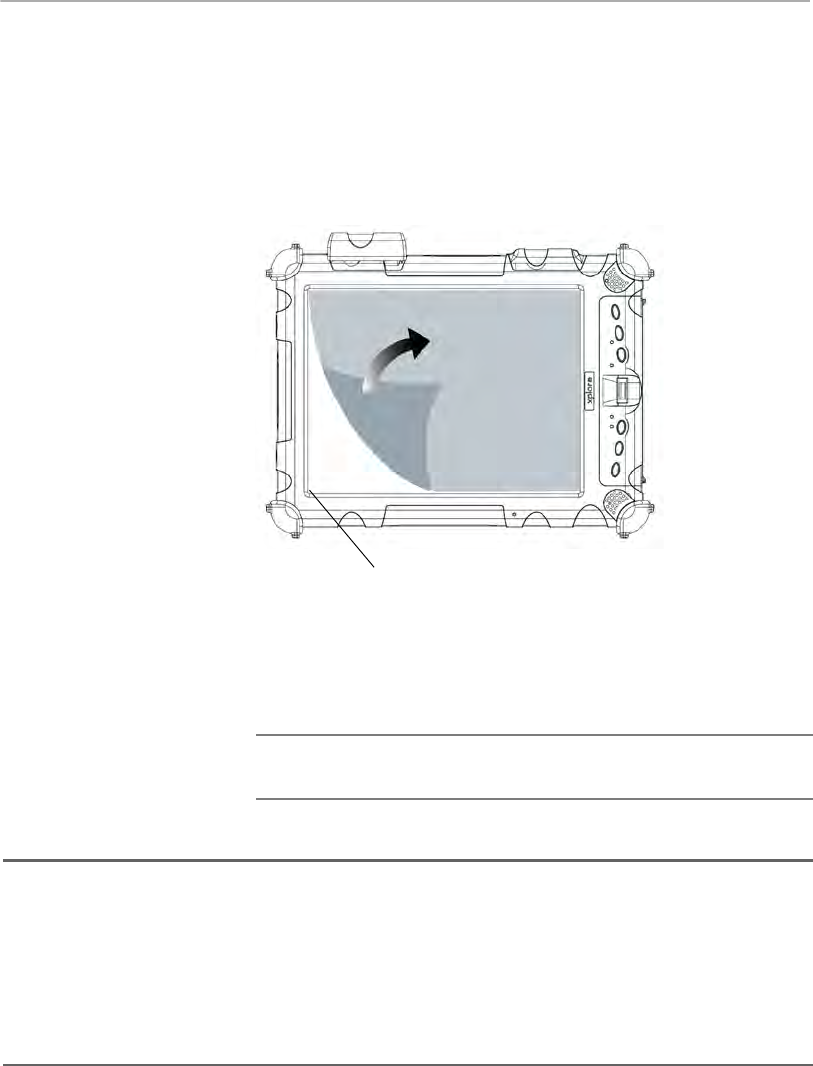
Chapter 3. Maintaining the Tablet
When to replace the pen
74 iX104C5 User’s Handbook
Removing the screen protector
Slide your fingernail under the edge of the screen protector and pull
the protector away from the screen.
Installing a new screen protector
Follow the instructions included with your screen protector
replacement kit.
Note: If a screen protector is already installed on the display
screen, remove it before installing the new screen protector.
When to replace the pen
With use, the pen tip may become worn and can scratch the screen.
If your pen exhibits one of the following problems, replace the pen:
■The pen does not move freely across the screen.
■The pen does not perform as expected.
edge
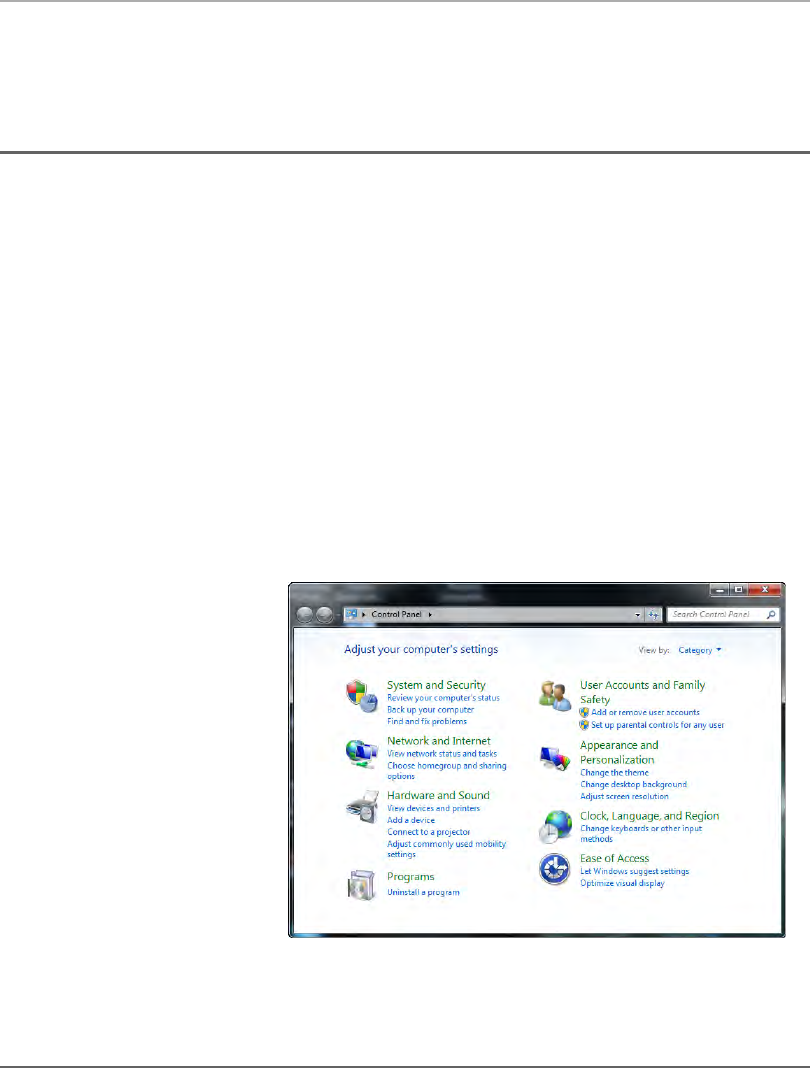
Chapter 3. Maintaining the Tablet
Calibrating the digitizer
iX104C5 User’s Handbook 75
Calibrating the digitizer
Calibrating the digitizer adjusts the cursor position on the screen
relative to the position of the pen tip or finger. Calibrate the digitizer
to adjust the distance error between where the pen or finger is actually
touching the screen and where the computer is registering the pen or
finger touch.
You may need to calibrate the digitizer in the following situations:
■You are using the computer for the first time.
■The previous user of the computer writes with the opposite hand or
at a different pen angle.
■The computer has not been used for some time.
■The computer has been serviced.
1. From the Start menu, select Control Panel.
The Control Panel opens.
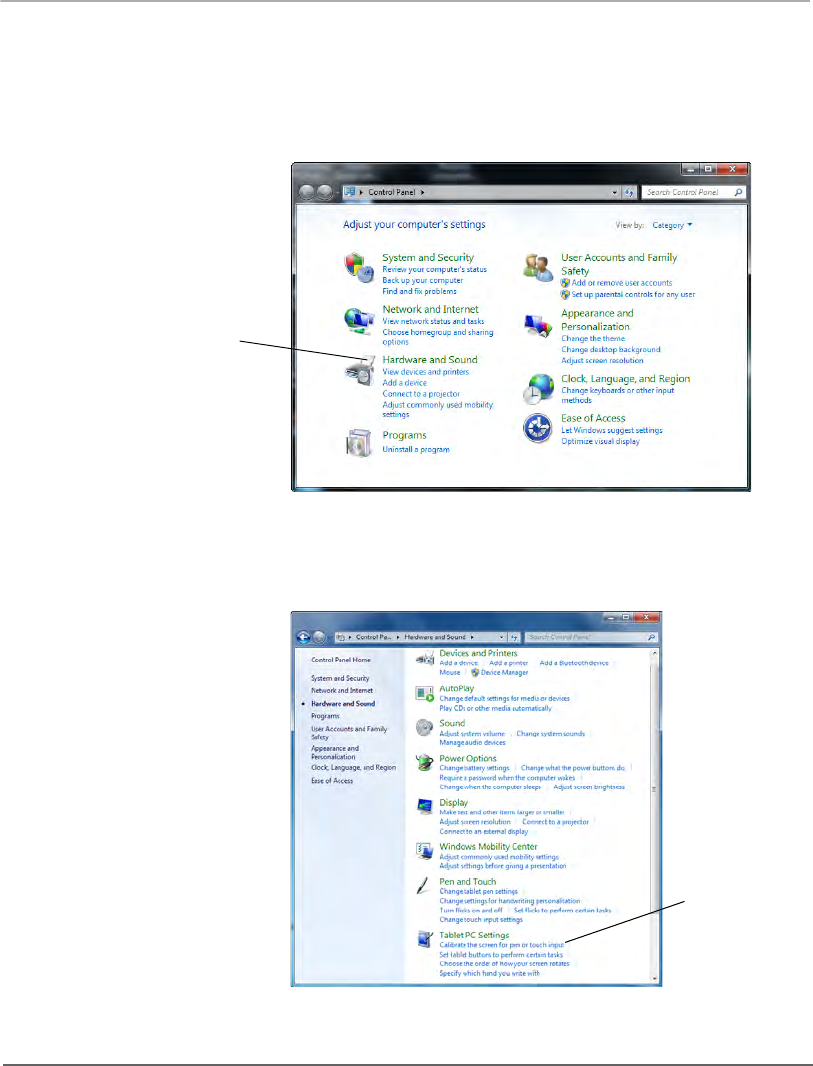
Chapter 3. Maintaining the Tablet
Calibrating the digitizer
76 iX104C5 User’s Handbook
2. Select Hardware and Sound.
3. In the Tablet PC Settings area, select Calibrate the screen for pen
or touch input; then follow the instructions that appear on the
screen..
Hardware and Sound
Calibrate the
screen for pen
or touch input
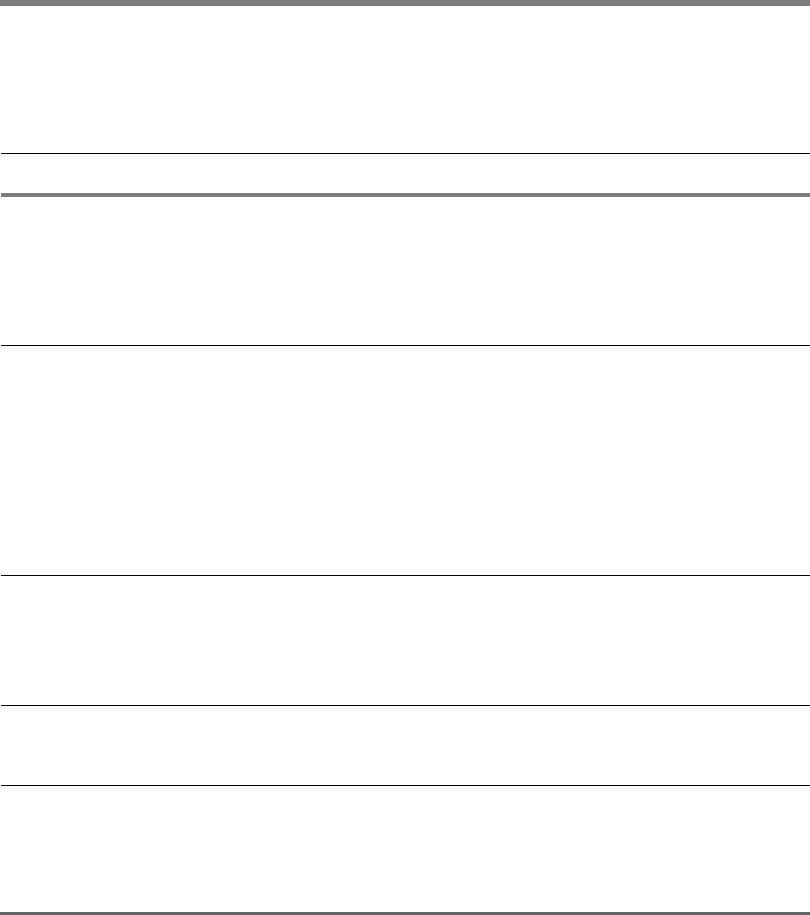
iX104C5 User’s Handbook 77
ATroubleshooting
Table 7 contains solutions to some problems. If you cannot solve the
problem by taking the actions described, contact your local help desk
or your reseller for further assistance.
Table 7 Troubleshooting
Problem Possible cause and solution
Computer will not start. • The battery may be defective or discharged to a critically low level.
Connect an external power supply (such as the AC adapter) or
install a charged battery. See “Using the battery” on page 48.
• Internal components may be above or below the acceptable
operating range (below -20° C or above 60° C). After the
temperature returns to safe operating range the computer will start.
The computer will not resume operation
after being suspended.
• The battery may be defective or discharged to a critically low level.
When the battery reaches a critically low level, the computer is
forced into Sleep mode to avoid a total system power failure.
Connect an external power supply (such as the AC adapter) or
install a charged battery. See “Using the battery” on page 48.
• The computer may be at the critical thermal limit. To avoid damage
to heat-sensitive components, the computer enters Sleep mode
when the computer operates above 60° C. Operation automatically
resumes when the computer cools to below 60° C. Move the
computer to a cooler location.
The Status LED is red, continuous. • The computer is on, running under battery power, and the charge
level in the battery has reached a critical level. Plug the computer
into an AC/DC power source or install a charged battery.
• The system has encountered a fault and is preventing normal
operation. Contact your local help desk.
The Status LED is red, blinking. The computer is powered on, running under battery power, and the
charge level in the battery is at a minimum warning level. Plug the
computer into an AC/DC power source or install a charged battery.

Appendix A. Troubleshooting
78 iX104C5 User’s Handbook
Display screen is blank or difficult to
read.
• Confirm that the computer is on (the Power icon is displayed
continuously in the Status area).
• The brightness may be set too low, causing the screen to appear too
dark. To change system brightness, press the Fn and Start keys to
open the Xplore menu and adjust the brightness. (See page 27.)
• An external monitor may be selected. Press the Fn and P1 keys to
select the computer display screen. (See page 27.)
• The video time-out may have expired. Tap the display screen to
reactivate the display.
Note: This is a normal, power-saving feature.
• If the Status light is blinking red, the computer is in Sleep mode
because the temperature is below -20° C or above 60° C. When the
temperature returns to a safe operating range, the display screen
automatically comes back on. If possible, move the computer to a
warmer or cooler location.
• If the Status light is continually yellow, the computer is in Sleep or
Hibernate mode. Press the Power On/Off key to resume.
Cursor is not tracking the pen. Calibrate the pen. See “Calibrating the digitizer” on page 75.
Computer is not responding to the pen. Connect an external USB keyboard to the computer. If the computer
does not respond to the external keyboard, the application or
operating system may have been corrupted. Press the Reset key.
(See page 30.) If the system responds to a keyboard but not to the
pen, contact your local help desk or reseller for further assistance.
Headphone or speaker volume is too
low.
• The volume may be in Mute mode or set too low. Follow the
instructions in “Adjusting headphone or speaker volume” on
page 45.
• Make sure the volume control in your audio software is set to an
audible level.
An external device is not working with
the computer.
The device may need to be enabled in the computer’s configuration
program (BIOS Setup). Contact your local help desk or reseller.
Table 7 Troubleshooting (continued)
Problem Possible cause and solution
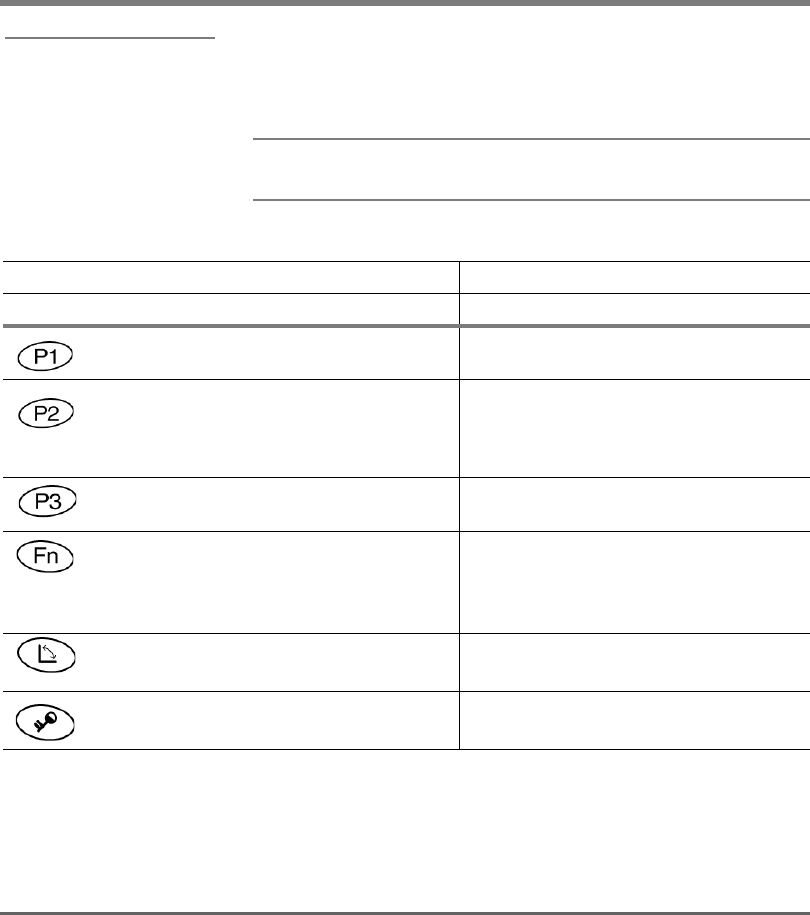
iX104C5 User’s Handbook 79
BUsing BIOS and AOS Functions
This appendix explains how to use the application and navigation
buttons with the Basic Input-Output System (BIOS) program and the
Advanced Operating System (AOS) Options menu.
Note: These functions are typically for use only by your system
administrator or by authorized service technicians.
Note: Each button has its
own blue-light LED. No
matter which button you
press, every blue-light LED is
on for about 3 seconds, then
off. When in Shifted mode, all
blue-light LEDs flicker.
Table 8 Using BIOS and AOS functions
In Shifted Mode
Button BIOS Key Function BIOS Key Function
F1 F1 continues message. Up Arrow Navigate up through Multi Boot
options and BIOS menus.
F2 Start the BIOS program: When the
computer is booting, press the P2
button and follow the instructions
that appear on the screen.
Down Arrow Navigate down through Multi
Boot options and BIOS menus.
F8 Prompt Windows to select Safe
mode.
Right Arrow Navigate to the right.
F11
(Lock Fn)
• Press for less than one second for
F11 function.
• Press longer to enable Shifted
mode.
Release
Function
Press once to exit Shifted mode.
F12 Enter Multi Boot mode. F4 Change a BIOS setup value.
Ctrl+Alt+Del Reboot. Enter Enter.

Appendix B. Using BIOS and AOS Functions
Disabling the Auto Power feature
80 iX104C5 User’s Handbook
Disabling the Auto Power feature
When Auto Power is enabled, the tablet automatically turns on if you
dock it and the following conditions exist:
■The tablet is off or in Hibernation or Sleep mode.
■The dock or the tablet is connected to an external power source
(including power applied when a vehicle’s ignition is started).
If you dock the tablet and the tablet is off and no power is present, the
tablet turns on as soon as power is applied.
To disable the Auto Power feature:
1. When the computer is booting, press the P2 button to access the
BIOS Setup Utility.
2. Select the Advanced tab.
3. Disable the Dock with Auto Power On option.
Enabling automatic LCD backlight control
When the LCD backlight control is in manual mode, the ambient light
sensor is disabled and the computer does not automatically control the
screen brightness.
Follow these steps to enable automatic LCD backlight control:
1. When the computer is booting, press the P2 button to start the
BIOS Setup Utility.
2. Select the Main tab.
3. In the LCD Backlight Control drop-down list, select Automatic.
4. Click OK.
Note: When the tablet is in
the docking station, it will shut
down or go into Hibernation
or Sleep mode the same as it
does when not in the docking
station.

iX104C5 User’s Handbook 81
CGlossary
Adapter. A device that provides an interface between two dissimilar
electronic devices. For example, the AC adapter modifies the power
from a wall outlet for use by the computer.
Advanced Power Management (APM). A facility consisting of one
or more layers of software that support power management. The APM
software interface enables applications, operating systems, device
drivers, and the APM BIOS to work together to reduce power
consumption.
Alternating Current (AC). Electric current that reverses its direction
of flow at regular intervals.
Analog signal. A signal with characteristics such as amplitude and
frequency that vary in proportion to (are an analog of) the value to be
transmitted. Voice communications are analog signals.
Application. A program that performs specific tasks on your
computer, such as word processing or creating spreadsheets.
BIOS. Programs that contain such basic hardware operations as an
interaction with diskette drives, hard disk drives, and the memory.
Board. A circuit board. An internal card containing electronic
components called chips, which perform a specific function or
increase the capabilities of the system.
Boot. To load a program or operating system into system memory.
Bits Per Second (BPS). In serial transmission, the instantaneous bit
speed with which a device or channel transmits a character.
Card. Synonym for board; see board.
Compact Disk-Read Only Memory (CD-ROM). Stores data on
metal-plated plastic discs.

Appendix C. Glossary
82 iX104C5 User’s Handbook
Compatibility. 1.The ability of one computer to accept and process
data in the same method as another computer without modifying the
data or the media upon which it is being transferred. 2.The ability of
one device to connect or communicate with another system or
component.
Configuration. The specific combination of hardware components of
the computer, and their operating status. The configuration of your
computer includes pre-defined memory, type and speed of
microprocessor, type of and size of hard disk drive, etc.
Default. The preset parameter value automatically selected by the
computer when you or a program do not provide instructions.
Device driver. A program that controls communication between a
specific peripheral device (such as a printer or the pen/stylus) and the
computer.
Disk drive. The physical device that enables the computer to read
from, and write to, a disk.
Display. An image-producing device used to view computer output.
Double-click. To press and release the pen/stylus twice within a time
frame you define, without moving the pointer off the choice.
Hardware. The physical electronic and mechanical components of a
computer system. typically, the computer itself, CPU, memory, etc.
Hertz. A unit of wave frequency that equals one cycle per second.
Interface. 1. Hardware and/or software components used specifically
to connect one computer or device to another. 2. To physically
connect one system or device to another to exchange information. 3.
The point of contact between user, the computer, and the program (for
example, the pen/stylus or a menu).
JBOD. Two drives that appear in Window as two drives, Drive C and
Drive D.

Appendix C. Glossary
iX104C5 User’s Handbook 83
Kilobyte (KB). A unit of 1024 bytes measuring storage space,
typically in memory or on storage media such as a diskette or hard
disk drive.
Local area network (LAN). Assembly of separate computers into an
integrated network that connects the various computers together and
to common devices such as printers and fax machines.
Light Emitting Diode (LED). A semiconductor device that emits
light when a current is applied.
Liquid Crystal Display (LCD). liquid crystal sealed between two
sheets of glass coated with transparent conducting material. Applying
a voltage between the glass sheets darkens the liquid crystal to
provide contrast to lighted portions of the display.
Megabyte (MB). A unit of data storage equal to 1024 kilobytes.
Megahertz (MHz). a unit of wave frequency that equals 1 million
cycles per second.
Modem. A device that connects your computer to a telephone line,
allowing it to communicate with another computer at another
location.
Pen. See stylus.
Peripheral device. An input/output device that is external to the
central processor and/or main memory such as a printer or scanner.
Pixel. Picture elements (tiny dots) that compose a screen image.
Port. The electrical connection through which the computer sends
and receives data to and from devices or other computers.
Program. A set of instructions a computer can execute to tell the
system what to do and how to do it.
RAID 0. Two drives appear in Windows as one larger drive (two
80GB drives appear as one 160GB drive).

Appendix C. Glossary
84 iX104C5 User’s Handbook
RAID 1. One drive has information mirrored to a duplicate drive. For
example, information from one 80GB drive is mirrored to another
80GB drive. The two drives appear in Windows as a single drive.
Random Access Memory (RAM). A hardware component of your
computer that temporarily stores active program code and data.
Reset. The act of hard stopping/shutting down the operating system.
Resolution. The number of pixels displayed on the screen. A higher
resolution provides greater clarity and allows more information to be
displayed on the screen at once.
Restart. Resetting a computer without turning it off (also called
warm boot or soft reset).
Resume. The act of returning the computer to an active, operational
state.
Read Only Memory (ROM). The portion of your computer’s
memory that contains permanent instructions, and which cannot be
modified.
Sleep mode. A power conservation mode in which electrical current
is removed from most components of the computer.
Solid State Drive (SSD). A sealed mass storage device used for
storage and fast retrieval of programs and data. The SSD is contained
in a drive cartridge for easy removal.
Status Indicator (LED). a light above the LCD screen which
indicates the current status of a particular device or hardware
component.
Stylus. A writing instrument. For pen computers, the stylus is used to
interface with the LCD and digitizer.

Appendix C. Glossary
iX104C5 User’s Handbook 85
Subscriber Identity Module (SIM). A smart card inside a GSM
(Global System for Mobile communications) cellular device that
encrypts voice and data transmissions and stores data about the
specific user so that the user can be identified and authenticated by
the network supplying the phone service. A SIM can be moved from
one device to another and/or different SIMS can be inserted into any
GSM radio.
Universal Serial Bus (USB). A serial interface that enables
communication between devices and the computer.

86 iX104C5 User’s Handbook
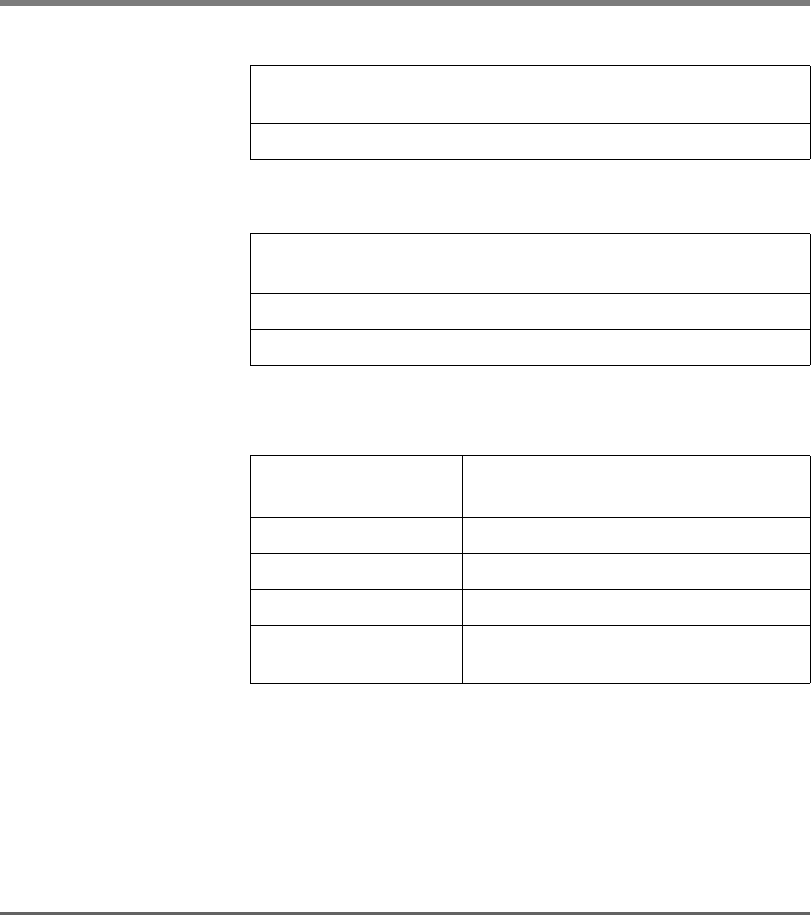
iX104C5 User’s Handbook 87
DHardware Specifications
* Varies according to your computer’s configuration.
* Varies according to your computer’s configuration.
Physical
Dimensions 11.20” x 8.25” x 1.6” (WxHxD)
283.9mm x 209.3mm x 40.8mm
Weight 5.25 lbs. (2.38 kgs)*
Processing
CPU Intel® i7® Core 620UE processor – Ultra Low
Voltage
Chip set Intel QM57
Processor speed 1.06 GHz*
Memory/storage
Main RAM • 1GB – 8GB DDR III RAM (2GB standard)
• 144-pin SODIMM modules
RAM options 2GB, 4 GB, 8GB DDR III (optional)
L2 Cache 4MB smart cache
BIOS ROM 8Mbit (FWH)
Storage 40GB SSD, or 80GB SSD, single or dual for
RAID 0/1 and JBOD support

Appendix D. Hardware Specifications
88 iX104C5 User’s Handbook
Display
Display • Color LCD
• Active Digital Sensor and Pen (iX104C5
and
Resistive Touch Panel (iX104C5 Dual Mode)
• 32-bit True color
• 10.4” TFT XGA (1024x768), 16M colors
• Brightness: 100 levels (min.)
• Viewing Angle:
- Horizontal: 30 degrees (min.)
- Vertical: 10 degrees (min.)
- Contrast Ratio: Typ. 600:1, Min 100:1
VRAM Intel i7 delivers low-power, hgh-performance 3D/2D
graphics, video, and display capabilities, Intel HD
graphics with Dynamic Frequency delivers graphics
performance boost to graphics-intensive
applications.

Appendix D. Hardware Specifications
iX104C5 User’s Handbook 89
Interface
Wireless Radio Bays • One full mini-PCI Express slot for WWAN
(3G)
• One half mini-PCI Express slot for WiFi
Integrated Interfaces • DC-in
• USB (2) 2.0
• Microphone Jack
• Headset Jack
•LAN (RJ-45)
• 9-pin serial port)
or
optional 15-pin D-SUB connector for external
VGA monitor
KeyPad / User Controls • Application buttons with primary and
secondary functions
• Power On/Off/Suspend/Resume button
• Emergency Shutoff/Reset button
Audio • Realtec ACC 262
• On-board microphone with noise cancellation
• On-board integrated stereo speakers (1W
each)
Status Indicators Power, Charge/DC-in, Warning

Appendix D. Hardware Specifications
90 iX104C5 User’s Handbook
Power
Main Battery • 10 cell 11-01019
• Removable Lithium Ion
• 7.4V @ 9250mAh (68.5 Whr)
• Warm-swappable
• Recharge time: 2.5 hours (100%)
• Life: Up to 6.5 hours. (Battery life is dependent on operating
system, power management, and applications in use.)
• Suspend life: Min. 6 days
• Off state: Approximately 90 days
Optional Spare Battery • 8 cell, 11-01018
• Removable Lithium Ion
• 7.4C @ 7600mAh (55 Whr)
• Warm-swappable
• Recharge time: 2.5 hours
• Life: Up to 4.5 hours. (Battery life is dependent on operating
system, power management, and applications in use.)
• Suspend life: Min. 5 days
• Off state: Approximately 30 days
• (IP65 only)
Bridge Battery • 6-cell Li Ion, 45mAh
• Life: (with Suspend-to-RAM on bridge battery only): 3 to 5
minutes from full charge
AC Adapter Auto-sensing 100-240V, supplying 19 VDC, with a current of
3.42 A

Appendix D. Hardware Specifications
iX104C5 User’s Handbook 91
Environmental
Temperature • Operating:
-7o to 140o F (-20o to 60o C) (iX104C5M minimum is -49o
F,-45o C)
• Storage:
-40o to 167o F (-40o to 75o C)
Humidity 0% to 95% non-condensing
Shock/Drop Four-foot drop to concrete, all surfaces, edges and corners
Vibration 0.04g^2/Hz, 20 Hz - 1000 Hz
-6dB/octave 1000 Hz - 2000 Hz
Enclosure Class Blowing rain:
4”/hr, 40 mph wind and
MIL-STD-810G Method 506.5 Procedure 1
Ingress protection:
IEC (60529) ingress tested to an IP67 standard
Sand and dust:
Particle size < 149 µm, 10 + 7 g/m3 particle density 1.5 m/s
to 8.9 m/s wind speed
MIL-STD-810G Method 506.5 Procedure 1
Salt Fog:
5% saline for 48 hr (12 hr wet, 12 hr dry, 2 cycles)
MIL-STD-810G Method 506.5
Contamination by fluids:
Detergents, brake fluid, aromatic hydrocarbons
MIL-STD-810G Method 506.5
Solar radiation:
1120 W/m2 (355 Btu/ft2/hr) UVB @ 50° C, 7x24 hr cycles
MIL-STD-810G Method 506.5

Appendix D. Hardware Specifications
92 iX104C5 User’s Handbook
Agency approvals
EMC • CFR 47, FCC part 15B, IC ICES-003
• European Union Directive 2004/108/EC RTT&E
Safety • TUV Bauart, RoHS, 2002/95/EC, WEEE
• IEC600950-1 2nd Ed., EN60950-1 2nd Ed.,
UL60950-1 2nd Ed.
• ETL Listed: ANSIISA-12.12.01-2007, C22.2 No. 213
• UL1604
Operating system
Operating Systems • Microsoft Windows 7 Professional – English,
32- and 64-bit
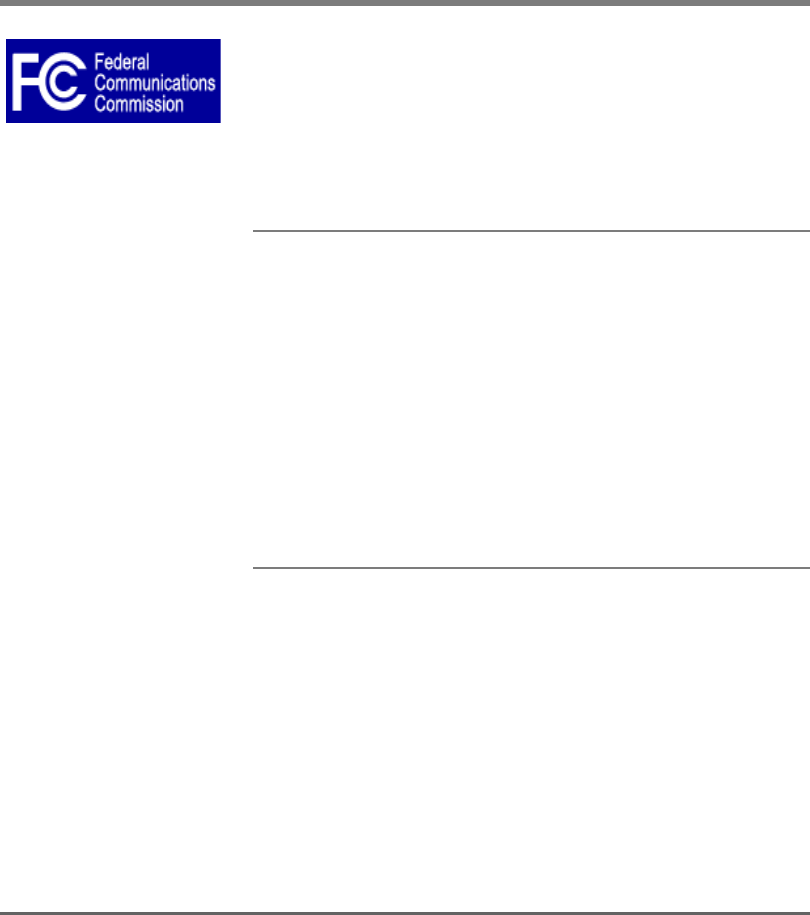
iX104C5 User’s Handbook 93
EAgency Notices
FCC notices
This device complies with Part 15 of the FCC Rules. Operation is subject to
the following two conditions: (1) this device may not cause harmful
interference, and (2) this device must accept any interference received,
including interference that may cause undesired operation.
Modifications not expressly approved by Xplore Technologies could void this
user’s authority to operate the equipment.
Note: This equipment has been tested and found to comply with the limits for
a Class B digital device, pursuant to Part 15 of the FCC Rules. These limits are
designed to provide reasonable protection against harmful interference in a
residential installation. This equipment generates, uses and can radiate radio
frequency energy and, if not installed and used in accordance with the
instructions, may cause harmful interference to radio communications.
However, there is no guarantee that interference will not occur in a particular
installation. If this equipment does cause harmful interference to radio or
television reception, which can be determined by turning the equipment off and
on, the user is encouraged to try to correct the interference by one or more of
the following measures:
- Reorient or relocate the receiving antenna.
- Increase the separation between the equipment and receiver.
- Connect the equipment into an outlet on a circuit different from
that to which the receiver is connected.
- Consult the dealer or an experienced radio/TV technician for help.
RF exposure
Tests for SAR are conducted using standard operating positions specified by
the FCC with the tablet PC transmitting at its highest certified power level in
all tested frequency bands. Although the SAR is determined at the highest
certified power level, the actual SAR level of the tablet PC while operating
can be well below the maximum value. This is because the tablet PC is
designed to operate at multiple power levels so as to use only the power
required to reach the network. In general, the closer you are to a wireless base
station antenna, the lower the power output.
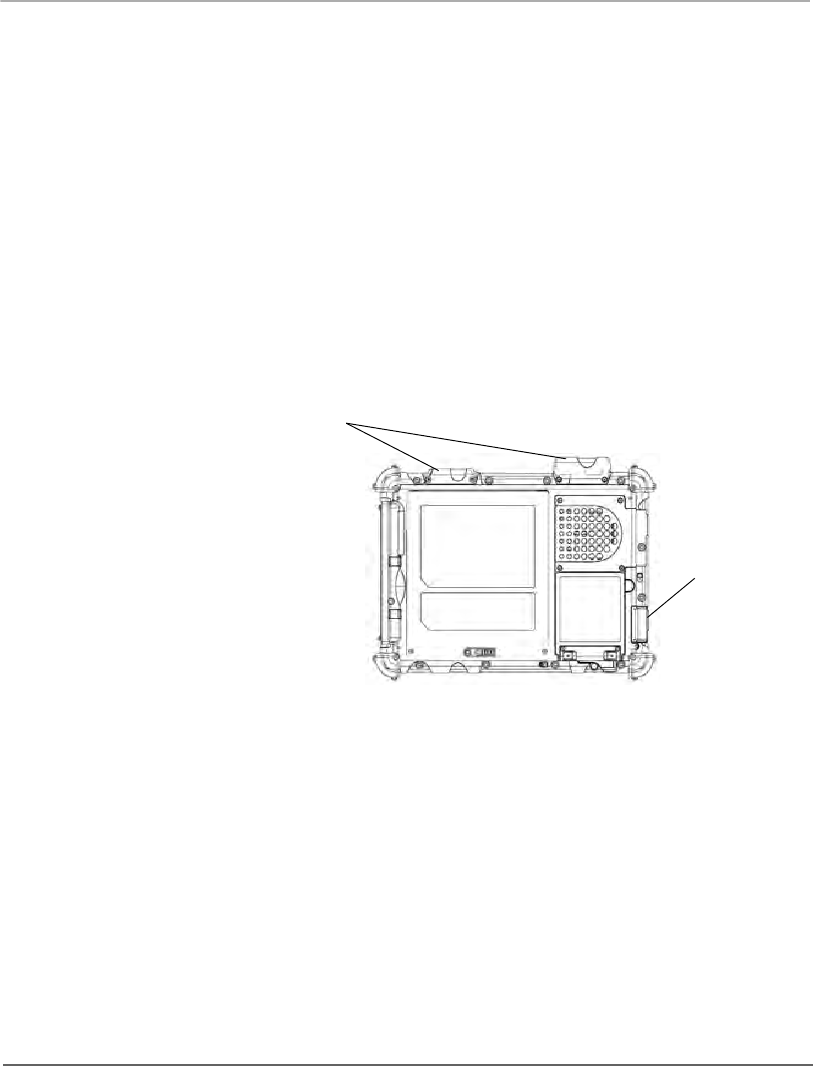
Appendix E. Agency Notices
94 iX104C5 User’s Handbook
Before a tablet PC model is available for sale to the public, it must be tested
and certified to the FCC that it does not exceed the limit established by the
government-adopted requirement for safe exposure. The tests are performed
in positions and locations (e.g., worn on the body) as required by the FCC for
each model. (Body-worn measurements may differ among tablet PC models,
depending upon available accessories and FCC requirements). While there
may be differences between the SAR levels of various tablet PCs and at
various positions, they all meet the government requirement for safe
exposure.
This device was evaluated and shown to comply with FCC SAR guidelines.
Avoid covering or holding antennas when transmitting. Antenna locations are
shown in the following figure.
Health and Safety Information
Exposure to Radio Frequency (RF) Signals
Your wireless tablet PC is a radio transmitter and receiver. It is designed and
manufactured not to exceed the emission limits for exposure to radio
frequency (RF) energy set by the Federal Communications Commission of
the U.S. Government as well as the RTT&E directive. These limits are part of
comprehensive guidelines and establish permitted levels of RF energy for the
general population. The guidelines are based on the safety standards
previously set by both U.S. and international standards bodies:
■American National Standards Institute (ANSI) IEEE. C95.1-1992
■National Council on Radiation Protection and Measurement (NCRP).
Report 86. 1986
Antennas
Bluetooth
antenna

Appendix E. Agency Notices
iX104C5 User’s Handbook 95
■International Commission on Non-Ionizing Radiation Protection
(ICNIRP) 1996
■Ministry of Health (Canada), Safety Code 6. The standards include a
substantial safety margin designed to assure the safety of all persons,
regardless of age and health.
■European Union RTT&E Directive for SAR
The exposure standard for wireless mobile tablet PCs employs a unit of
measurement known as the Specific Absorption Rate, or SAR. The SAR limit
set by the FCC is 1.6W/kg. The SAR limit set by the RTT&E is 2.0W/kg.
Note: In the U.S. and Canada, the SAR limit for mobile tablet PCs used by
the public is 1.6 watts/kg (W/kg) averaged over 1 gram of tissue. In Europe the
SAR limit for mobile table PCs used by the public is 2.0 watts/kg (W/kg)
averaged over 10 grams of tissue.The standard incorporates a substantial
margin of safety to give additional protection for the public and to account for
any variations.
DOC (Industry Canada Notices)
Notice to Users of Radio and Television
This Class B digital apparatus meets all requirements of Canadian
Interference-Causing Equipment Regulations per the ICES-003
CET appareil numérique de la class B respecte toutes les exigence du
Réglement sur le matérial brouilleur du Canada.
Notice to Users of the Canadian Telephone Network
Notice: This equipment meets the applicable Industry Canada Terminal
Equipment Technical Specifications. This is confirmed by the registration
number. The abbreviation, IC, before the registration number signifies that
registration was performed based on a Declaration of Conformity indicating that
Industry Canada technical specifications were met. It does not imply that
Industry Canada approved the equipment.
Before connecting this equipment to a telephone line the user should ensure
that it is permissible to connect this equipment to the local telecommunication
facilities. The user should be aware that compliance with the certification
standards does not prevent service degradation in some situations.
Repairs to telecommunication equipment should be made by a Canadian
authorized maintenance facility. Any repairs or alterations not expressly
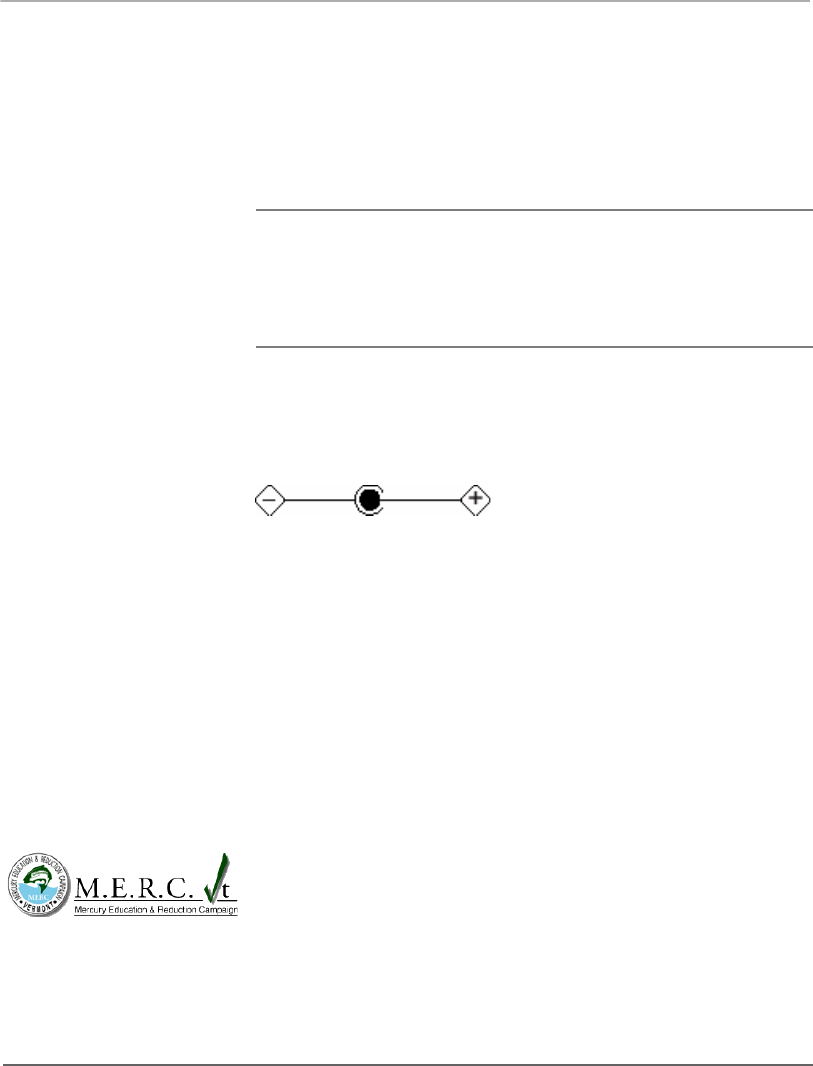
Appendix E. Agency Notices
96 iX104C5 User’s Handbook
approved by Xplore or any equipment failures may give the
telecommunication company cause to request the user to disconnect the
equipment from the telephone line.
Notice: The Ringer Equivalence Number (REN) for this terminal equipment is
0.0. The REN assigned to each terminal equipment provides an indication of
the maximum number of terminals allowed to be connected to a telephone
interface. The termination on an interface may consist of any combination of
devices subject only to the requirement that the sum of the Ringer Equivalence
Numbers of all the devices does not exceed five.
UL Notice
This unit requires an AC adapter to operate. Use only UL Listed
Class 2 Adapters with an output rating of 19 VDC, with a current of 3.75 A.
AC Adapter output polarity:
For authorized repair technicians only
WARNING
For continued protection against risk of fire, replace only with the same
type and rating fuse.
WARNING
Danger of explosion if Lithium (clock) battery is incorrectly replaced.
Replace only with the same equivalent type recommended by the
manufacturer. Dispose of used batteries according to the
manufacturer’s instruction.
System disposal
In the event of system disposal, observe the following information regarding
proper procedures in the State of Vermont.
The liquid crystal display (LCD) lamps used in this system contain mercury.
In the event of system disposal, be sure to follow local guidelines.
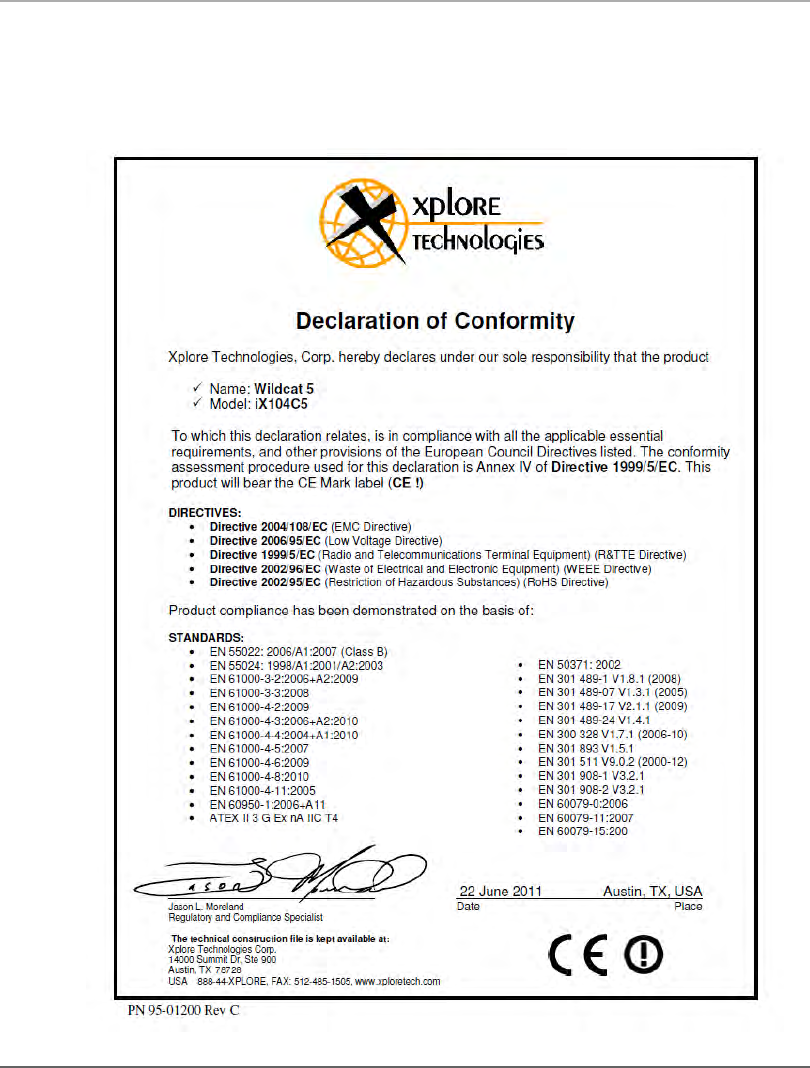
Appendix E. Agency Notices
iX104C5 User’s Handbook 97
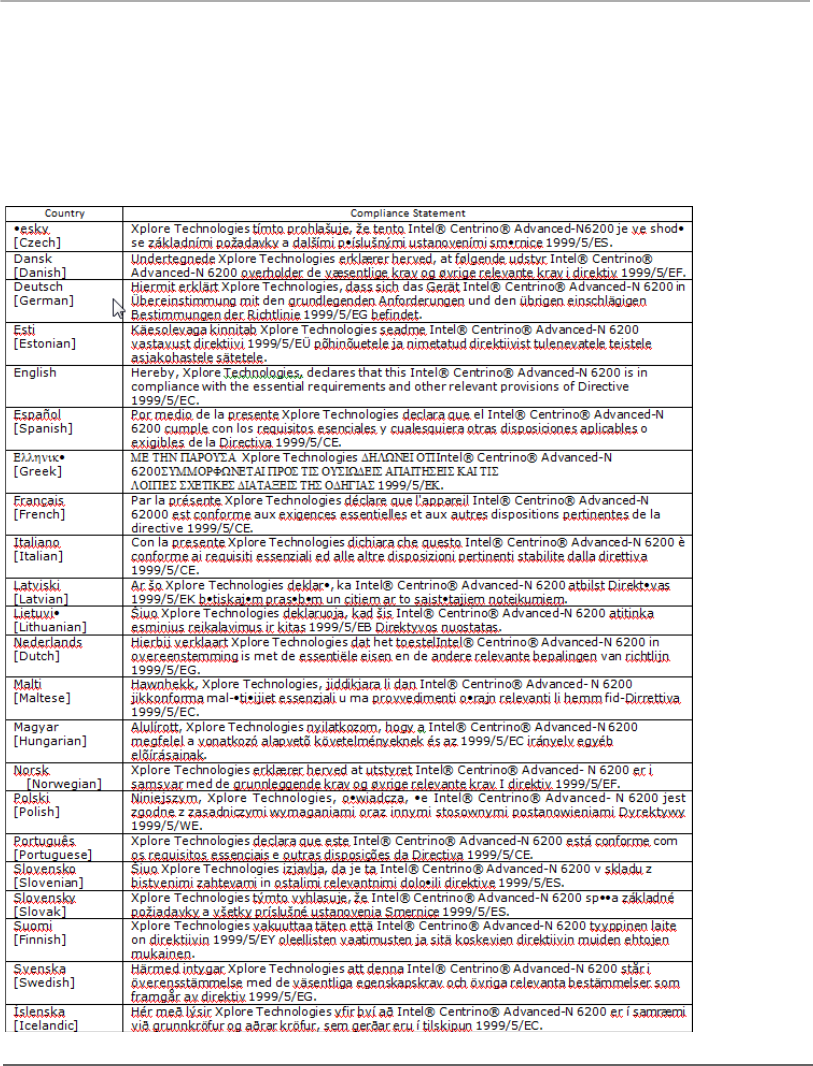
Appendix E. Agency Notices
98 iX104C5 User’s Handbook
Intel Advanced-N 6200 Country-specific Compliance Statements
Hereby, Xplore Technologies, declares that the Intel Advanced-N 6200 complies with the essential requirements
and other relevant provisions of Directive 1999/5/EC. This equipment is marked with the CE symbol and can be
used throughout the European community.
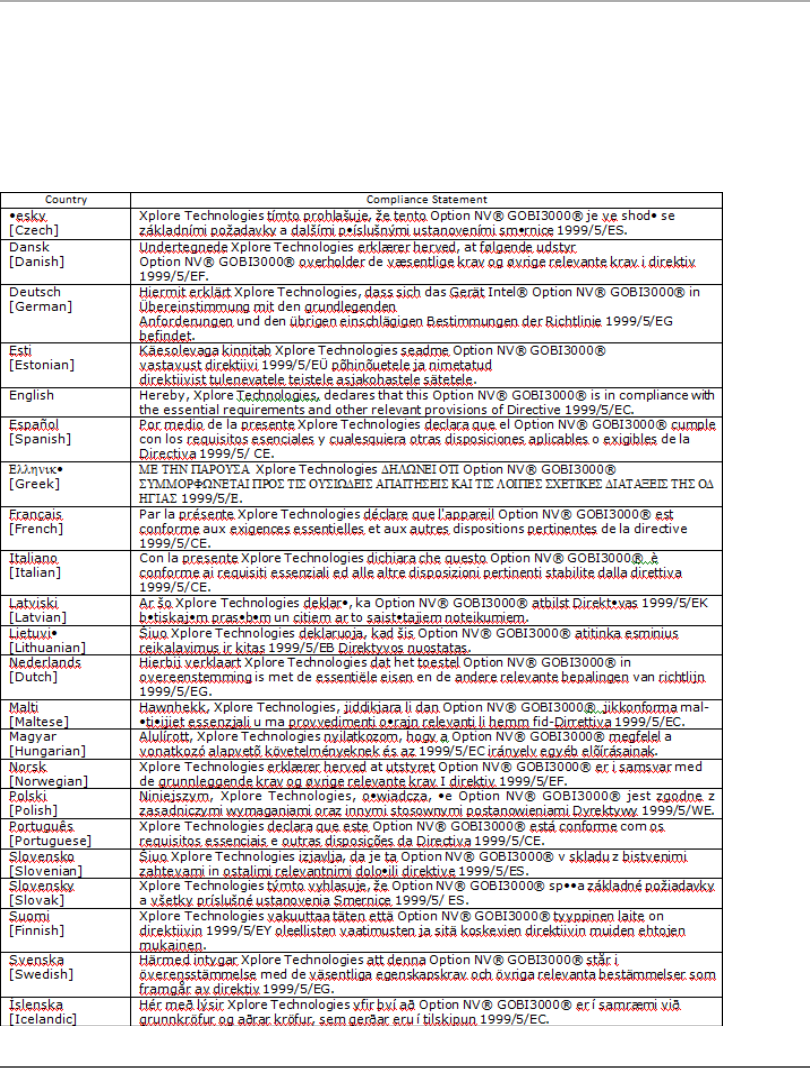
Appendix E. Agency Notices
iX104C5 User’s Handbook 99
Option NV GOBI3000 Country-specific Compliance Statements
Hereby, Xplore Technologies, declares that the Option NV GOBI3000 complies with the essential requirements
and other relevant provisions of Directive 1999/5/EC. This equipment is marked with the CE symbol and can be
used throughout the European community.
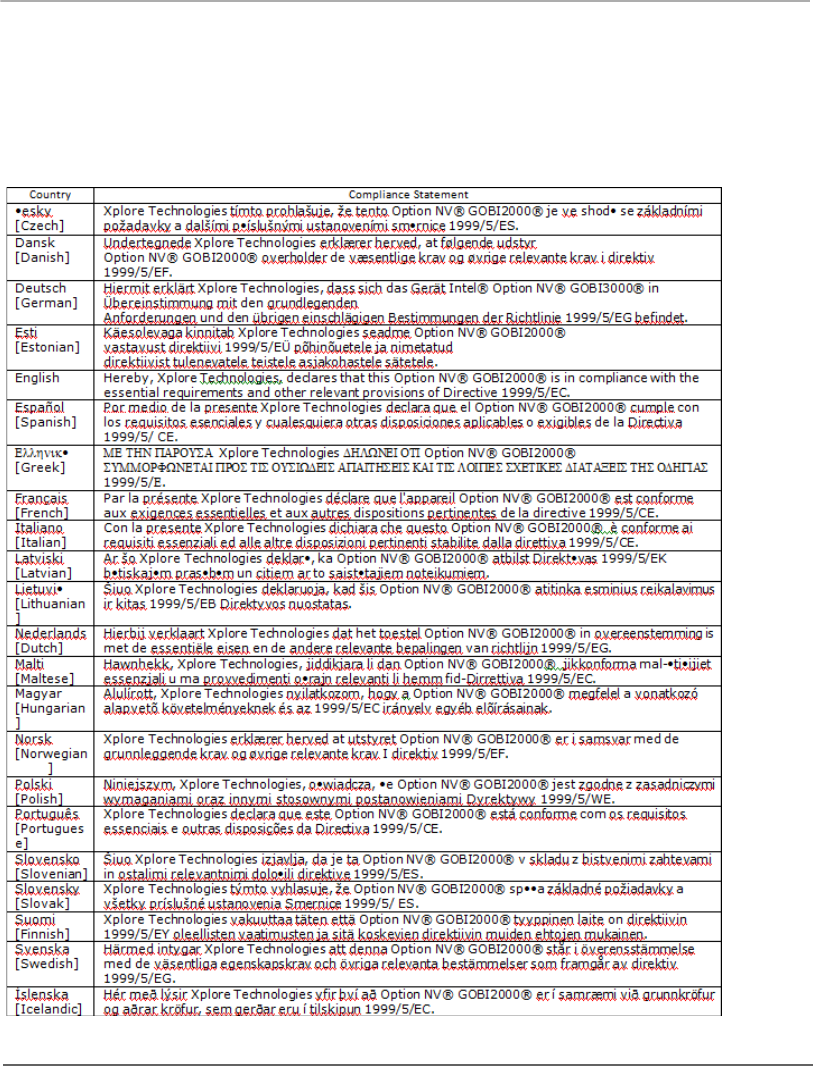
Appendix E. Agency Notices
100 iX104C5 User’s Handbook
Option NV GOBI2000 Country-specific Compliance Statements
Hereby, Xplore Technologies, declares that the Option NV GOBI2000 complies with the essential requirements
and other relevant provisions of Directive 1999/5/EC. This equipment is marked with the CE symbol and can be
used throughout the European community.
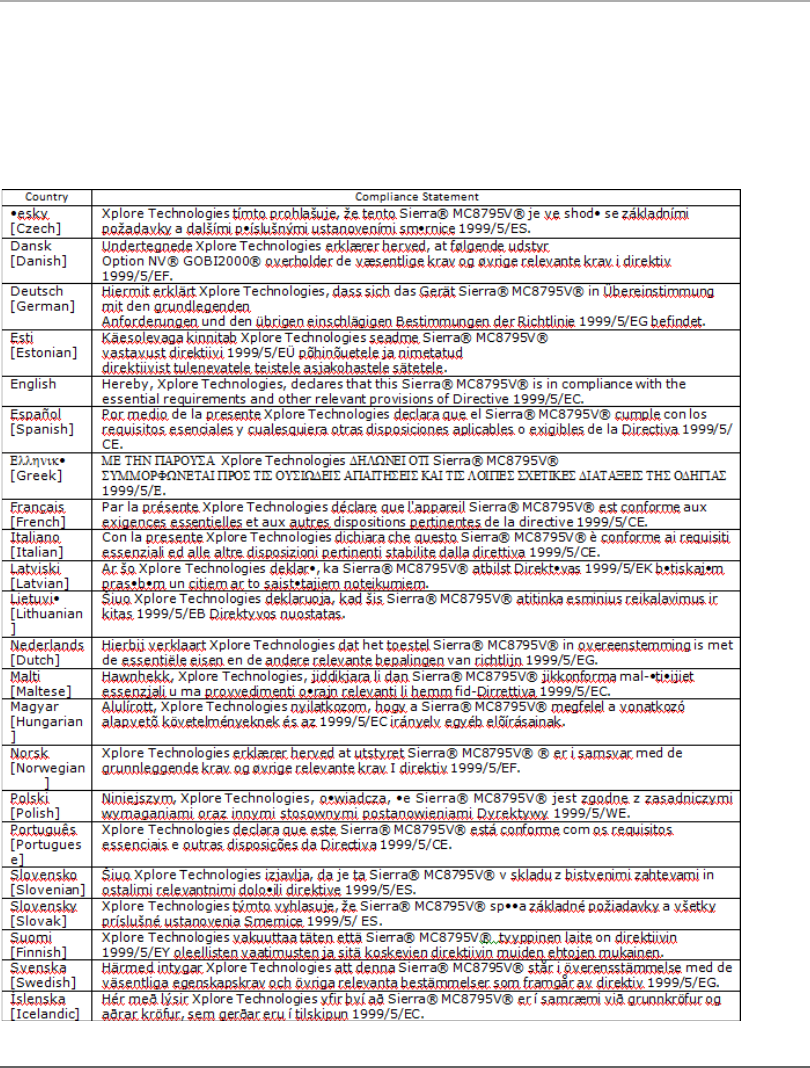
Appendix E. Agency Notices
iX104C5 User’s Handbook 101
Sierra MC8795V Country-specific Compliance Statements
Hereby, Xplore Technologies, declares that the Sierra MC8795V complies with the essential requirements and
other relevant provisions of Directive 1999/5/EC. This equipment is marked with the CE symbol and can be used
throughout the European community.
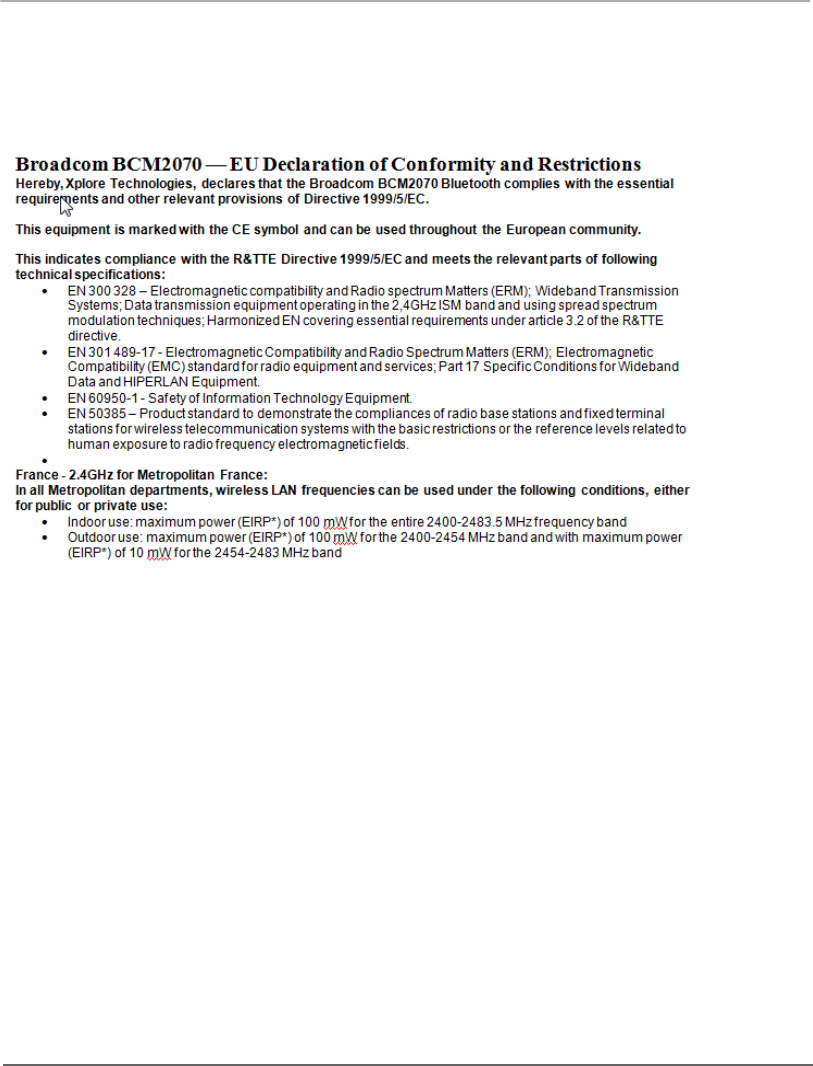
Appendix E. Agency Notices
102 iX104C5 User’s Handbook

iX104C5 User’s Handbook 103
Index
A
air flow vents, location 21
ambient light sensor, location 19
antenna covers, location 20
Auto Light sensor, disabling 41
Auto Power feature, disabling 80
B
battery pack
charge time 49
charging 48
checking the charge 48
conserving power 56
installing 51
location 20
removing 49
battery release latch, location 20
BIOS Setup Utility, using 79
C
convection air flow cover, location 20
D
digitizer
calibrating 75
using to perform mouse functions 35
double-click, performing with pen 35
dragging and dropping, performing with pen 35
H
headphone connector, location 22
headphone volume, adjusting 45
headphone, connecting 45
Hibernation mode, description 31
hot keys, programming 61
hot keys, programming, see keys, programming hot
keys
I
Internet Explorer, starting 27
iX104
accessories 15
preventing overheating 72
protecting from damage 71
storing 73
K
Kensington lock slot, location 21
keys
Ctrl-Alt-Del 27
description 27
Ctrl-Alt-Delete
location 26
descriptions 27
Function
description 27
location 26
Function mode hot key combinations
default functions 60
descriptions 27
P1
default function 60
location 26
P2
default function 60
description 27
location 26
P3
location 26
Power On/Off/Sleep/Resume
location 55

Index
104 iX104C5 User’s Handbook
programming hot keys 60, 61
to perform other key functions 67
to perform pre-defined functions 65
quick-start diagram 26
Screen Rotation
description 27
location 26
Secure Attention Sequence (SAS) 26
L
LAN connector, location 22
LCD backlight
disabling automatic control 41
enabling manual control 80
LEDs 24
Status LED meanings 24
left button click, performing with pen 35
local area network (LAN), connecting to 43
logging on 27
M
microphone
connecting external 44
connector location 22
location 19
volume, adjusting 44
monitor
activating 46
connecting 46
sending video display to 27
mouse functions, performing 35
P
pen
double-click speed, changing 35
dragging and dropping 35
holder, location 20
location 20
performing a double-click 35
performing a right-click 35
performing left button click 35
positioning in holder 36
replacing 74
tether, using 36
Power (On/Off)/Backlight (On/Off)/Sleep/Resume
key, location 55
power connector, location 22
Power On/Off/ Suspend/Resume key, location 21
power use, managing 52
projection panel
activating 46
connecting 46
sending video display to 27
Q
quick-start guide 26
R
Reset switch
location 19
using 30
resuming operation 33
right-click, performing with pen 35
RJ-45 connector 22
S
screen
landscape mode 27
portrait mode 27
protecting 73
screen orientation
changing 39
landscape 39
portrait 39
screen protector
installing 74
removing 74
replacing 74

Index
iX104C5 User’s Handbook 105
serial port
compatible devices 47
location 47
Sleep mode
ending 33
starting 32
Sleep mode, description 31
speaker volume, adjusting 45
speakers
connecting 45
location 19
storing the computer 73
support, contacting 17
suspending operation 32
T
troubleshooting 77
turning off the computer 30
turning on the computer 29
U
USB port, location 22
USB-compatible device, connecting 43
V
video output
changing from monitor to computer 46
changing to monitor 46
volume
adjusting headphone 45
adjusting microphone 44
adjusting speaker 45
W
Windows Task Manager, launching 27
X
XPL expansion module, connecting 47
XPL2 port 21, 23
Xplore Technologies, contacting 17

106 iX104C5 User’s Handbook

95-01097
Rev A